Direct Technical Assistance
DTA Spectrum of Support and Engagement
Direct Technical Assistance Updates
Direct Technical Assistance is a level 3 Intensive support that prioritizes Local Education Agencies that meet the criteria of three or more student groups not meeting two or more LCFF Priorities for 3 of 4 consecutive years.
The focus of Direct Technical Assistance is on building the school district’s capacity to develop and implement actions and services responsive to pupil and community needs pursuant to Section 52071, 52072, 52074 in a manner that streamlines improvement efforts for the school district.
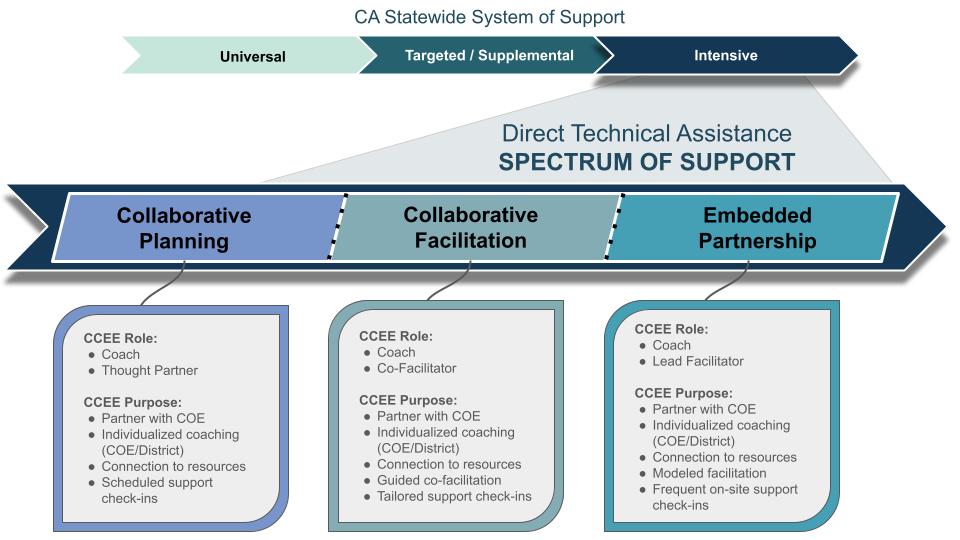
DTA Spectrum of Support and Engagement
The CCEE partners with Local Education Agencies (LEAs) and County Offices of Education (COEs) to provide Direct Technical Assistance in customized levels of depth and intensity. Our role is to advise and assist, as part of our theory of action, we work to build capacity and move toward a gradual release. CCEE can provide Direct Technical Assistance through such means as Collaborative Planning, Collaborative Facilitation, and Embedded Partnership, as shown above, that will best support the LEA or COE in meeting their goals. For more information about the supports mentioned above, please visit the CCEE website pages and the DTA Handout.
What Informs Our Work?
Our team utilizes research-based frameworks to guide our work, partnership and engagement with LEAs and COEs that have partnered with CCEE for Direct Technical Assistance. Our practices are grounded in Fullan & Quinn’s Coherence Framework and Institute for Healthcare Improvement quality improvement practices, as well as Center for Systems Awareness’ Compassionate Systems Framework to effectively build the capacity of LEAs to support all students’ academic and social-emotional well-being. Our experience through this work shapes the direct technical assistance (DTA) we now provide to LEAs across California.
DTA Approach
CCEE employs continuous improvement practices in its approach to providing Direct Technical Assistance. Continuous improvement is an ongoing effort to improve products, services or processes. These efforts can seek “incremental” improvement over time or “breakthrough” improvement all at once. Using Plan-Do-Study-Act we support LEAs and COEs in their improvement journeys as outlined in the image below.
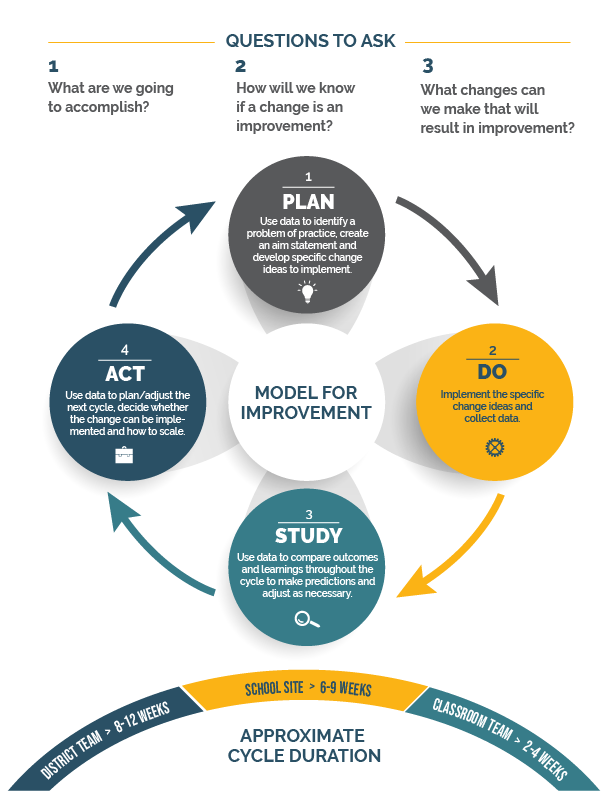
DTA Pathways
If a school district with three or more pupil groups, or all their pupil groups if less than three, in three out of four consecutive school years, meets the criteria established pursuant to subdivision (g) of Section 52064.5, the CCEE shall determine, in consultation with the school district and any provider of technical assistance pursuant to Section 52071, if assistance from the CCEE is necessary. When making this determination, primary consideration shall be given to the needs of the pupils in the school district.
52072(a) If a school district meets the criteria established pursuant to subdivision (g) of Section 52064.5 for three or more pupil subgroups identified pursuant to Section 52052 or, if the school district has less than three pupil subgroups, all of the school district’s pupil subgroups, in three out of four consecutive school years, the California Collaborative for Educational Excellence shall determine, in consultation with the school district and any provider of technical assistance pursuant to Section 52071, if assistance from the California Collaborative for Educational Excellence is necessary. When making this determination, primary consideration shall be given to the needs of the pupils in the school district.
The LEA consults and works with their COE and GEO Lead to determine if the advice and assistance of the CCEE is necessary.
52074(g)(1)(A) If the county superintendent of schools of the county in which the school district or charter school is located determines, following the provision of technical assistance pursuant to Section 52071 or 47607.3, as applicable, and the geographic lead agency of that county identified pursuant to Section 52073 agrees, that the advice and assistance of the California Collaborative for Educational Excellence is necessary to help the school district or charter school accomplish the goals described in the local control and accountability plan adopted pursuant to this article.
A Local Educational Agency (LEA) can automatically be referred to the CCEE for Direct Technical Assistance if the LEA is receiving an emergency apportionment (state loan) because it is fiscally insolvent.
Education Code 52074(g)(2)(A): If a school district receives an emergency apportionment pursuant to Article 2 (commencing with Section 41320) of Chapter 3 of Part 24 of Division 3, the school district shall be deemed to have been referred to the California Collaborative for Educational Excellence.
The Superintendent determines the advice and assistance of the CCEE is necessary to support an LEA.
Education Code 52074(g)(1)(B): If the Superintendent determines that the advice and assistance of the California Collaborative for Educational Excellence is necessary to help the school district, county superintendent of schools, or charter school accomplish the goals set forth in the local control and accountability plan adopted pursuant to this article.
DTA Reports
The CCEE provides Direct Technical Assistance (DTA) in 3 Levels of Support: Collaborative Planning, Collaborative Facilitation, and Embedded Partnership. You can find the DTA Reports below.
DTA Report Collaborative Planning Support Updates – January 2025
Direct Technical Assistance Updates
The CCEE provides Direct Technical Assistance in many forms. The following 7 Local Educational Agencies (LEAs) engaged with CCEE through a Systemic Instructional Review. Currently, these 6 LEAs are engaged in quality improvement cycles, and each is focused on improving their students’ outcomes. To view the updates of their improvement journey, select the + next to the LEA name for a drop down of their update reports.
Inglewood Unified School District
Inglewood USD is one of two districts referred to CCEE for assistance because of their budget status. In spring 2018 the State Administrator for Inglewood Unified School District (IUSD), requested the support of the CCEE in reviewing the district’s strategic plan and implementation strategies and to help develop stronger, collaborative governance processes. In October 2018, the state legislature passed statute AB 1840, which restructured the support mechanisms for districts with outstanding state loans. Inglewood had received a state loan in 2012 to avoid fiscal insolvency. For Inglewood, this resulted in the State Administrator reporting to the Los Angeles County Office of Education (LACOE) instead of the California Department of Education and automatically referred the district to the CCEE for technical assistance to support their instructional systems.
Under the Differentiated Assistance (DA) process under Education Code section 52071, IUSD met the criteria for assistance for the 2017 through 2019 school years whereby at least one student group met criteria in at least two different Local Control Funding Formula (LCFF) priority areas. The table below indicates the student groups performance in comparison to the average statewide performance for that student group for 2019 (the most recent year data are available).
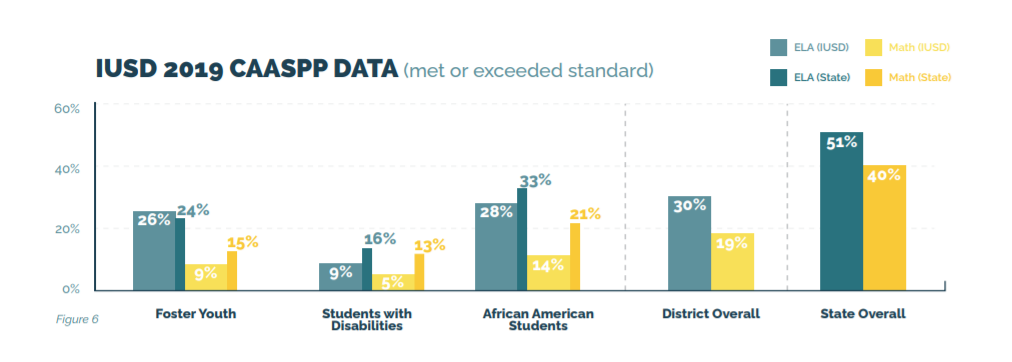
The graphic below shows the enrollment percentage of these student groups relative to the district’s entire student population.
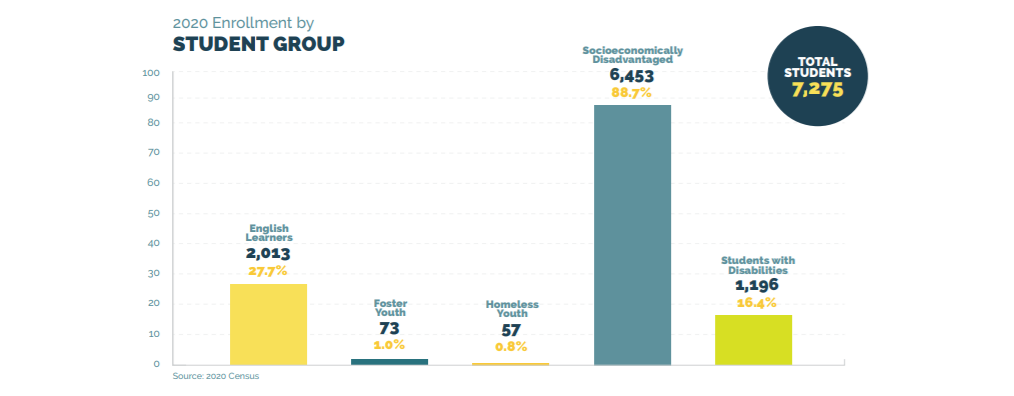
The district’s enrollment by student group shows the vast majority of students are socioeconomically disadvantaged learners, and nearly one-third are English Language Learners, as reported on the CA Dashboard.

SYSTEMIC INSTRUCTIONAL REVIEW THEMES
The IUSD Systemic Instructional Review Report was completed in late April 2019. Shortly after the completion of the IUSD SIR report, CCEE provided support to IUSD by aligning Fiscal Crisis and Management Team (FCMAT) pupil achievement actions to the SIR actions. Four themes emerged 1) culture, coherence, and systemness 2) curriculum, instruction, and assessment 3) accountability, and 4) professional learning.
PROGRESS UPDATE
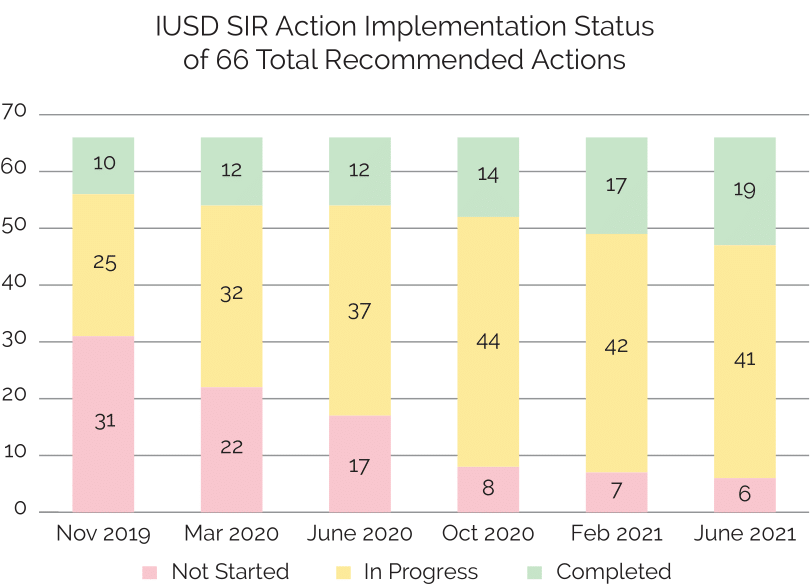
With the 66 total recommended actions for IUSD, the district has completed 19 of the recommended actions. IUSD is actively working to implement another 41 of the actions and has not yet started six of the actions. Overall, IUSD has completed or was actively working on 91% of the recommended actions over the last two years. CCEE conducted a progress monitoring quarterly update of IUSD in mid-June 2021. In this quarterly update, IUSD showed progress in the areas of use of cycles of inquiry at the central office and principal levels, supporting the continued focus on literacy resulting in increased alignment of ELA and math professional learning plans. In addition, schools are being held accountable by the Educational Services team regarding student assessments and have increased completion rates as evidenced by 85% of students completing the mid-year literacy assessments. During the pandemic, IUSD implemented revised instructional guides to support a focus on priority standards in ELA and math. This allowed for a continued focus on literacy and numeracy in alignment with the IUSD Strategic Plan and Local Control and Accountability Plan (LCAP). These concerted efforts resulted in 93% of students completing the 2021 Smarter Balanced Assessment virtually. In addition, approximately 85% of past due Individualized Educational Plans (IEPs) were completed showing a concerted effort to maintain compliance during the pandemic, but to prioritize access to services for the students with disabilities student group.
Weaknesses for IUSD vary based on the degree of implementation; for example, accountability structures exist but are loosely outlined. While being utilized in some areas, the cycle of inquiry is still seen as a compliance type of activity, and the learning taking place in professional development has not yet consistently been translated to systemic implementation of classroom practices across the district.
Areas of opportunity identified result from the IUSD community and Los Angeles County Office of Education leadership working together to address systems and structural needs in the district. IUSD’s areas of opportunity include utilizing the current IUSD cycle of inquiry to reinforce effective data practices, build a data-informed culture, and create self-accountability throughout IUSD. In addition, the building of capacity of the central office has been essential to improve the school support, especially as the implementation of effective instructional practices as every school site is accelerated in the coming year. CCEE’s support of these efforts will continue to be critical to ensure consistent and sustainable systems for improving pupil achievement.
A primary threat to the IUSD SIR action implementation is that IUSD is reaching a plateau in actions that are in progress. This is mainly due to the lack of clarity in an instructional plan that is grounded in the implementation of a multi-tiered approach to ensure quality instruction and intervention in academics, social-emotional, and attendance is in place. Additionally, IUSD must prioritize the development of a multi-tiered approach to support school principals and instructional leadership teams at every school site.
To further support sustainability and capacity building, CCEE has provided support to IUSD through ongoing coaching for the Executive Director, Elementary Director, English Learner Director, and the Instructional Coaches. Coaching conversations have included organizing for effort, developing professional learning, strategic planning and aligning curriculum, instruction, and assessment. CCEE professional experts have also provided support in the area of data analysis, cycles of inquiry, and establishing performance indicators. In the area of special education, CCEE staff have provided support and guidance in the areas of compliance to State and Federal requirements, alignment of curriculum, instruction, and assessment for students with disabilities, and reorganization.
Lastly, CCEE currently funds two full-time employees (FTEs), one Director for special education and one Director to support the analysis of data and equity. A new position, Director of Instructional Strategy and Continuous Improvement will be funded for the upcoming school year. This position will support IUSD in their implementation and progress monitoring of SIR and FCMAT actions to improve pupil achievement. LACOE also provides two FTEs to support data organization and analysis and a Director of Student Support Services to support the State Administrator. All of these positions work in collaboration with the IUSD leadership team to ensure capacity is built to further develop and sustain a strong foundation in curriculum, instruction, and assessment.
NEXT STEPS
CCEE has advised IUSD to focus on developing and implementing an instructional action plan grounded in the comprehensive Multi-Tiered System of Support (MTSS) framework and contains instructional expectations built on student graduate competencies and content standards, pupil achievement targets, and identifies instructional strategies for meeting the expectations and targets. Then, based on this instructional plan, develop a one-year professional development plan that provides professional learning at the school sites to address and provide support in the implementation of: multi-tiered systems of support for students and schools, and consistent utilization of cycles of inquiry, to inform the instructional coaches, ILTs, and principals in their roles to support and implement quality instruction.
BACKGROUND
In the spring of 2018, the State Administrator for Inglewood Unified School District (IUSD) requested support from the CCEE in reviewing the district’s strategic plan and the implementation strategies, and also to help develop stronger, collaborative governance processes. In October 2018, the state legislature passed statute AB 1840, which restructured the support mechanisms for districts with outstanding state loans. Inglewood had received a state loan in 2012 to avoid fiscal insolvency. For Inglewood, this resulted in the State Administrator reporting to the Los Angeles County Office of Education (LACOE) instead of the California Department of Education and automatically referred the district to the CCEE for technical assistance to support their instructional systems. This update will focus on providing updates on the latest improvement cycle from August 2022 to November 2022.
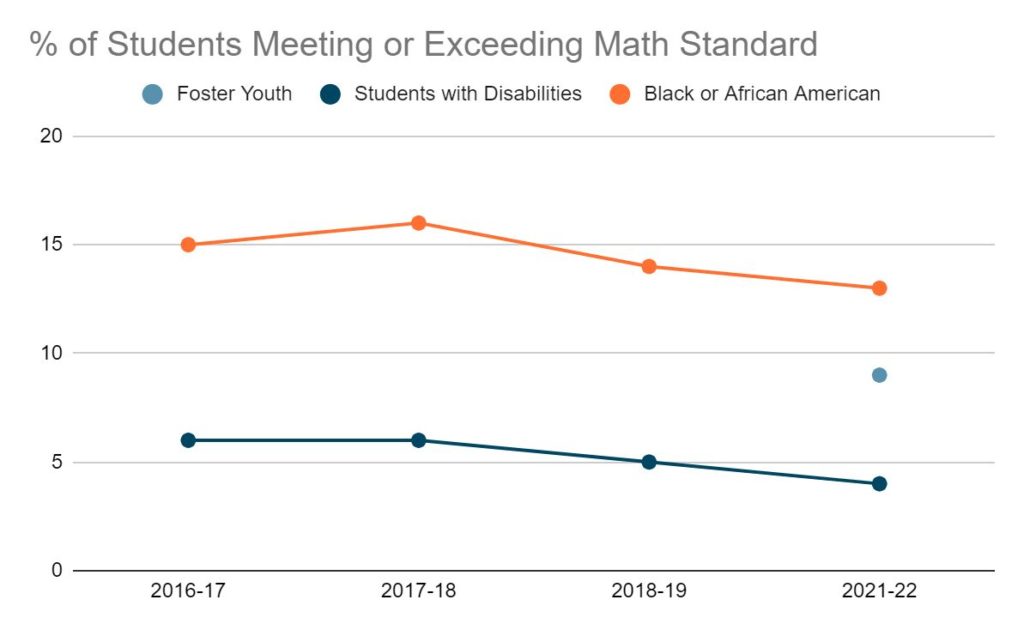 alt=”Student Meeting or Exceeding Math Standard” />
alt=”Student Meeting or Exceeding Math Standard” />
DISTRICT AREAS OF FOCUS
The SIR Actions are organized in the themes of Culture/Coherence/Systemness, Curriculum/
Instruction/Assessment, Accountability and Professional Learning. The team at CCEE is working with the district’s Education Services Department and Principal Team focusing on instructional walkthroughs utilizing the districts observation tool for measuring student engagement.
PROGRESS UPDATE
IUSD is actively working on implementing 10 of the SIR actions focused on instruction, walkthroughs, coaching and accountability. With the focus by the Education Services team on supporting principals with instructional walkthroughs, the data collected with the walkthrough tool is showing evidence of increased frequency of walkthroughs and increases in Principal/Teacher coaching sessions, and an increase in student engagement.
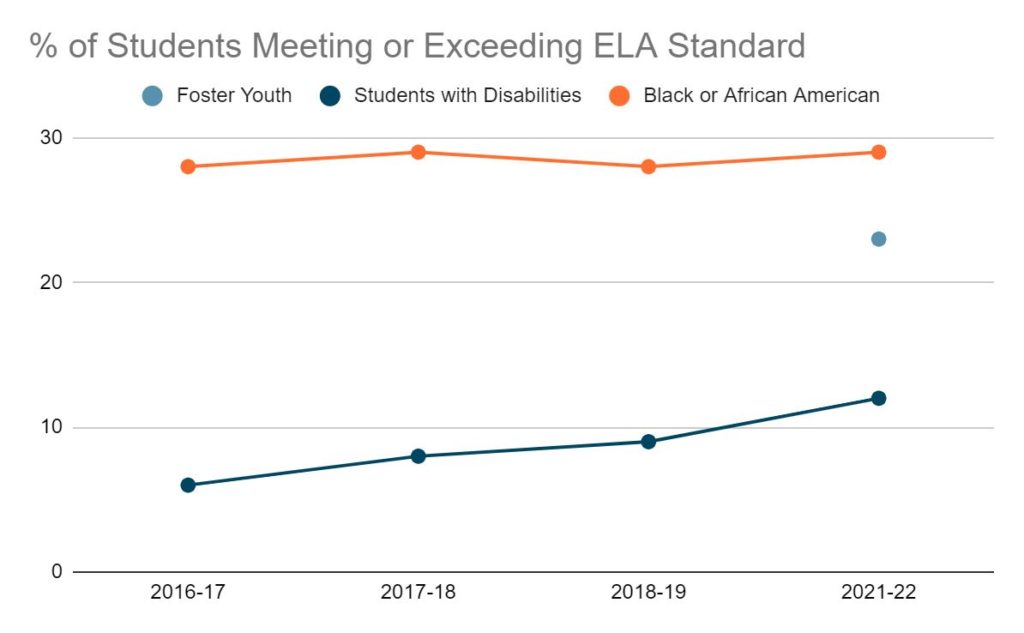
The Education Services Team with CCEE support and coaching is working with the Inglewood Principal Team in developing the group as a professional learning community. As they collectively walkthrough classrooms, they continue to calibrate on what they are seeing to build coherence across all schools.
For next steps, CCEE will continue to coach executive leadership and education services staff on facilitating the principal team as a professional learning committee during their meetings. The district will continue to convene the principals at different schools throughout the district to conduct walkthroughs, calibrate on what they observed, practice coaching conversations and then curate professional development for teachers based on system need.
BACKGROUND
In the spring of 2018, the State Administrator for Inglewood Unified School District (IUSD) requested support from the CCEE in reviewing the district’s strategic plan and the implementation strategies, and also to help develop stronger, collaborative governance processes. In October 2018, the state legislature passed statute AB 1840, which restructured the support mechanisms for districts with outstanding state loans. Inglewood had received a state loan in 2012 to avoid fiscal insolvency. For Inglewood, this resulted in the State Administrator reporting to the Los Angeles County Office of Education (LACOE) instead of the California Department of Education and automatically referred the district to the CCEE for technical assistance to support their instructional systems. This update will focus on providing updates on the latest improvement cycle from December 2022 to February 2023.
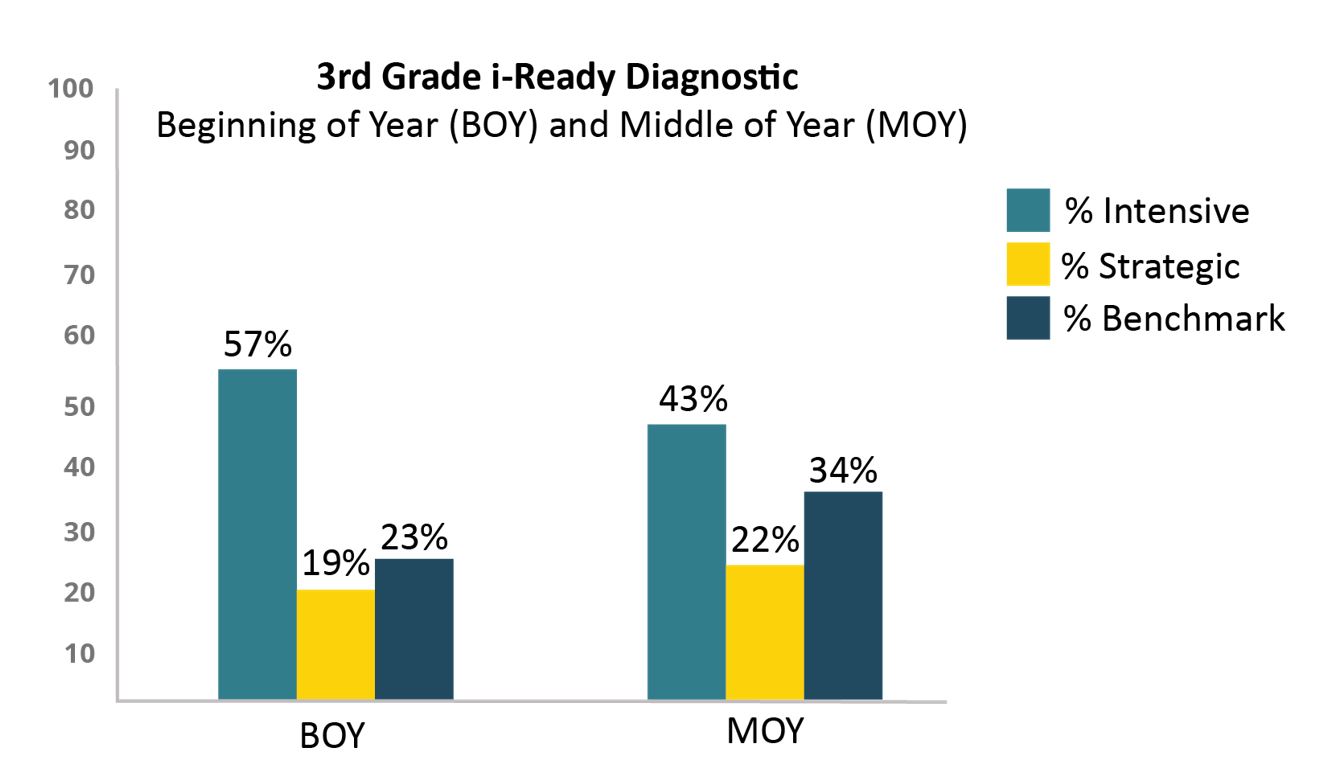
DISTRICT AREAS OF FOCUS
The SIR Actions are organized in the themes of Culture/Coherence/Systemness, Curriculum/
Instruction/Assessment, Accountability and Professional Learning. The team at CCEE is working with the district’s Education Services Department and Principal Team focusing on instructional walkthroughs utilizing the districts observation tool for measuring student engagement.
PROGRESS UPDATE
IUSD is actively working on implementing 10 of the SIR actions focused on instruction, walkthroughs, coaching and accountability. The Education Services team is focused on supporting principals with instructional walkthroughs. The data collected with the IUSD walkthrough tool is showing evidence of increased frequency of walkthroughs and increases in principal and teacher coaching sessions and student engagement.
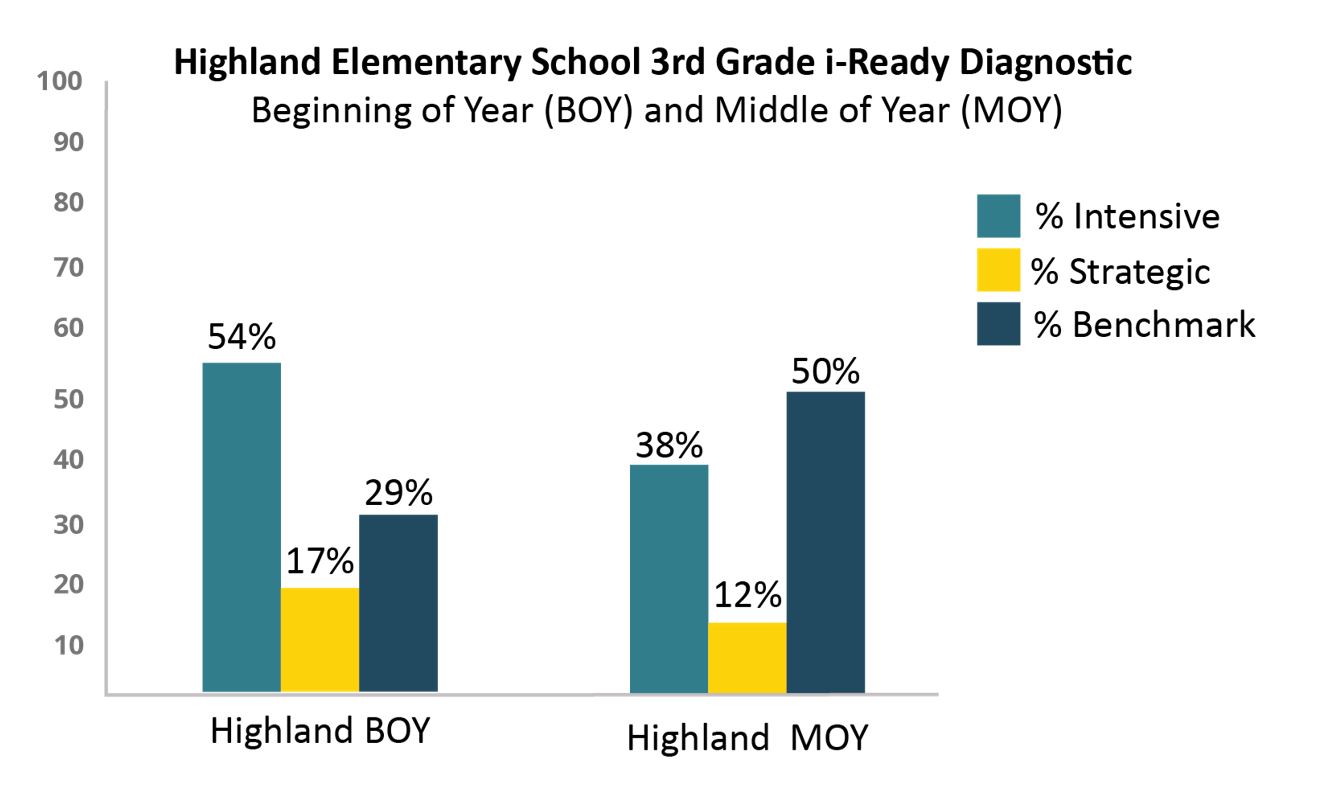
More frequent and targeted walkthroughs are resulting in increases in early literacy. Graphs included here note increases in 3rd-grade students meeting benchmark in literacy as measured by their iReady midyear assessment.
The Intensive Assistance Model at Highland Elementary School shows gains in student outcomes in the first semester and beyond. The focus of this model is to grow deep professional collaboration structures that prioritize student data for the purpose of improving student achievement. In the chart above, you can see the 3rd-grade iReady results of Highland Elementary and their growth over this year.
Our next steps, as we wind down the 22/23 school year, is to support IUSD with their Plan, Do, Study, Act (PDSA) planning using tools to support gap-cause analysis to design and develop cycles of improvement so the system can respond with precision to student needs.
BACKGROUND
In the spring of 2018, the State Administrator for Inglewood Unified School District (IUSD) requested support from the CCEE in reviewing the district’s strategic plan and the implementation strategies, and also to help develop stronger, collaborative governance processes. In October 2018, the state legislature passed statute AB 1840, which restructured the support mechanisms for districts with outstanding state loans. Inglewood had received a state loan in 2012 to avoid fiscal insolvency. For Inglewood, this resulted in the State Administrator reporting to the Los Angeles County Office of Education (LACOE) instead of the California Department of Education and automatically referred the district to the CCEE for technical assistance to support their instructional systems. This update will focus on providing updates on the latest improvement cycle from March 2023 to May 2023.
DISTRICT AREAS OF FOCUS
The SIR Actions are organized in the themes of Culture/Coherence/Systemness, Curriculum/Instruction/Assessment, Accountability and Professional Learning. The team at CCEE is working with the district’s Education Services Department and Principal Team focusing on instructional walkthroughs utilizing the districts observation tool for measuring student engagement.
PROGRESS UPDATE
IUSD is actively working on implementing the SIR actions focused on instruction, walkthroughs, coaching and accountability. With the focus by the Education Services team on supporting principals with instructional walkthroughs, the data collected with the walkthrough tool is showing evidence of increased frequency of walkthroughs and increases in Principal/Teacher coaching sessions, and an increase in student engagement.
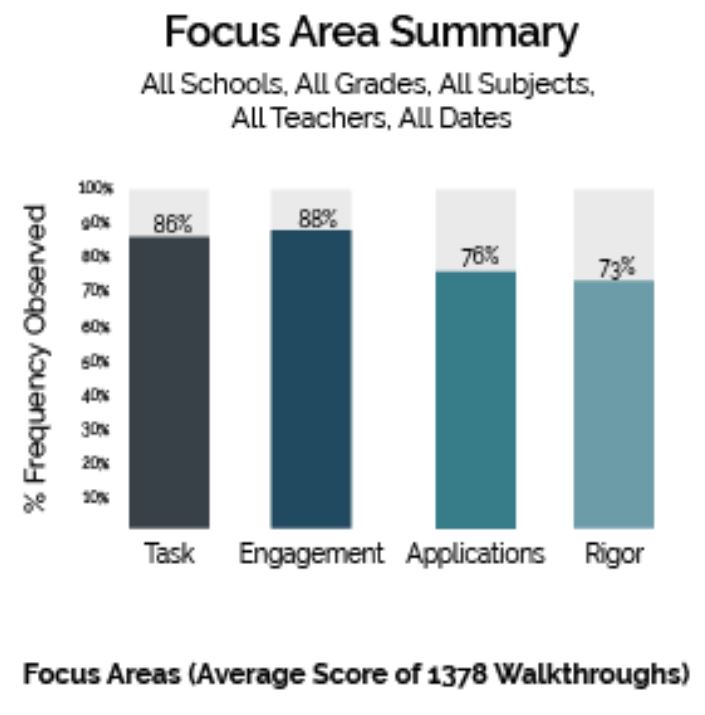
As evidenced by the graph included here. Principals recorded 1,378 walkthroughs from the beginning of the year until spring. In those walkthroughs they noted 88% of students were engaged.
In our collaboration with LACOE, IUSD and FCMAT, the teams will be working on supporting the educators in IUSD with programmatic planning, implementation and monitoring with an emphasis on implementation and monitoring. More specifically, establishing structures for monitoring that allow for adjustment toward improvement. Also, identifying tools to support effective decision making focused on strategies, timelines and personnel directly responsible for implementation and monitoring.
IUSD has identified the need to amplify Principal voice in this process to ensure improvements have the best chance of being successfully implemented at school sites. Noting that improvements specifically targeting supporting teachers and school leaders is paramount in efforts leading to increases in student achievement.
BACKGROUND
In the spring of 2018, the State Administrator for Inglewood Unified School District (IUSD) requested support from the CCEE in reviewing the district’s strategic plan and the implementation strategies, and also to help develop stronger, collaborative governance processes. In October 2018, the state legislature passed statute AB 1840, which restructured the support mechanisms for districts with outstanding state loans. Inglewood had received a state loan in 2012 to avoid fiscal insolvency. For Inglewood, this resulted in the State Administrator reporting to the Los Angeles County Office of Education (LACOE) instead of the California Department of Education and automatically referred the district to the CCEE for technical assistance to support their instructional systems. This update will focus on providing updates on the latest improvement cycle from August 2023 to November 2023.
DISTRICT AREAS OF FOCUS
The SIR Actions are organized in the themes of Culture/Coherence/Systemness, Curriculum/Instruction/Assessment, Accountability, and Professional Learning. The team at CCEE is working with the district’s Education Services Department and Principal Team, focusing on instructional walkthroughs utilizing the district’s observation tool for measuring student engagement.
PROGRESS UPDATE
The team at CCEE is working with the district’s Education Services and Principal Teams, primarily focusing on the FCMAT standards of 3.13: Students are engaged in learning, and they are able to demonstrate and apply their knowledge and skills, 3.16: The LEA makes ongoing use of a variety of assessment systems to appropriately place students at grade level and in intervention and other special support programs and, 4.5: School staff assesses all students to determine students’ needs and whether students require close monitoring, differentiated instruction, additional targeted assessment, specific research-based intervention, or acceleration.

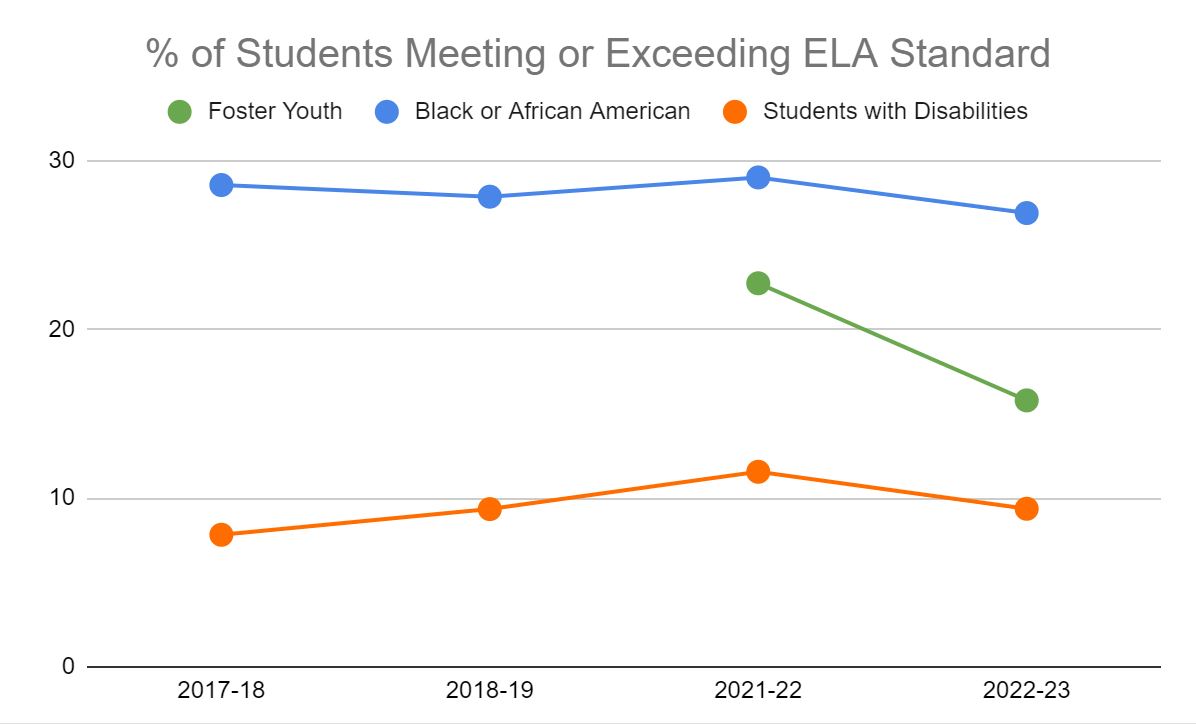
IUSD has identified the need to amplify the Principal’s voice in this process to ensure improvements have the best chance of being successfully implemented at school sites. Noting that improvements specifically targeting supporting teachers and school leaders are paramount in efforts leading to increases in student achievement.
With this, throughout this year, CCEE will be hosting its quarterly convenings in person at Principal Meetings. We are confident that this strategy will increase the implementation and monitoring of the FCMAT standards listed below and, in turn, support the completion of additional SIR actions.
BACKGROUND
In the spring of 2018, the State Administrator for Inglewood Unified School District (IUSD) requested support from the CCEE in reviewing the district’s strategic plan and the implementation strategies, and also to help develop stronger, collaborative governance processes. In October 2018, the state legislature passed statute AB 1840, which restructured the support mechanisms for districts with outstanding state loans. Inglewood had received a state loan in 2012 to avoid fiscal insolvency. For Inglewood, this resulted in the State Administrator reporting to the Los Angeles County Office of Education (LACOE) instead of the California Department of Education and automatically referred the district to the CCEE for technical assistance to support their instructional systems. This update will focus on providing updates on the latest improvement cycle from December 2023 to February 2024.
DISTRICT AREAS OF FOCUS
The SIR Actions are organized in the themes of Culture/Coherence/Systemness, Curriculum/Instruction/Assessment, Accountability, and Professional Learning. The team at CCEE is working with the district’s Education Services Department and Principal Team, focusing on instructional walkthroughs followed by coaching focused on instructional strategies and student engagement.
PROGRESS UPDATE
The team at CCEE is working with the district’s Education Services and Principal Teams, primarily focusing on the FCMAT standards of 3.13: Students are engaged in learning, and they are able to demonstrate and apply their knowledge and skills, 3.16: The LEA makes ongoing use of a variety of assessment systems to appropriately place students at grade level and in intervention and other special support programs and, 4.5: School staff assesses all students to determine students’ needs and whether students require close monitoring, differentiated instruction, additional targeted assessment, specific research-based intervention, or acceleration. With the focus on the FCMAT standards listed above, coupled with Principal walkthroughs emphasizing improved coaching, you can see some early rewards in literacy. More students are at or exceeding standard in 3rd grade on their mid-year iReady diagnostic than were at the beginning of the school year.
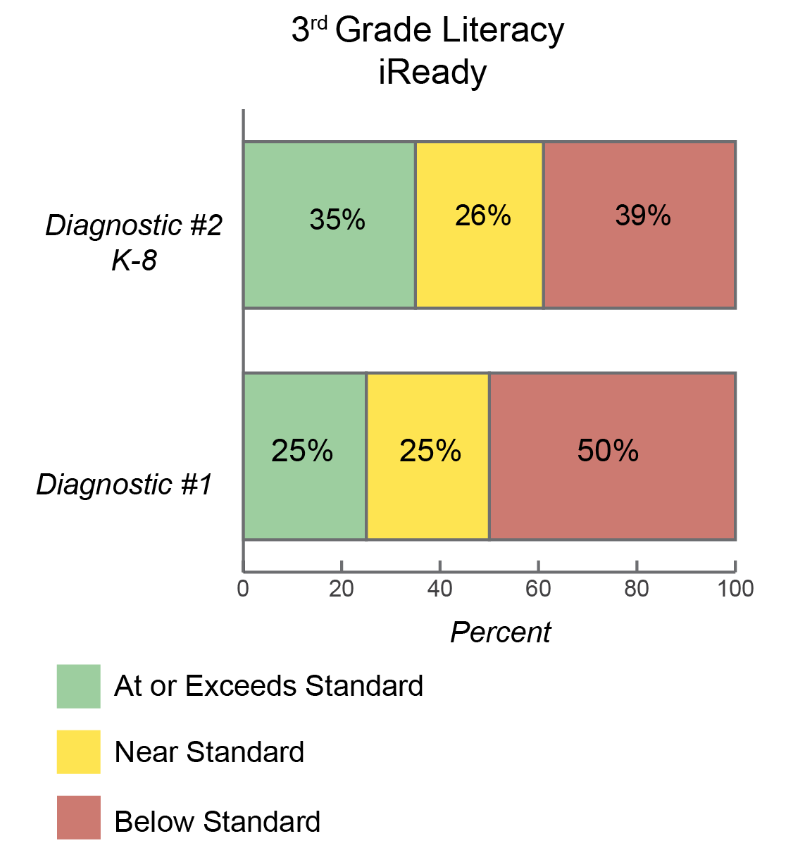
CCEE has been hosting quarterly meetings in person at IUSD Principal Meetings. The focus of these professional learning sessions is instructional coaching. The team at CCEE is working with the Education Services Team and Principals on taking their walkthrough data and working on how to best support a learning arc for all teachers through coaching. During our last session in early February, a coaching tool developed by the National Equity Project was shared to be a catalyst for Principals in designing their coaching sessions based on specific teacher need.
Looking ahead, the FCMAT report is almost completed, upon completion the Ed Services team along with CCEE will unpack the results and begin planning for improvement for the 24/25 school year. CCEE is not recommending further intervention by the Superintendent of Public Instruction at this time.
Vallejo City Unified School District
BACKGROUND
CCEE and VCUSD began working together through a joint request made by the Solano County Office of Education (SCOE) and VCUSD in 2018. Additionally, in October of 2018, a statute was passed by the State Legislature (AB1840) that restructured support for districts with outstanding state loans and automatically referred the district to the CCEE for technical assistance around their instructional systems.
Under the Differentiated Assistance (DA) process VCUSD met the criteria for the 2017 through 2019 school years whereby at least one student group met criteria in at least two different LCFF priority areas. The table below indicates the student groups performance in comparison to the average statewide performance for that student group (the most recent year data are available).

The graphic below shows the enrollment percentage of these student groups relative to the district’s entire student population.
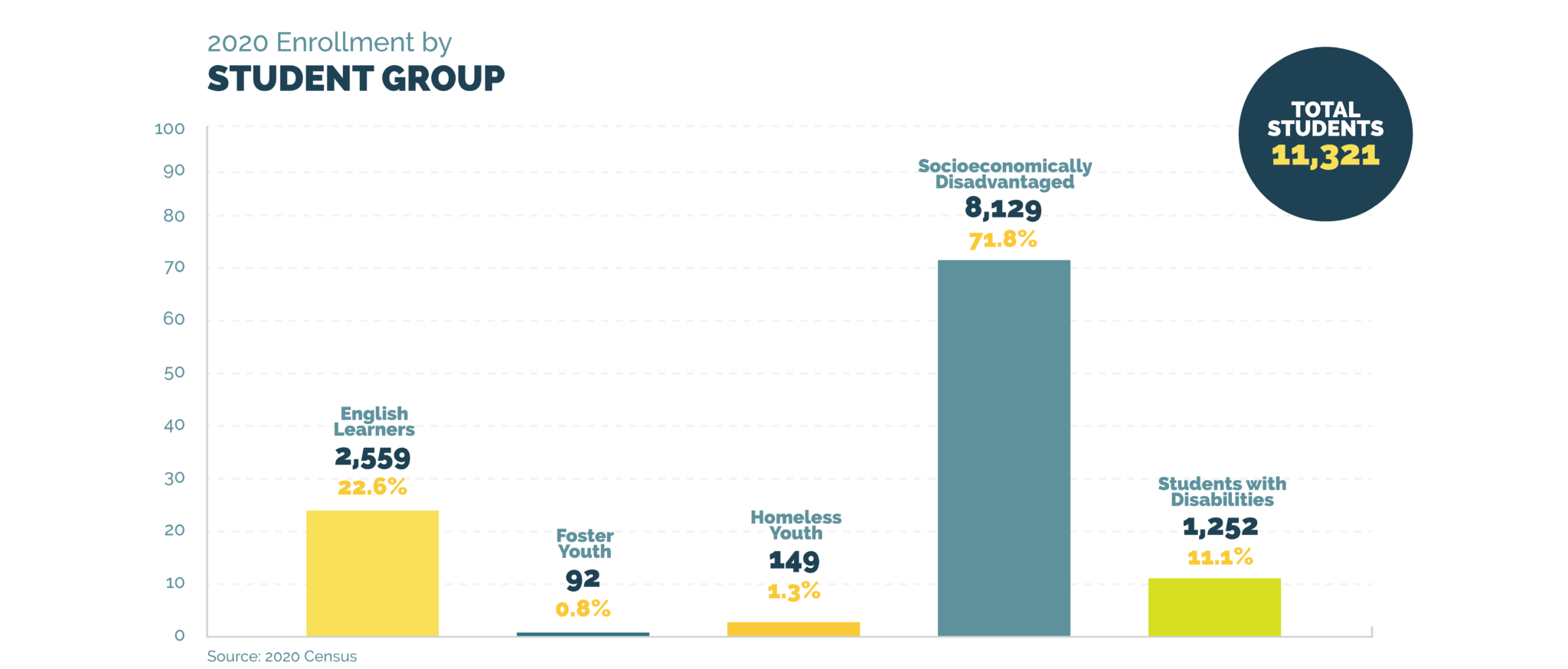
Vallejo City USD serves a diverse student population, with nearly half of its students being Hispanic, and nearly one-third of the student body being African American, as reported on the CA Dashboard.
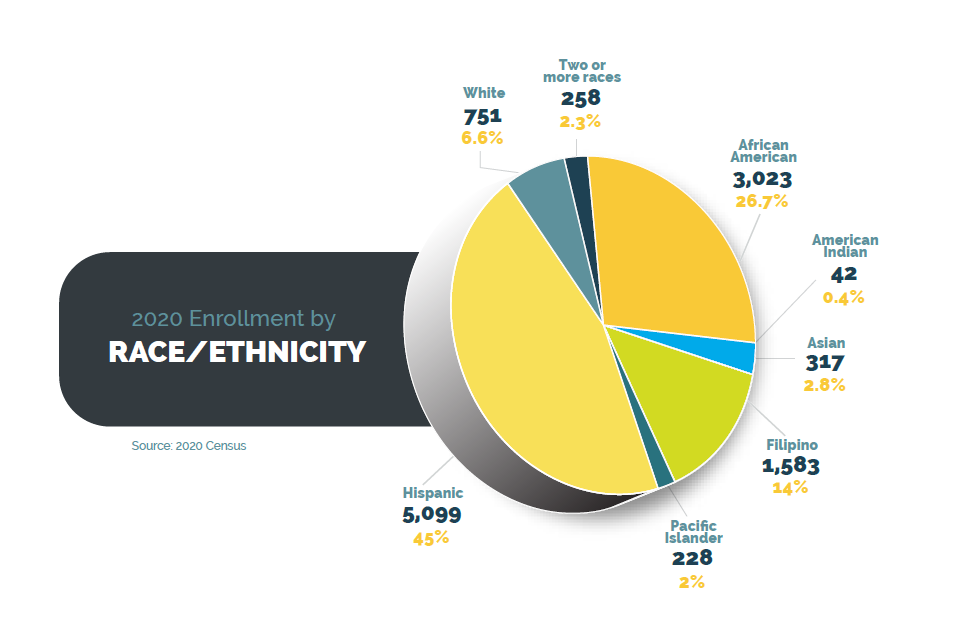
SYSTEMIC INSTRUCTIONAL REVIEW THEMES
The Vallejo City USD SIR report and VCUSD SIR report executive summary were completed in early February 2020. Four themes emerged from the SIR report, identifying the need for: 1) effective communication systems, 2) a coherent continuous improvement framework, grounded in data analysis, to organize the work, and 3) a comprehensive, multi-year professional learning plan grounded in the district’s strategic vision, and 4) establishing a culture of accountability to achieving stated goals.
PROGRESS UPDATE
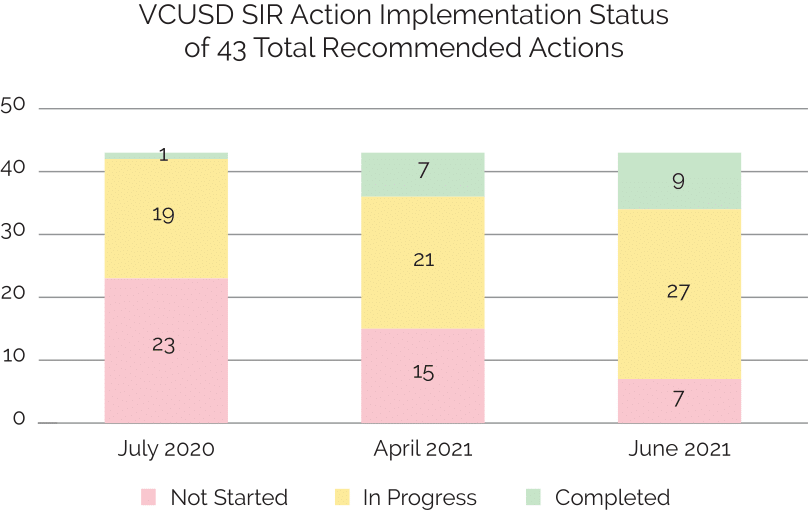
Throughout the disruption to schools caused by the COVID-19 pandemic, VCUSD continued their implementation of SIR recommended actions. They worked to improve communication to their parent and family community by providing weekly updates from site leaders and regular updates from the superintendent. VCUSD created instructional and social-emotional learning (SEL) guardrails to ensure consistent expectations across the system in distance and hybrid learning. Additionally, ELA and math instructional priorities were identified and sites began implementation. VCUSD provided ongoing and professional development opportunities to staff on new initiatives and programs for example in the areas of support to students with disabilities, English Learners, SEL, and student engagement.
CCEE held a progress monitoring quarterly update of Vallejo USD in mid-June 2021, making note of progress in the areas of communication within and across the system launching structures like Parent Square, Peach Jar, and the use of YouTube videos in response to the COVID-19 Pandemic. Data protocols that were constructed collaboratively with the Solano County Office of Education include a uniform data management system – 5Lab – to house multiple data sets into one warehouse for easy access. In addition there has been continued development of a framework for multi-tiered supports, primarily at the elementary level.
Several opportunities were identified during the June 2021 progress monitoring cycle. One opportunity is expanding the work around Multi-Tiered Systems of Support (MTSS) across the entire system using the newly hired Assistant Superintendent of Student Services to keep moving that work forward. This will further ensure implementation of the work at the secondary as well as the elementary levels. Another opportunity is filling the position of a full-time employee to focus specifically on communications to further engage the community around the work being done in VCUSD. Lastly, there is an opportunity to continue and expand the work of the improvement science training and connect that with the use of the data protocols and the new data warehouse to ensure consistent implementation of the instructional and social-emotional learning guardrails system-wide.
The threats and weaknesses surrounding implementation of the SIR recommended actions in VCUSD include practices around data done as a simple compliance activity rather than as a best practice for moving forward and developing a culture of continuous improvement, implementation of MTSS is solely occurring at the elementary level with secondary not fully engaging in this work yet, and there continues to be a lack of clarity and consistency of expectations and implementation across the system.
During this cycle CCEE provided ongoing support to VCUSD with several different support providers. There was a coach providing support and working to build the capacity of principals, assistant superintendent and the superintendent to further implementation of SIR actions. Pivot Learning, an educational nonprofit focusing on systems implementation was brought in to support the development and implementation of an MTSS framework, the implementation of MTSS best practices along with the use of data to improve student outcomes. Lastly, CCEE has funded a District and School Improvement Liaison located at the Solano County Office of Education who supports and regularly engages with district leaders to build the capacity of the central office in the implementation of SIR recommended actions.
NEXT STEPS
CCEE has advised VCUSD to create a clear prioritization plan that highlights which SIR actions are the priority areas with metrics to analyze for the cycle that can clearly define expectations for consistent use and implementation of district goals. Also, VCUSD would benefit from delineating the roles and responsibilities of the Assistant Superintendents of Teaching and Learning and Student Services to provide clarity of expectation, leverage resources, and avoid fragmentation and duplication of work. Additionally, continue to provide on-going professional learning to administrators and instructional leadership teams around data analysis using continuous improvement cycles and how to incorporate multi-tiered (Tier 1 and Tier 2) practices that address learning acceleration and disproportional rates of suspension and academic achievement between student groups.
BACKGROUND
CCEE and Vallejo City Unified School District (VCUSD) began working together through a joint request made by the Solano County Office of Education (SCOE) and VCUSD in 2018. Additionally, in October of 2018, a statute was passed by the State Legislature (AB1840) that restructured support for districts with outstanding state loans and automatically referred the district to the CCEE for technical assistance around their instructional systems. This update will focus on providing updates on the latest improvement cycle from August 2022 to November 2022.
DISTRICT AIM STATEMENT
By June 2023, students will realize an achievement gain of at least nine points in literacy achievement as measured by a reduction in the Distance from Standard on formative and summative assessments. The VCUSD also effectively launched and directly supported the intensive support model work at Federal Terrace Elementary School beginning this school year.
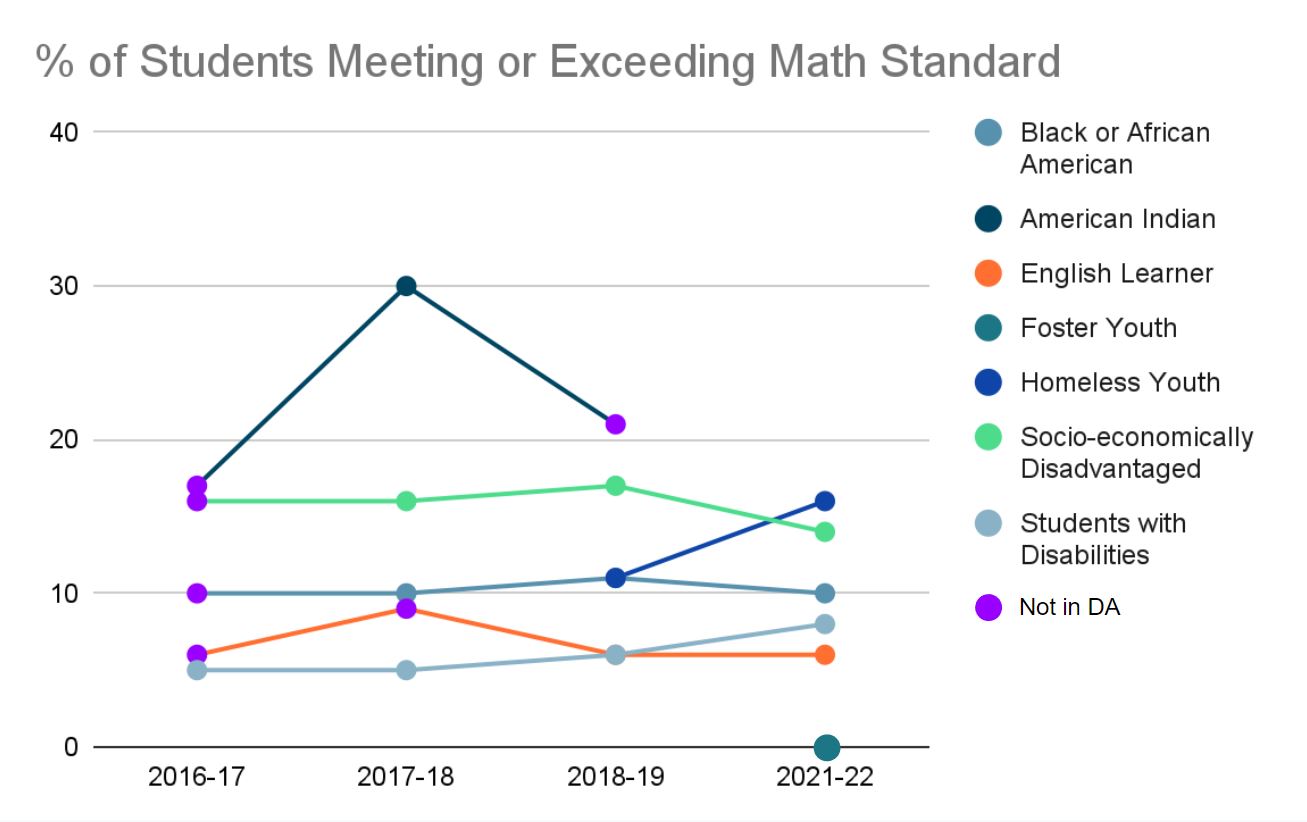
PROGRESS UPDATE
VCUSD is actively working to implement another 31 of the actions at various stages. CCEE has been working in partnership/collaboration with VCUSD and Solano County Office of Education to engage in cycles of improvement around the district aim statement. The district progressed in development of plans, but some of these actions in data and professional learning are re-engaging due to staffing changes.

In this update, the VCUSD progressed by beginning to implement an aim statement that is more focused instructionally and is tied with clear and measurable outcomes using NWEA and to improve CAASPP scores. The district conducted walkthrough activities with all 19 school sites in this period to examine levels of learning rigor and student engagement. Goals were set district-wide and with school site leaders as a result.
The District took the opportunity to meet with all site and instructional coaches to set goals for increasing student literacy rates based on walkthrough, CAASPP data, and a review of instructional materials. Sites will now implement changes for this cycle that will influence professional learning. CCEE will continue to coach the teams toward a robust Plan/Do/Study/Act (PDSA) cycle informing this next quarter.
Next steps include analysis of the most recent NWEA benchmark data and development of professional development at each site that aligns to the assessment data and goals. More alignment work will continue at the board and Strategic Planning levels.
BACKGROUND
CCEE and Vallejo City Unified School District (VCUSD) began working together through a joint request made by the Solano County Office of Education (SCOE) and VCUSD in 2018. Additionally, in October of 2018, a statute was passed by the State Legislature (AB1840) that restructured support for districts with outstanding state loans and automatically referred the district to the CCEE for technical assistance around their instructional systems. This update will focus on providing updates on the latest improvement cycle from December 2022 to February 2023.
DISTRICT AIM STATEMENT
By June 2023, students will realize an achievement gain of at least nine points in literacy achievement as measured by a reduction in the Distance from Standard on formative and summative assessments. The VCUSD also effectively launched and directly supported the intensive support model work at Federal Terrace Elementary School beginning this school year.
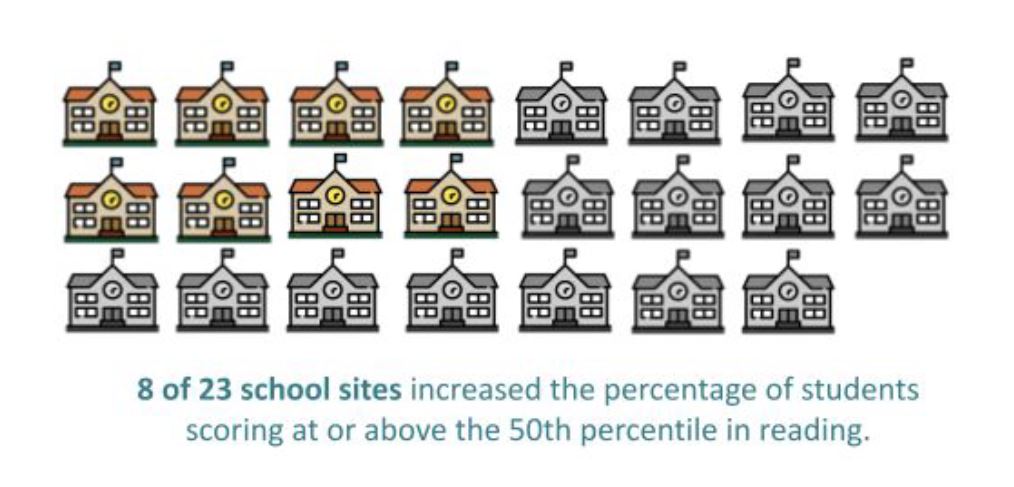
PROGRESS UPDATE
In this quarter VCUSD continues their focus on early literacy. The members of the Education Services team continue engaging in learning walks across all sites to gather information about instruction and the supports needed to provide a more rigorous classroom experience. There was a district-wide Professional Learning day in which approximately 8 of the elementary sites spent the day in CORE Reading training around various skills and strategies. There continues to be training for teacher leaders so they are more equipped to provide coaching and feedback. Additionally, members of executive cabinet are engaging in learning around improvement science led by Solano COE and CCEE staff.
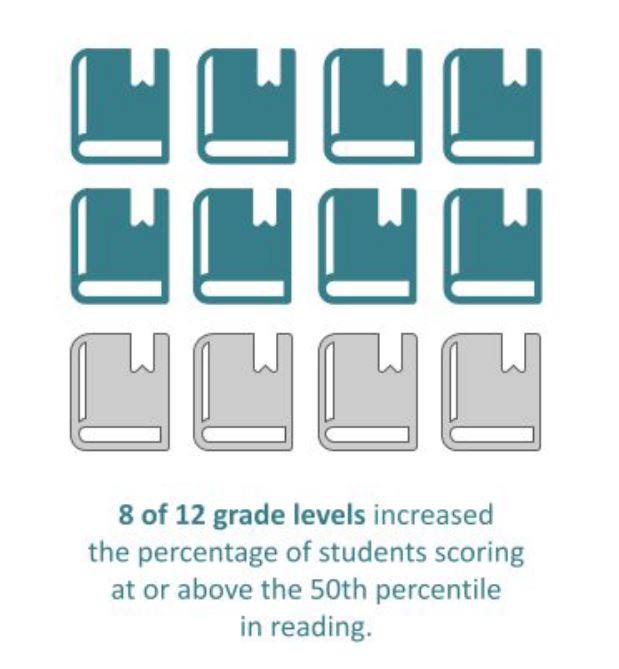
District and site leaders continue to engage in learning walks, gathering evidence of student learning around the district’s instructional priorities. There is an increased focus on professional learning grounded in research and deepened over time through CORE Reading and the implementation of the science of reading across elementary schools.
VCUSD has an opportunity to deepen teachers’ understanding of the science of reading through continued, targeted professional learning with clear expectations for implementation communicated to all staff and families. There is also an opportunity to deepen the use of data and assessment to better understand what students need and how to support higher levels of learning for all students.
CCEE will continue to provide support and guidance through bi-weekly check-ins, individual and group coaching, observations of district professional learning opportunities, and improvement science for the executive cabinet members in partnership with Solano COE in the areas of professional learning planning and implementation and early literacy.
BACKGROUND
CCEE and Vallejo City Unified School District (VCUSD) began working together through a joint request made by the Solano County Office of Education (SCOE) and VCUSD in 2018. Additionally, in October of 2018, a statute was passed by the State Legislature (AB 1840) that restructured support for districts with outstanding state loans and automatically referred the district to the CCEE for technical assistance around their instructional systems. This update will focus on providing updates on the latest improvement cycle from March 2023 to May 2023.
DISTRICT AREAS OF FOCUS
By June 2023, students will realize an achievement gain of at least nine points in literacy achievement as measured by a reduction in the Distance from Standard on formative and summative assessments. The VCUSD also effectively launched and directly supported the intensive support model work at Federal Terrace Elementary School beginning this school year.
PROGRESS UPDATE
Progress on improvement outcomes has yielded limited positive results despite partner efforts. With support, VCUSD developed and is beginning to implement the VCUSD Professional Learning Plan to drive early literacy instruction through specific training in the Science of Reading. Realizing the intended outcomes from training will provide students with access to more rigorous expectations for literacy development. Staffing challenges for permanent and short-term vacancies complicates the district’s ability to achieve student progress.
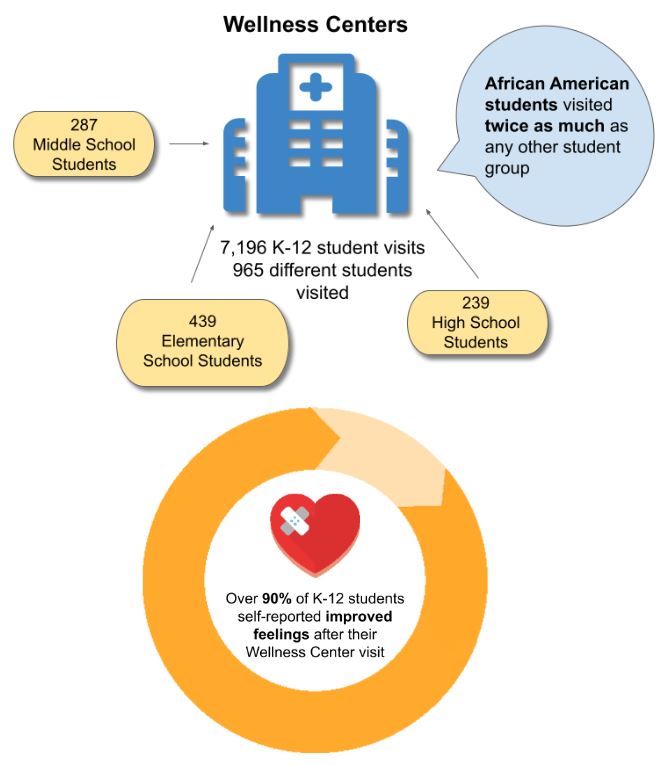
A bright spot in the Solano County Office of Education and Vallejo City Unified School District partnership is the support and implementation of District Wellness Centers in 2023. Student Wellness Center use data shows 439 elementary, 287 middle school and 239 high school students accessed services, with African American students visiting twice as much compared with peers, and 90% of all students reporting “improved feelings” after accessing Wellness Center services. More specific data related to student reason for visit and staff level of service will shed more light on what students are experiencing and how the district can meet the specific needs of students. Addressing the social-emotional needs of students is a strategy that is providing early positive results.
Current coaching efforts help focus cabinet and district leadership on concerted actions to drive the Professional Learning Plan. Leadership as a team effort is highly encouraged under this approach. Developing school staff to improve student literacy rates so every student can read by third grade will continue to be a primary driver of change and an accountability point for district leadership. There’s a real opportunity to kick off the 2023-24 school year with a focus on early literacy as the building block for the Portrait of a Graduate in Vallejo.
BACKGROUND
CCEE and Vallejo City Unified School District (VCUSD) began working together through a joint request made by the Solano County Office of Education (SCOE) and VCUSD in 2018. Additionally, in October of 2018, a statute was passed by the State Legislature (AB1840) that restructured support for districts with outstanding state loans and automatically referred the district to the CCEE for technical assistance around their instructional systems. This update will focus on providing updates on the latest improvement cycle from August 2023 to November 2023.
DISTRICT AREAS OF FOCUS
This school year, Vallejo City USD continues to center its improvement efforts on the area of early literacy. The district is also focusing on chronic absenteeism and suspensions.
PROGRESS UPDATE
VCUSD is actively focusing its efforts on improving early literacy. They successfully launched their multi-year professional learning plan that centers heavily on providing training and resources around the Science of Reading. Additionally, the superintendent announced he will be retiring effective June 30, 2024.
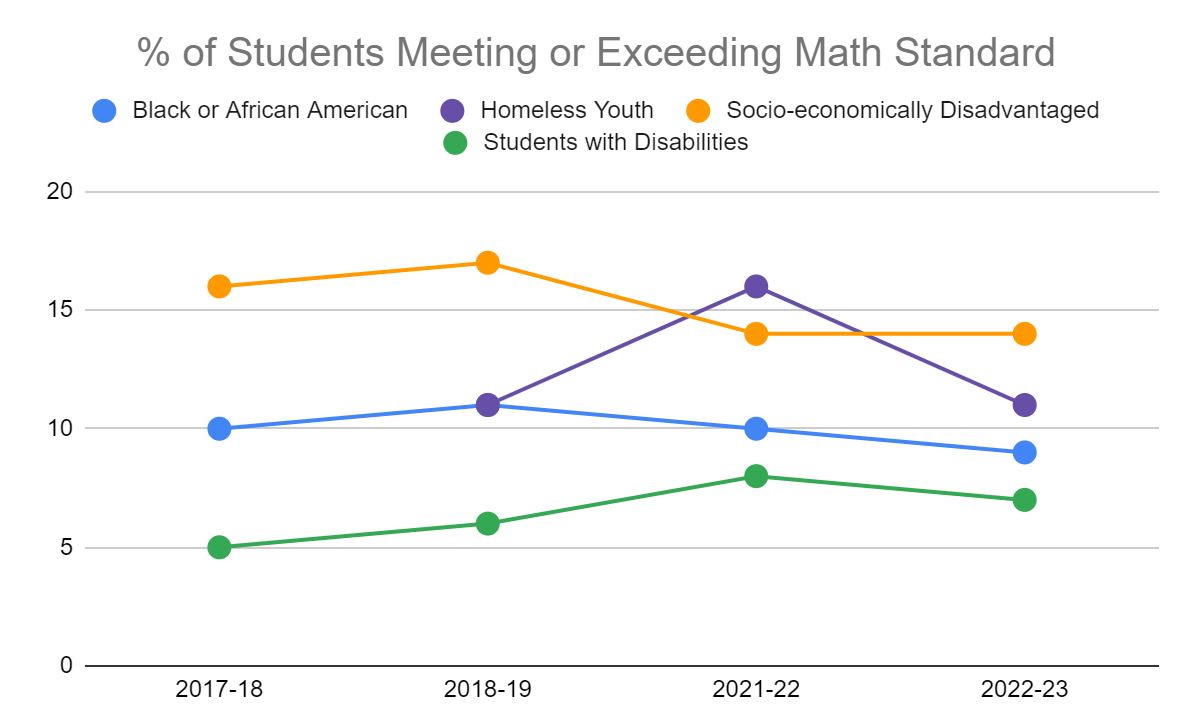
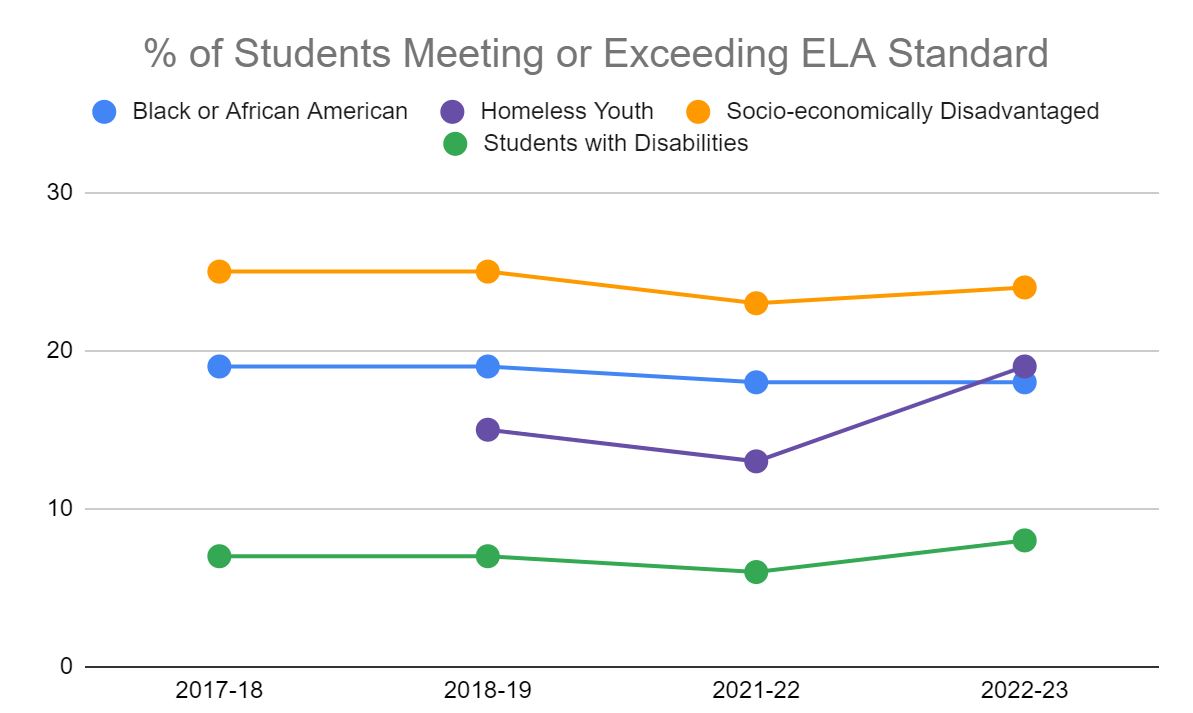
VCUSD is implementing the CORE assessments and using the data results to inform their upcoming professional learning opportunities and guide the focus of their learning walks. This year, they have also modified their assessment calendar to have more timely data to guide professional learning. For the 23-24 school year students will take the second NWEA assessment from the end of November through December instead of mid-January to early February. VCUSD is also closely monitoring attendance data. They are currently involved in a PDSA cycle involving an elementary school with high chronic absenteeism rates. CCEE continues to support VCUSD in partnership with SCOE on implementing change ideas related to these focus areas. There is an opportunity to deepen the culture of data and data use across the system. There is work being done to align data systems. The district needs to ensure that valid, reliable, and consistent data is accessible across the system and in a timely fashion that allows schools to use it effectively for making instructional decisions and adjustments.
CCEE and SCOE will continue to support VCUSD in several different ways. We will continue to support their PDSA cycles through monthly check-ins. We are developing a community of practice within the directors in the system. Lastly, continuing the work in improvement science at the cabinet level all to focus their improvement efforts.
CCEE is looking into the possibility of further intervention by the Superintendent of Public Instruction due to several areas of critical concern that the CCEE continues to communicate to the VCUSD Board, administration, and staff. As evidenced by December CAASPP results, the district continues to struggle to improve student outcomes for all relevant student groups. Despite the efforts of the CCEE and Solano COE, we are not seeing the attitudinal urgency that is needed to correct these increasing deficits.
Vallejo City USD Report – February 2024
BACKGROUND
CCEE and Vallejo City Unified School District (VCUSD) began working together through a joint request made by the Solano County Office of Education (SCOE) and VCUSD in 2018. Additionally, in October of 2018, a statute was passed by the State Legislature (AB 1840) that restructured support for districts with outstanding state loans and automatically referred the district to the CCEE for technical assistance around their instructional systems. In December 2022 VCUSD became eligible for Direct Technical Assistance via Education Code subdivision (g) of Section 52064.5. The student groups identified for VCUSD were previously African American, Homeless Youth, Socioeconomically Disadvantaged, and Students with Disabilities and now includes English Learners who have been newly identified in 22-23. This update will focus on providing information on the latest improvement cycle from December 2023 to February 2024.
DISTRICT AREAS OF FOCUS
The Directors’ Community of Practice convened monthly this quarter to share problems of practice, best practices, share ideas, tools and resources, to build collective knowledge, and create stronger collaboration amongst departments across the organization. This is an emerging change agency group that will work directly with sites and principals, but also senior leadership. The directors have also met monthly with senior cabinet leadership and the superintendent to develop a “service to schools model” facilitated by CCEE to drive change.
PROGRESS UPDATE
The district, CCEE and Solano COE teams met in January 2024 for a mid year progress update on quarterly goals. The team reviewed progress towards goals, and while the district hit a few of their mid-year targets, progress has been made since this time last year and from the beginning of this school year. At the mid-year NWEA cycle 27.62% of students in grades 3-11 were projected to meet or exceed standard, with the goal being 37.8%. The district had a goal to reduce chronic absenteeism to 20% from 44% and at the mid year mark they were at 31%. In April 2024, the teams will review early literacy data from grades k-2.
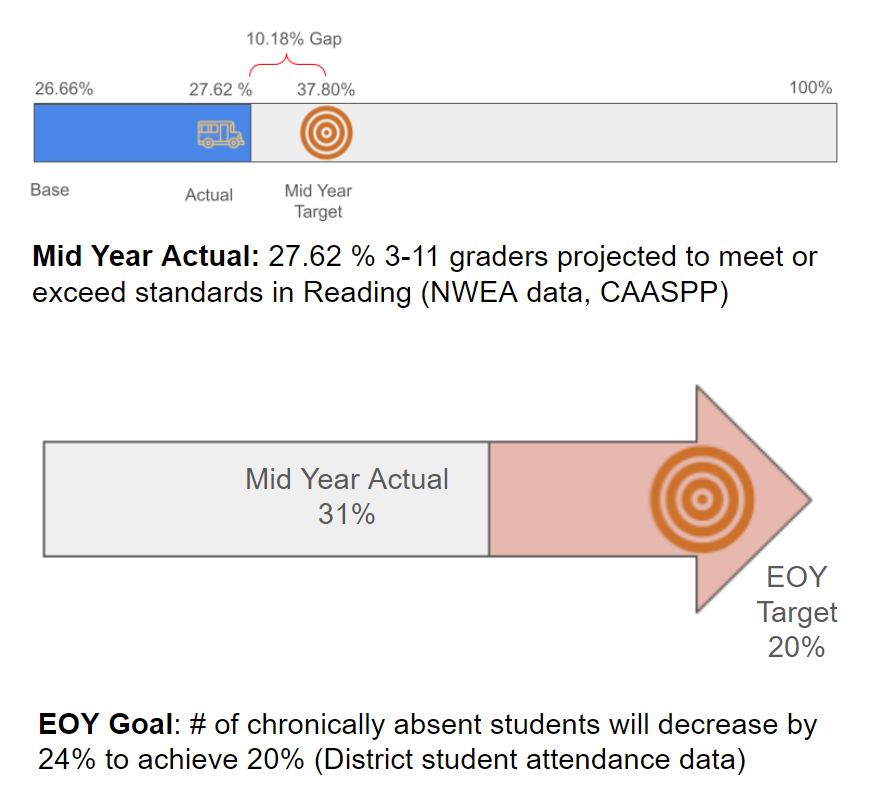
The development of a “service to schools model” is helping the district to design and develop a service of schools model. SCOE conducted empathy interviews with all 19 principals the first week of March 2024 to help inform the development of the model. CCEE also facilitated a consultancy around the district goal setting process and is using the Directors Community of Practice to provide regular input into the LCAP development.
With the current shifts in Superintendent and Assistant Superintendent of Education Services along with other key Teaching and Learning and Student Support Services department positions, the district has an opportunity to realign and formalize expectations for district and site leaders through the development of the “service to schools model.” There is also an opportunity to reset expectations across the system under new leadership.
CCEE, SCOE and VCUSD will continue to meet several times per month over the next quarter and to coach the development for a “service of schools model” and plan for its implementation through an annual planning calendar. The team will also continue to monitor the identified metrics throughout the Spring to support VCUSD in reaching its end of year goals. CCEE is still looking into the possibility of further intervention by the Superintendent of Public Instruction.
Salinas Union High School District
BACKGROUND
Salinas Union HSD was referred to CCEE for assistance in 2019 after the 2018-19 California School Dashboard results showed the district failed to meet priority outcomes for a third year in a row. This year marked the third year for the CA Dashboard, which enacted Education Code subdivision (g) of Section 52064.5 (CA School Dashboard) that if three or more pupil groups identified pursuant to Section 52052, in three out of four consecutive school years, the district is eligible for support from CCEE. The student groups identified for SUHSD are English learners, students experiencing homelessness and students with disabilities. The table below indicates the student groups performance in comparison to the average statewide performance for that student group (the most recent year data are available).
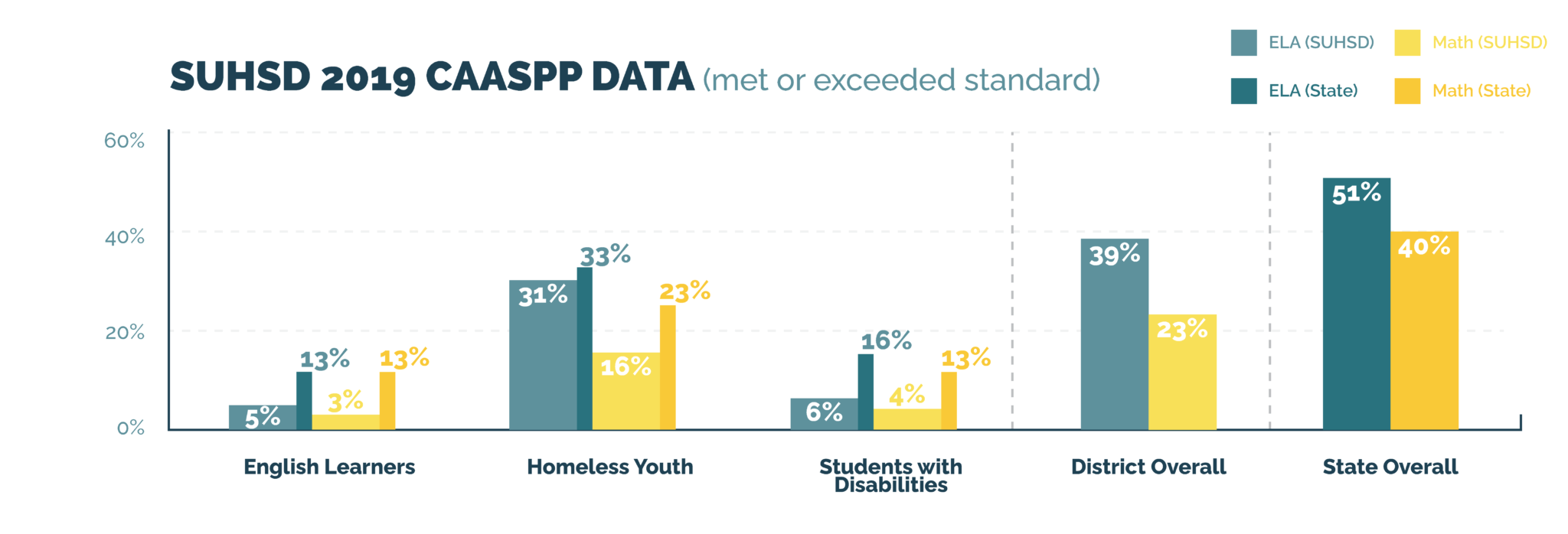
The graphic below shows the enrollment percentage of these student groups relative to the district’s entire student population.
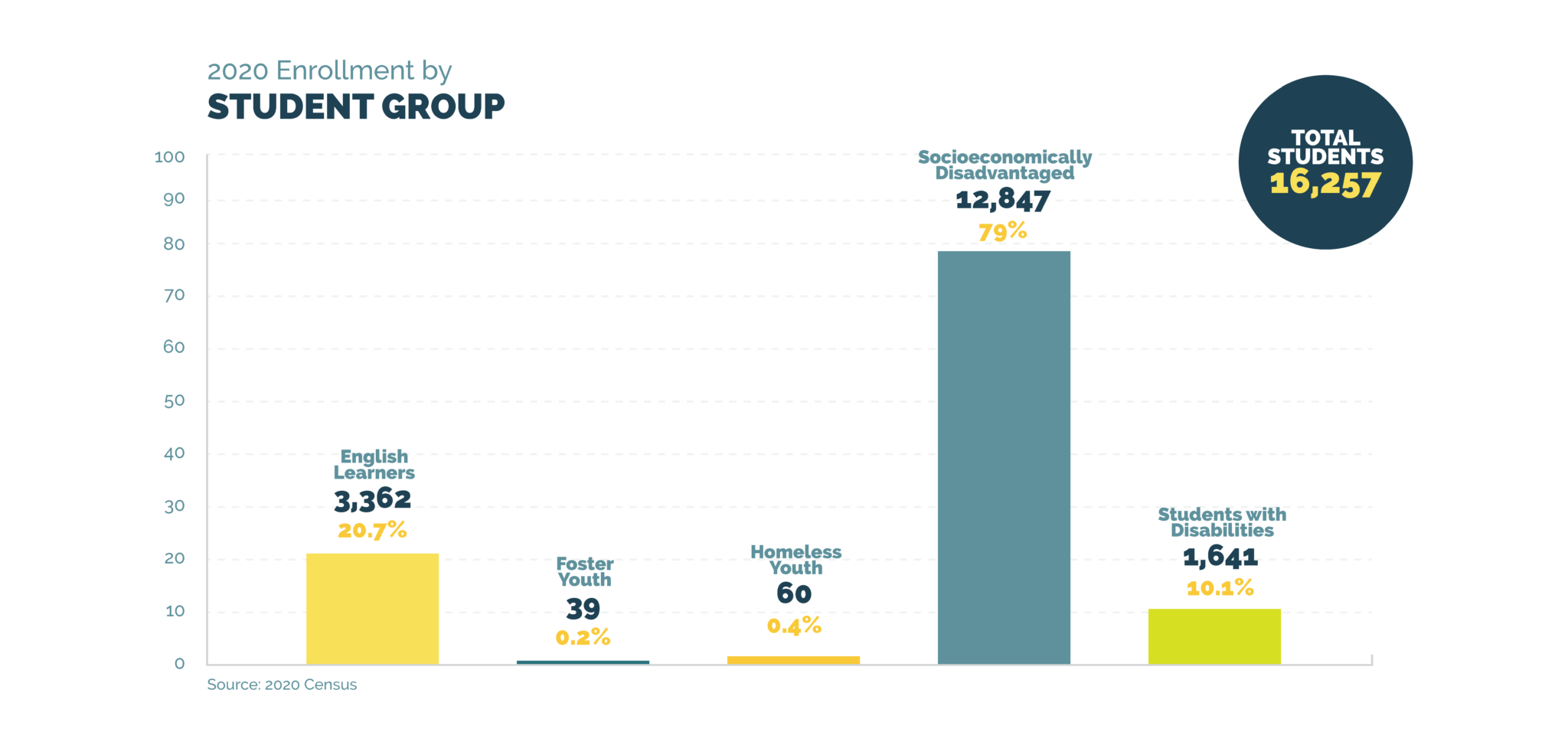
The vast majority of Salinas UHSD students are Hispanic, with other races and ethnicities represented by smaller percentages of students, as reported on the CA Dashboard.
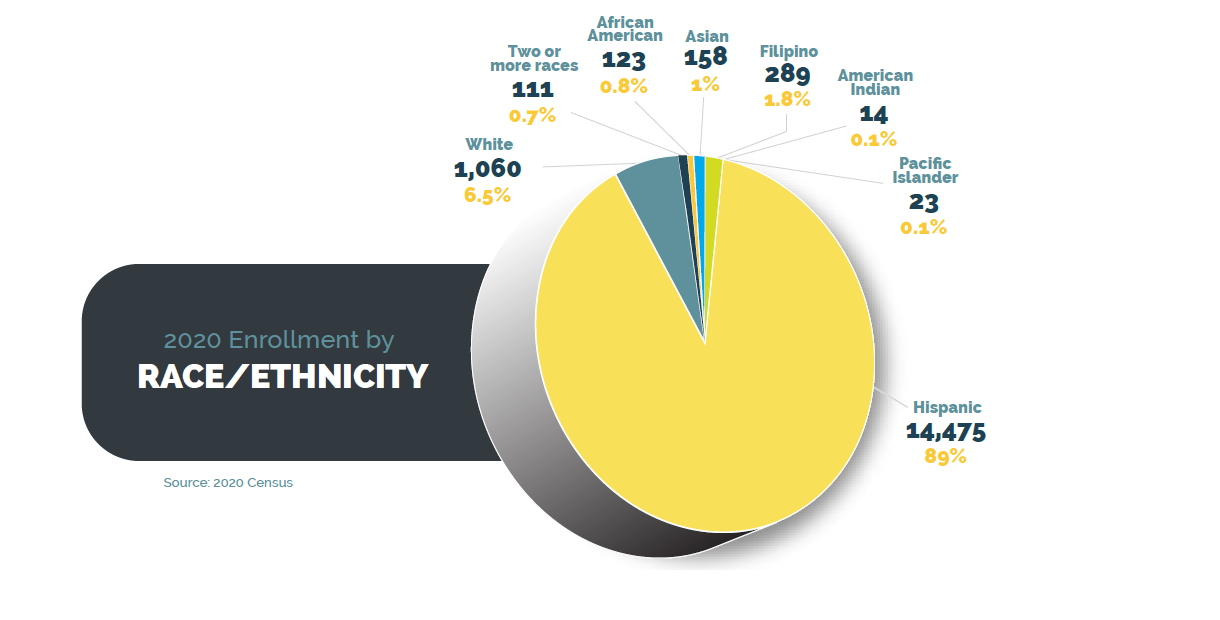
SYSTEMIC INSTRUCTIONAL REVIEW THEMES
The SUHSD SIR report and SUHSD SIR report executive summary were finalized in late June 2020. Three themes emerged in the SUHSD SIR Report as a result of data collection raising concerns about: 1) clarity and coherence, 2) accountability and 3) communication which also refer to the work being done by the district around Fullan and Quinn’s (2016) Coherence Framework.
PROGRESS UPDATE
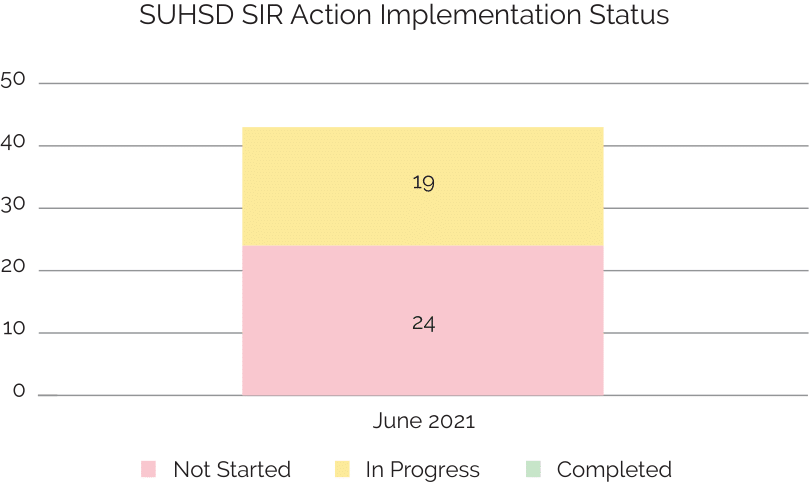
Through the summer of 2020, SUHSD prioritized their SIR recommended actions and assembled a team that includes stakeholder representation (e.g., principals, teachers, union leaders, paraeducators) to work with CCEE, in partnership with Monterey County Office of Education, to plan and implement the SIR recommendations actions. During this time, SUHSD worked to develop their Distance Learning Plan and resources for its implementation. Throughout the disruption to schools caused by the COVID-19 pandemic SUHSD worked to increase parent communication and find methods that improved the two-way communication between the community and SUHSD. This work will serve as a base for their ongoing improvement communication efforts.
CCEE conducted a progress monitoring quarterly update with Salinas Union HSD and Monterey County Office of Education in early June 2021. The areas of strength included the leveraging of SIR recommended actions to narrow the district’s focus. The district team has aligned their new LCAP, professional development, and professional learning networks (PLN) to increase coherence and clarity. Additionally, a 2021-2022 assessment calendar is in place that includes data chats from district leadership to students and parents.
The district has implemented weekly community communications and clear communication to steering committees that have allowed for the selection of the High School ELD curriculum with teacher input. There is an opportunity to include principal and teacher representatives when designing communication to the field, such as the why, what, and how of co-teaching at SUHSD.
The threats and weaknesses surrounding SUHSD revolve around the need for further clarity, coherence, increasing the depth of implementation at the school site level, and how the central office will support schools using a multi-tiered approach. While general plans and policies are in place, there is no single district instructional plan that includes: focus, expectations, goals, etc., around academic outcomes. Further clarity is needed on the expectations and purpose of classroom visits, setting incremental targets as part of their cycles of improvement and how the cycles being implemented are connected to principal evaluations. These connections and deeper work will allow for further coherence across the SUHSD instructions systems and processes to improve pupil achievement.
During this cycle, CCEE supported the leadership team by providing CCEE professional experts to assist in narrowing the instructional focus areas for the year and developing the assessment calendar for 2021-2022 aligned to these. The district has also identified a process for engaging school principals and school leadership teams in cycles of inquiry to respond to instructional needs and pupil achievement. Additionally, CCEE engaged the SUHSD instructional team in reviewing existing documents, policies, and artifacts that could serve as the basis of the district’s instructional plan. We further supported leadership in connecting the SIR recommendations with the LCAP plan and engaged in learning walks with site leadership teams and provided feedback to site administrators and district leadership. Lastly, we collaborated with Peter DeWitt, a nationally distinguished leadership coach, to align the district’s coaching work with him to the SIR recommended actions
NEXT STEPS
To further build clarity and strengthen the implementation of instructional practices, we recommend developing a district instructional plan with stakeholders that bring together existing practices, instructional documents, connect indicators for engagement and teacher clarity to student outcomes. Adopt the communications strategies and lessons learned during the pandemic to define SUHSD two-way communication and the objectives and indicators of success. Additionally, support principals and assistant principals in implementing quality instruction by codifying the expectations of cycles of improvement and enveloping them in the leadership evaluation process. This will set up school sites to address pupil achievement and hold them accountable to district expectations. Lastly, the district can further build coherence by selecting a couple of elements from their existing Gradual Release of Responsibility(GRR)/ Constructing Meaning (CM) rubric that align with student engagement and teacher clarity to have a common way of measuring implementation and noting the impact of these practices on student learning.
BACKGROUND
After the 2018-19 CA Dashboard Data Release, the Salinas Union High School District (SUHSD) became eligible and was referred in late 2019 by their County Office of Education to the CCEE for support via Education Code subdivision (g) of Section 52064.5. The focus student groups for SUHSD are English learners, students experiencing homelessness, and students with disabilities. Since the completion of the SIR report the LEA, in partnership with the Monterey County Office of Education (MCOE) has been engaging in cycles of continuous improvement. This update will focus on providing updates on the latest improvement cycle from August 2022 to November 2022.
DISTRICT AREAS OF FOCUS
The SIR Actions are organized in the themes of Clarity and Coherence, Accountability, and Communication. The team at CCEE is working with all of the schools Instructional Leadership Teams (ILTs) on identified content areas Problem of Practice with the goal of expanding this work to every content area in every school.

PROGRESS UPDATE
SUHSD is actively working on implementing five of the SIR actions focusing on strengthening instructional coherence through their adopted instructional framework, utilizing data to inform their cycles of continuous improvement. CCEE has been working in partnership/collaboration with SUHSD and MCOE on supporting SUHSD and the ILTs.
The ILTs are making substantial progress and the momentum of this process is building as evidenced by the increase of content teams participating this year. Thirty four department teams are engaging in Plan/Do/Study/Act (PDSA) cycles this year. This number represents an increase of more than double from last year. SUHSD is working on expanding the continuous improvement model “vertically” in the district and as a result, there are five continuous improvement projects planned at the central office led by Directors.
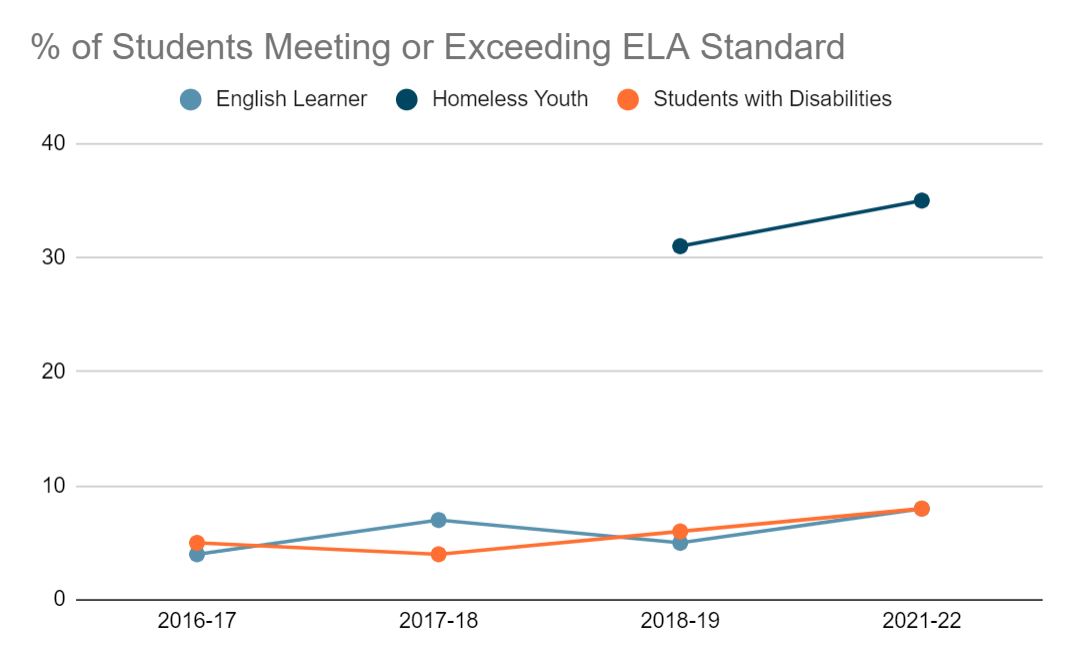
For next steps, CCEE will continue to provide support to the districts Education Services team and ILTs. The Education Services team has two new members and our support is focused on making sure they have everything they need to support the ILTs. Additionally, with the two most senior positions in Education Services being new this year, our next steps include supporting these teammates through this next cycle to build their capacity heading into the 23/24 school year with a goal of this process flourishing on its own beyond the support of CCEE and MCOE.
BACKGROUND
After the 2018-19 CA Dashboard Data Release, the Salinas Union High School District (SUHSD) became eligible and was referred in late 2019 by their County Office of Education to the CCEE for support via Education Code subdivision (g) of Section 52064.5. The focus student groups for SUHSD are English learners, students experiencing homelessness, and students with disabilities. Since the completion of the SIR report the LEA, in partnership with the Monterey County Office of Education (MCOE) has been engaging in cycles of continuous improvement. This update will focus on providing updates on the latest improvement cycle from December 2022 to February 2023.
DISTRICT AREAS OF FOCUS
The SIR Actions are organized in the themes of Clarity and Coherence, Accountability, and Communication. The team at CCEE is working with all of the schools Instructional Leadership Teams (ILTs) on identified content areas Problem of Practice with the goal of expanding this work to every content area in every school.
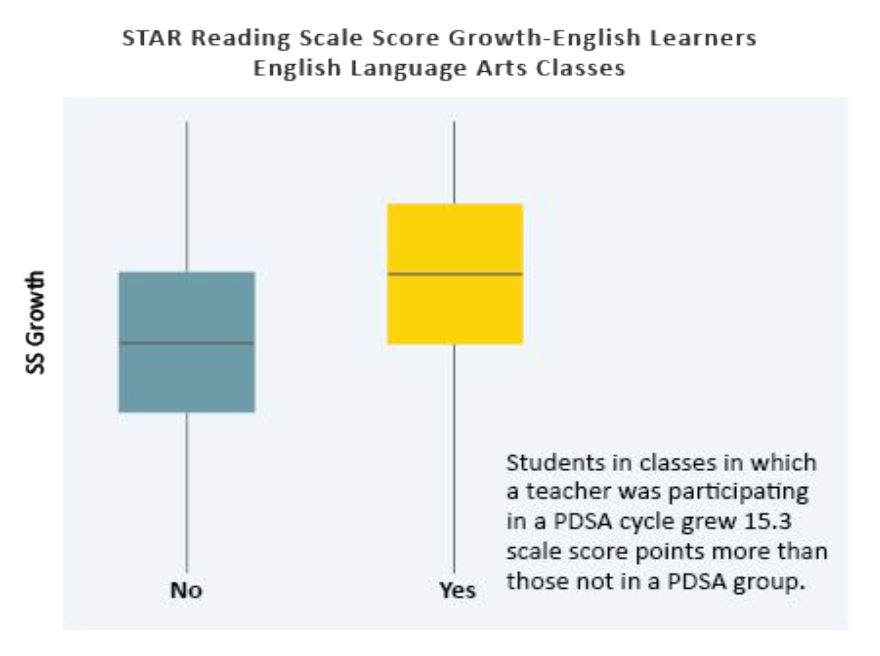
PROGRESS UPDATE
SUHSD is actively working on implementing five of the SIR actions focusing on strengthening instructional coherence through their adopted instructional framework, utilizing data to inform their cycles of continuous improvement. CCEE has been working in partnership/collaboration with SUHSD and Monterey County Office of Education (MCOE) on supporting SUHSD and the instructional leadership teams (ILTs). With this data, the goal is to scale cycles to every grade level and content area over time.
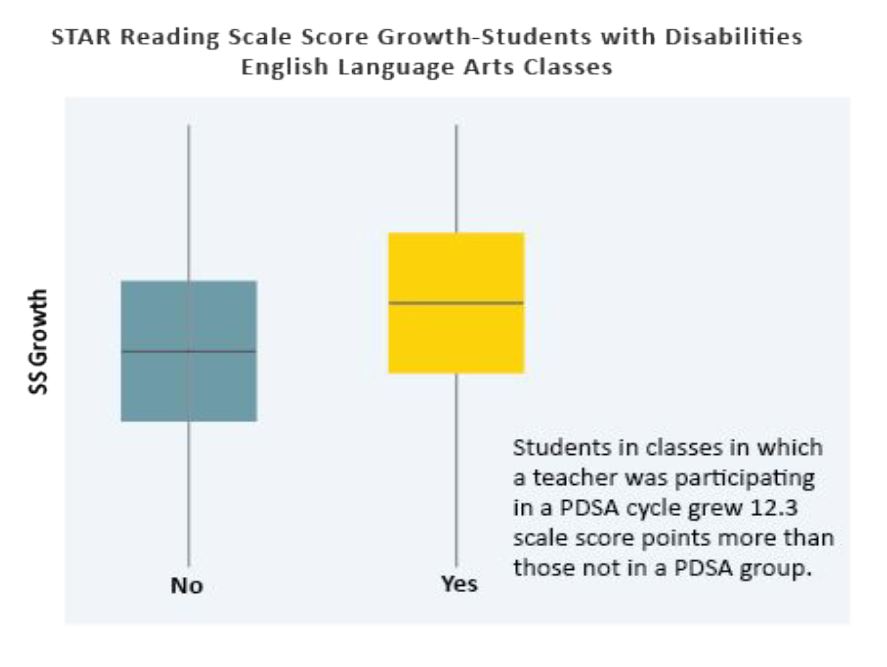
In a review of student STAR scale score data in both ELA and Math, students are growing across the district. When you take a closer look, there is statistically significant evidence that growth is higher for students in classes where teachers participate in continuous improvement cycles. This remains true for all students and when you disaggregate for student groups. To the right, you can see scale growth for English Learners and Students with Disabilities.
With this data, the goal is to scale cycles to every grade level and content area over time.
For the next steps, CCEE will continue to provide support to the district’s Education Services team and ILTs by providing them with the resources and guidance necessary to carry out their PDSA work consistently and effectively. This will help SHUSD build its internal capacity and expertise to support the ILTs at scale effectively. Also, by building the district’s internal capacity, the ILT process will flourish beyond the support of CCEE and MCOE and become a sustainable part of the district’s approach to continuous improvement.
BACKGROUND
After the 2018-19 CA Dashboard Data Release, the Salinas Union High School District (SUHSD) became eligible and was referred in late 2019 by their County Office of Education to the CCEE for support via Education Code subdivision (g) of Section 52064.5. The focus student groups for SUHSD are English learners, students experiencing homelessness, and students with disabilities. Since the completion of the SIR report the LEA, in partnership with the Monterey County Office of Education (MCOE) has been engaging in cycles of continuous improvement. This update will focus on providing updates on the latest improvement cycle from March 2023 to May 2023.
DISTRICT AREAS OF FOCUS
The SIR Actions are organized in the themes of Clarity and Coherence, Accountability, and Communication. The team at CCEE is working with all of the schools Instructional Leadership Teams (ILTs) on identified content areas Problem of Practice with the goal of expanding this work to every content area in every school.
PROGRESS UPDATE
SUHSD is actively working on implementing five of the SIR actions focusing on strengthening instructional coherence through their adopted instructional framework, utilizing data to inform their cycles of continuous improvement. CCEE has been working in partnership/collaboration with SUHSD and MCOE on supporting SUHSD and the ILTs. During the 22/23 school year, the commitment to educational improvement grew throughout the district, as every school, alongside district office Directors, actively engaged in implementing 4-8 improvement cycles. This concerted effort resulted in notable advancements observed across the district, benefiting not only the overall student population but also specific student groups.
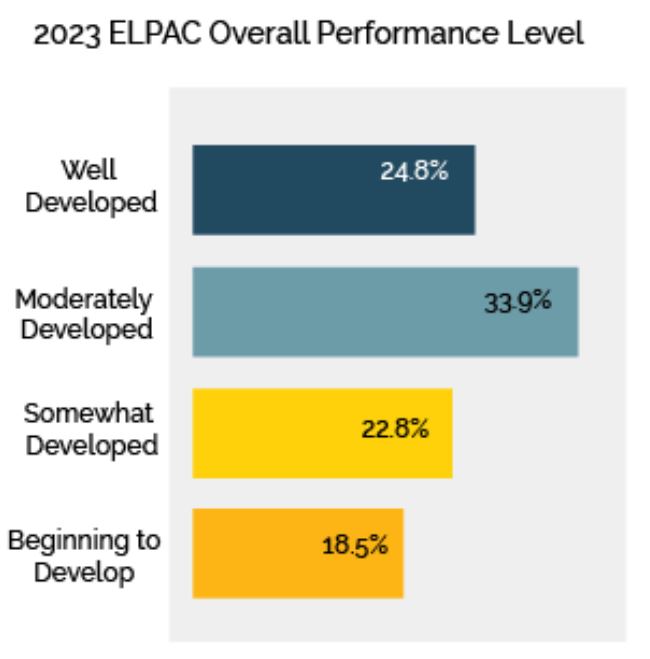
A significant milestone worth highlighting is the progress made in the English Language Proficiency Assessments for California (ELPAC) data. The data revealed that one in four current English language learners within SUHSD are now eligible for consideration to be reclassified.
Statistical analysis has provided compelling evidence that students in classes where teachers actively participate in continuous improvement cycles demonstrate higher levels of growth. This finding holds true for all students, regardless of their backgrounds or characteristics, as the benefits of the improvement cycles extend across diverse student groups.
Building on these promising results, SUHSD is committed to further expanding its support for the scaling implementation of improvement cycles in the 23-24 school year. By collaborating with more teacher teams, SUHSD aims to harness the power of collective improvement efforts and foster a widespread culture of continuous growth, thus ensuring sustained progress and enhanced educational outcomes for all students throughout the district.
BACKGROUND
After the 2018-19 CA Dashboard Data Release, the Salinas Union High School District (SUHSD) became eligible and was referred in late 2019 by their County Office of Education to the CCEE for support via Education Code subdivision (g) of Section 52064.5. The focus student groups for SUHSD are English learners, students experiencing homelessness, and students with disabilities. Since the completion of the SIR report the LEA, in partnership with the Monterey County Office of Education (MCOE) has been engaging in cycles of continuous improvement. This update will focus on providing updates on the latest improvement cycle from August 2023 to November 2023.
DISTRICT AREAS OF FOCUS
The SIR Actions are organized in the themes of Clarity and Coherence, Accountability, and Communication. The team at CCEE is working with all of the school’s Instructional Leadership Teams (ILTs) on identified content areas Problems of Practice with the goal of expanding this work to every content area in every school.
PROGRESS UPDATE
Aligned to the foci listed above, the team at CCEE is working with the team in SUHSD and MCOE on the four domains of Fullan and Quinn’s Coherence (Focusing Direction, Cultivating Collaborative Cultures, Deepening Learning, and Securing Accountability).

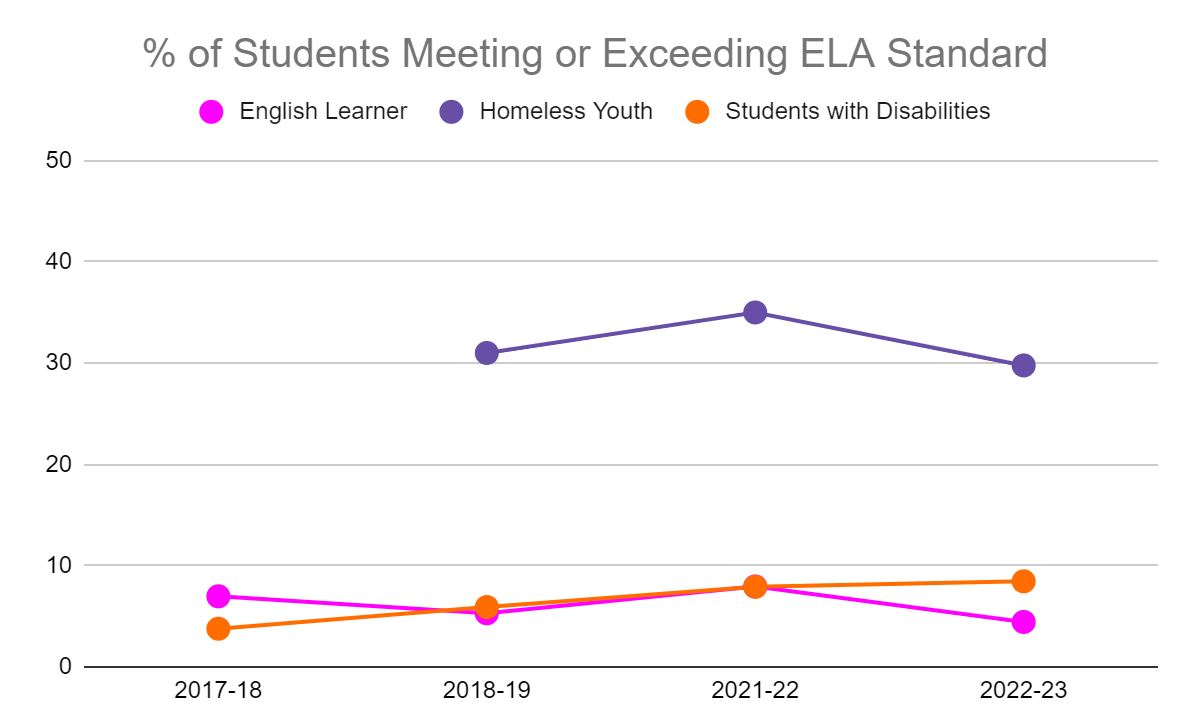
The district leadership team started the year by completing a self-assessment on the Coherence Progression Protocol developed by Fullan and Quinn.
This tool serves as a dynamic record of progress and growth throughout the current school year and as a strategic guide for planning the upcoming academic year. The Education Services team utilizes this tool as a proactive planning mechanism to amplify their focus for the ongoing year.
As the SUHSD team consistently strives to enhance student performance, there are pivotal opportunities to strengthen the connection between district initiatives and student learning outcomes. Our ongoing efforts aim to ensure that the Coherence Progression Protocol serves as the integral “glue” for this work, avoiding the perception of being an additional task.
Looking ahead, our next steps involve visiting the district in January. We plan to conduct classroom walkthroughs and actively participate in the next Instructional Leadership Team convening. These initiatives are essential in providing valuable insights to the CCEE team, enabling us to tailor our support effectively during the upcoming quarter.
BACKGROUND
After the 2018-19 CA Dashboard Data Release, the Salinas Union High School District (SUHSD) became eligible and was referred in late 2019 by their County Office of Education to the CCEE for support via Education Code subdivision (g) of Section 52064.5. The focus student groups for SUHSD are English learners, students experiencing homelessness, and students with disabilities. Since the completion of the SIR report the LEA, in partnership with the Monterey County Office of Education (MCOE) has been engaging in cycles of continuous improvement. This update will focus on providing updates on the latest improvement cycle from December 2023 to February 2024.
DISTRICT AREAS OF FOCUS
The SIR Actions are organized in the themes of Clarity and Coherence, Accountability, and Communication. The team at CCEE has partnered with the county office and the district and continue to focus on building district/site capacity to engage and lead in continuous improvement with Instructional Leadership Teams (ILT’s) through the use of PDSA cycles.
PROGRESS UPDATE
The team at CCEE is working with all of the school’s Instructional Leadership Teams (ILTs). The ILT teams have been supported the last three years by the team at MCOE. Over the three years that support has been gradually phased out. The team in Salinas are now running the professional learning sessions and the implementation in all schools. The practice has been institutionalized throughout their system. Each school’s ILT works with different content areas to identify a Problem of Practice. The team at CCEE continues to join the ILT sessions in person. ILT teams are working on improvement projects in all content areas, and progress is noted in middle school math in the graph included in this update. ILT teams are working on improvement projects in all content areas, and progress is noted in middle school math in the graph included in this update. The graph is cohort matched, meaning the same students who took the CAASPP in spring of last school year are the same students included in the quarter 3 Interim Assessment Benchmark, which is a good predictor of how students will perform on this years CAASPP. As you see in the graph, more than five times the number of students who scored Above standard in 7th grade (5%) are now scoring Above standard in 8th grade (25.4%). Also, a reduction of over 20% of students scoring below standard in 7th grade (53%) compared to 8th grade (32.7%).
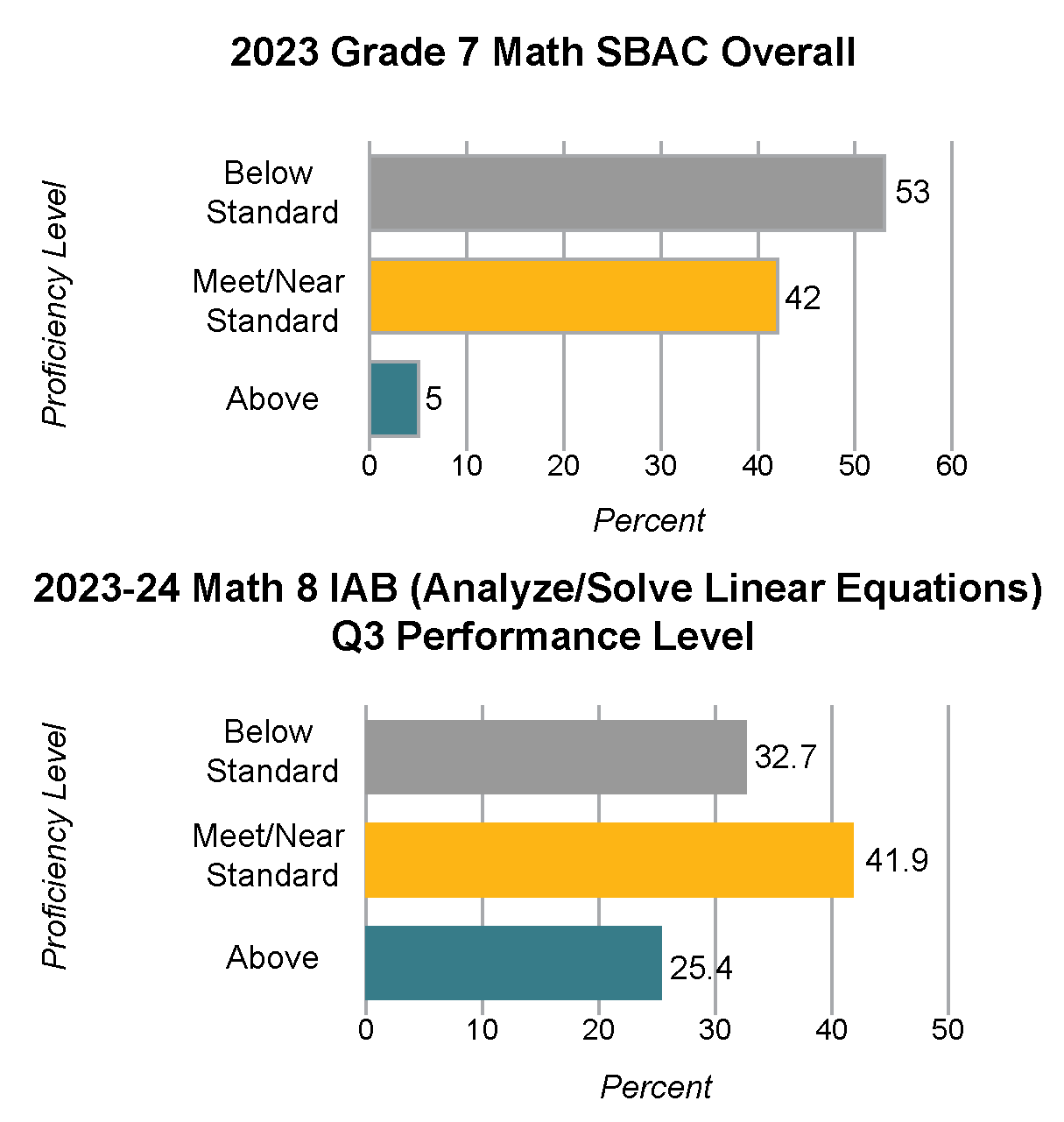
The district leadership team started the year by completing a self-assessment on the Coherence Progression Protocol developed by Fullan and Quinn.
The team at CCEE is regularly connecting with Superintendent Burns to help think through instructional, staffing and supervision challenges. Also, the team at CCEE regularly connects the Education Services team, and the team at the MCOE and are working to support their instructional plan. Those planning sessions are ongoing and will continue through the spring. CCEE is not recommending further intervention by the Superintendent of Public Instruction at this time.
Sacramento City Unified District
BACKGROUND
CCEE received a request for assistance in July of 2019 by the Sacramento County Office of Education and Sacramento City Unified School District pursuant to Education Code 52074(g)(1)(A), which allows for referrals to be made to CCEE for support by the local county superintendent of schools. Sacramento City USD was also referred to CCEE for assistance in 2019 after the 2018-19 California School Dashboard results showed the district failed to meet priority outcomes for a third year in a row. This year marked the third year for the CA Dashboard, which enacted Education Code subdivision (g) of Section 52064.5 (CA School Dashboard) automatically referring the district to CCEE when three or more pupil groups are identified pursuant to Section 52052, in three out of four consecutive school years. The student groups for SCUSD identified are Foster Youth, students experiencing homelessness and students with disabilities. The table below indicates the student groups performance in comparison to the average statewide performance for that student group (the most recent year data are available).
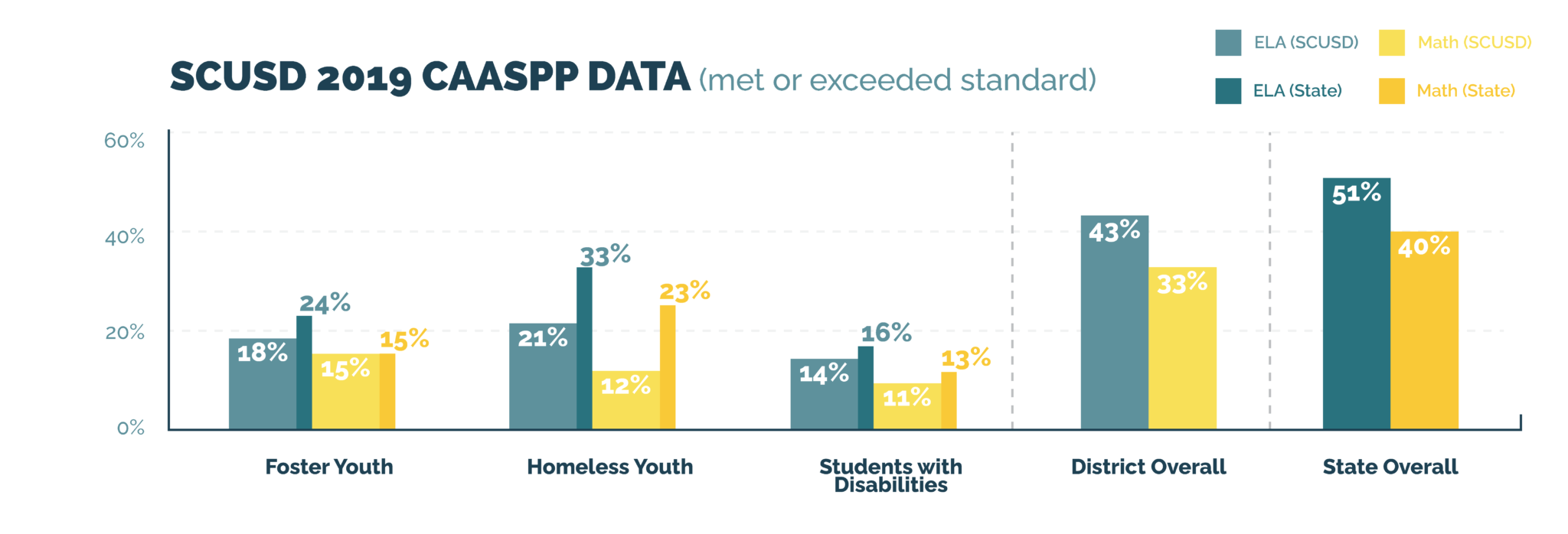
The graphic below shows the enrollment percentage of these student groups relative to the district’s entire student population.
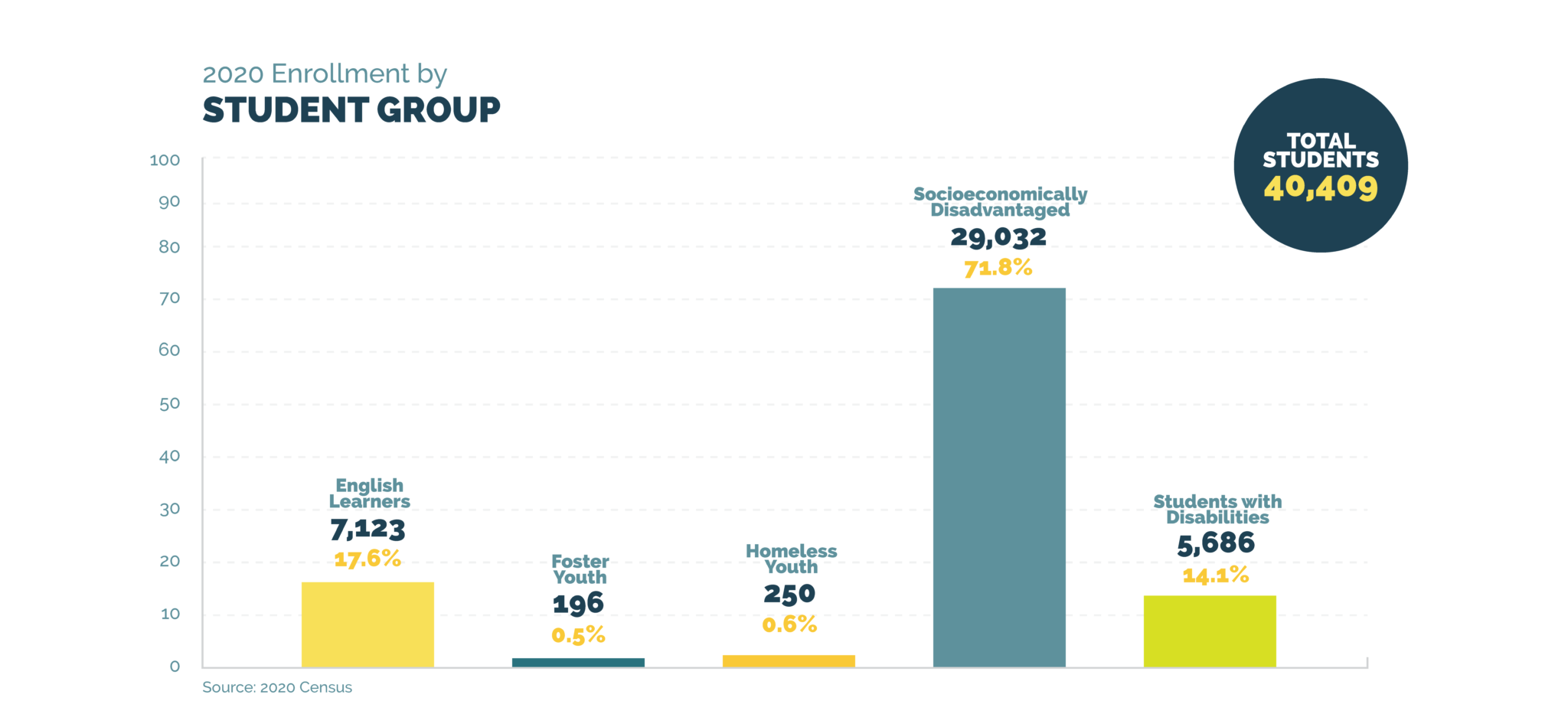
Sacramento City USD serves a diverse student population, with Hispanic students representing the largest portion of the student population, followed by Asian, White and African American students, as reported on the CA Dashboard.
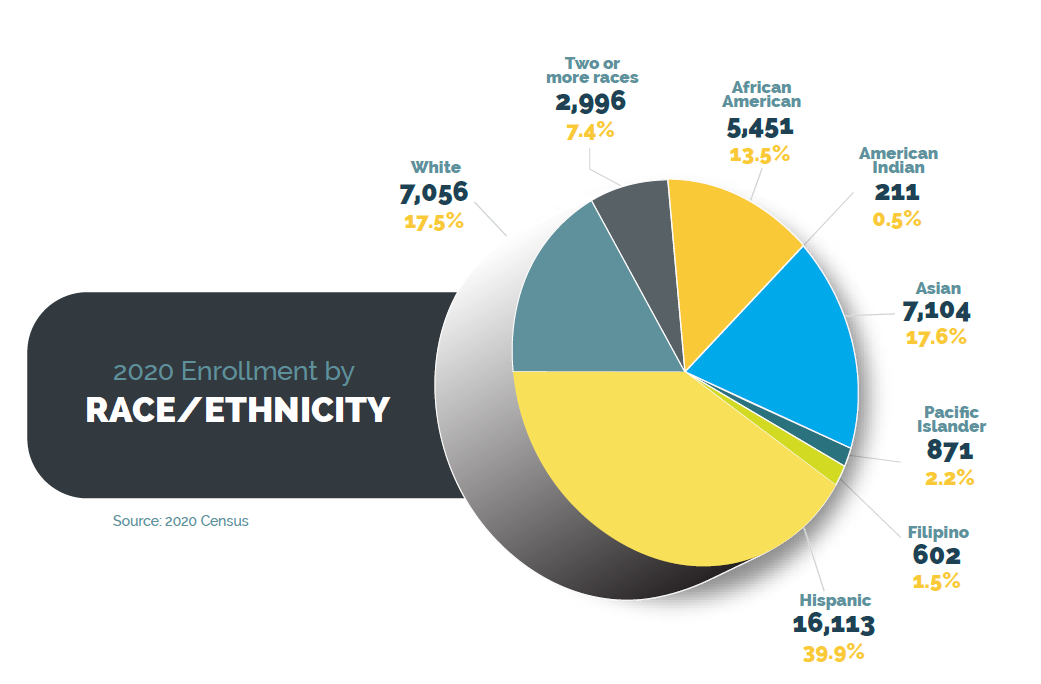
SYSTEMIC INSTRUCTIONAL REVIEW THEMES
The Sacramento City USD SIR report and SCUSD SIR report executive summary were released to the school district and county and posted on the CCEE website on January 12, 2021. Six distinct themes emerged in the SCUSD SIR report along with 79 recommended actions: 1) central office leadership, organization, and systems, 2) assessment and accountability, 3) communication and engagement, 4) instructional practice and strategies, 5) professional learning, development, and support, and 6) continuous improvement and data use.
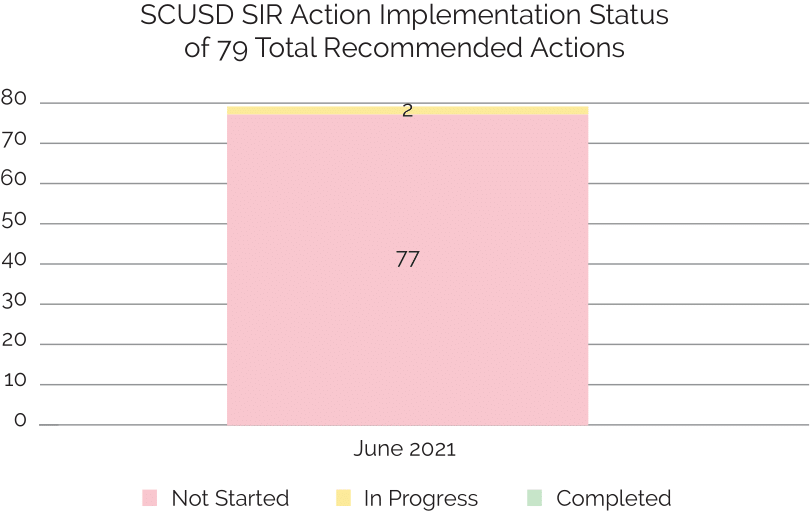
Prior to the formal SIR process, CCEE provided various resources and support to the district. Specifically, SCUSD and Sacramento County Office of Education (SCOE) requested that CCEE provide SCUSD with a professional expert that provided central office leadership with facilitated support. The support requested from the district was to restructure the office that oversees special education including the creation of new job descriptions for an Assistant Superintendent of Special Education and Innovation, administrators of teaching and learning (formerly coordinators of special education) and a Special Education Local Plan Area (SELPA) director. In addition, support requested was provided in accordance with the district’s request to develop a three-year implementation plan for Multi-Tiered Systems of Support (MTSS) that was initiated in Spring 2019. The Distance Learning Plan that integrated Universal Design for Learning (UDL) was also reviewed and feedback provided in November 2020. On-going individualized support was provided to the Chief Academic Officer (CAO), who was new to their role in September 2019. Data and system reviews across the CAO office/ departments have provided a foundation upon which an instructional vision and framework can be built. PreCOVID school visits were regularly conducted with the CAO.
The SCUSD SIR was largely conducted during the disruption to schools caused by the COVID-19 pandemic, and the CCEE professional expert continued to support the restructure of the office that oversees special education including the transition of the soon to be retired Director of Special Education. The professional expert who had been providing support to SCUSD was a part of the team that conducted the SIR.
Since the delivery of the SIR report in January 2021 the CCEE met with SCUSD leadership on four different meeting dates to provide guidance and feedback on identifying, prioritizing and developing an implementation plan for integrating district and SIR priorities. CCEE conducted the first progress monitoring quarterly update of SCUSD in early June 2021 where the SCUSD team shared a plan to align the SIR actions to the 2021-22 LCAP. SCUSD also provided a timeline of when they will provide CCEE with a SIR implementation plan for feedback. SCUSD reviewed how the newly revised office that oversees special education organizational structure, that has developed Key Performance Indicators for the office of student support services and created targeted efforts to strengthen the development, implementation, and monitoring of the Single Plan for Student Achievement (SPSA) have all intended to pave the way for increased focus on the SIR recommended actions. Additionally, a strength for SCUSD is in the various data systems available in the district that could be built upon and utilized to improve student outcomes for students. All of these lend themselves to move systemic and organizational processes forward in the 21-22 school year.
The identified weaknesses for this cycle of implementation, from March to June 2021, largely result from a lack of evidence submitted across each SIR domain that demonstrate development, implementation or monitoring of effective instructional practices identified in the SIR recommended actions. The evidence provided did not address key areas such as central office leadership, organizations and systems, and items therein (e.g., key next steps for the development of the roadmap, the identification of a cross-functional team to support implementation).
Identified threats to the SCUSD SIR recommended action implementation, therefore, revolve around the lack of an organized approach to instructional improvement efforts and a lack of a clear instructional vision with aligned, accountable and clearly articulated expectations. The district also lacks the structures/ metrics for integrating current efforts across the district, including MTSS and SPSAs are a threat to improving student outcomes in SCUSD. While there was evidence submitted for the district’s theory of action, evidence is lacking that would indicate it lives across the central office department and current efforts underway. These continue to be a threat to systemically organizing all central office leadership in a manner that intentionally facilitates the implementation of the theory of action. For example, the lack of operationalized written processes for the expectation and use of available data, protocols, including accountability reports aligned to district goals and benchmarks for teaching and learning, is a threat to the operationalization of the district’s theory of actions and improving student outcomes.
SCUSD has many opportunities to develop and implement written uniform expectations and support to build the capacity of district and school leaders to use data to drive decision making. This includes but is not limited to processes and protocols for the use of data and regularly scheduled reviews of data to monitor implementation of the SIR, LCAP and SPSAs. Tied to this is the opportunity to address data governance priorities by increasing the district and site leadership’s skill, capacity and data expertise. CCEE remains prepared to build from these opportunities and assist the district in being able to prioritize SIR priorities based on their LCAP and instructional strategic efforts but believe the fundamental threats to progress must first be addressed.
NEXT STEPS
The District has been leveraging all opportunities for District leadership professional learning to create and refine a district problem of practice that prioritizes MTSS and an intensive professional learning school model. CCEE has been working in partnership/collaboration with District Leadership and the Sacramento County Office of Education to support and assist. In this update, the district progressed in developing the District Leadership Team to mobilize priorities and the District successfully launched the intensive support model at two school sites for this quarter. These graphs show each school’s progress on the PLC needs assessment from the beginning of this school year to the middle of this year.
The CCEE shared concerns on the lack of evidence provided for the implementation of SIR actions and the need to continue developing a plan of action for the execution of district instructional improvement strategies and theory of action. To aid this work, CCEE reinforced the SIR action recommendation that SCUSD establish a cross-functional team to comprehensively address the district’s instructional priorities, including the LCAP and Differentiated Assistance process, and actions aligned with district priorities. Furthermore, CCEE reiterated the role of the key actions within the SIR to develop an instructional roadmap that clearly communicates the vision, strategies, tools, and practices, with clear expectations and accountability for implementation. The roadmap should include how cycles of improvement will be utilized for professional learning for school site leadership and central office to increase their knowledge and skills on data-based decision making to monitor continuous improvement at the district, school and classroom levels. These data are critical to the district’s progress toward improving student outcomes, including students with disabilities, homeless and foster youth, and accountability for teaching and learning. CCEE remains committed to assisting the district with additional supports that are aligned to the district’s instructional priorities and SIR actions. CCEE will continue to follow up with the district based on the presented timelines to help deepen district engagement in SIR recommended action implementation.
BACKGROUND
CCEE received a request for assistance in July of 2019 by the Sacramento County Office of Education and Sacramento City Unified School District (SCUSD) pursuant to Education Code 52074(g)(1)(A), which allows for referrals to be made to CCEE for support by the local county superintendent of schools. In addition, the SCUSD became eligible and was referred by their County Office of Education to the CCEE for support via Education Code subdivision (g) of Section 52064.5 The identified student groups for SCUSD are Foster Youth, students experiencing homelessness, and students with disabilities. This update will focus on providing updates on the latest improvement cycle from August 2022 to November 2022.
DISTRICT AREAS OF FOCUS
The SCUSD team is developing and implementing a district wide, strategic, three-year professional learning plan that defines high-quality, tier-one instruction for students within a multi-tiered system of supports. The professional learning plan is focused on empowering site leaders to engage staff in creating site-based, district-aligned instructional frameworks tied to the School Plan for Student Achievement. The District also effectively launched and directly supported the intensive support model work at Elder Creek and H.W. Harkness Elementary Schools.

PROGRESS UPDATE
The District has been leveraging all opportunities for District leadership professional learning to create and refine a district problem of practice that prioritizes MTSS and an intensive professional learning school model. CCEE has been working in partnership/collaboration with District Leadership and the Sacramento County Office of Education to support and assist. In this update, the district progressed in developing the District Leadership Team to mobilize priorities and the District successfully launched the intensive support model at two school sites for this quarter.
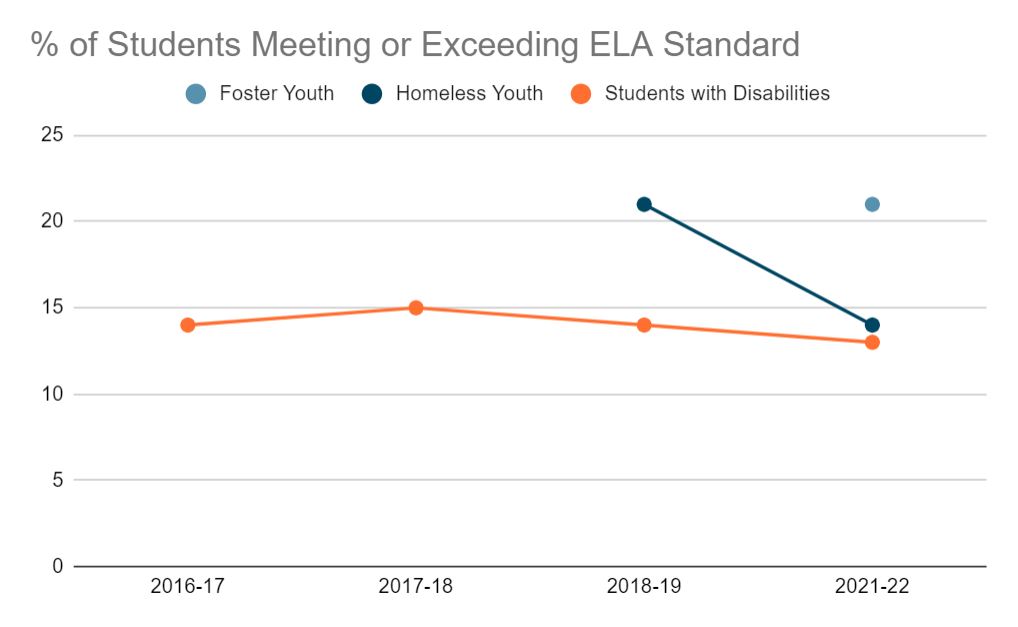
The District completed training for a third and final MTSS cohort this past quarter with several earlier cohorts receiving ongoing support and assessment on implementation progress. In addition, the guiding coalitions were formed at both intensive support model schools, and the opportunity will continue to deepen instruction and student learning.
Next steps include analysis of the most recent MTSS implementation data and continued development of professional learning to deepen implementation with data use. As the intensive support model schools are developed, we will capture and share the journey of implementation, the expected outcomes, and the results from learning to implement this intensive support model.
NEXT STEPS
The District has been leveraging all opportunities for District leadership professional learning to create and refine a district problem of practice that prioritizes MTSS and an intensive professional learning school model. CCEE has been working in partnership/collaboration with District Leadership and the Sacramento County Office of Education to support and assist. In this update, the district progressed in developing the District Leadership Team to mobilize priorities and the District successfully launched the intensive support model at two school sites for this quarter. These graphs show each school’s progress on the PLC needs assessment from the beginning of this school year to the middle of this year.
BACKGROUND
CCEE received a request for assistance in July of 2019 by the Sacramento County Office of Education and Sacramento City Unified School District (SCUSD) pursuant to Education Code 52074(g)(1)(A), which allows for referrals to be made to CCEE for support by the local county superintendent of schools. In addition, the SCUSD became eligible and was referred by their County Office of Education to the CCEE for support via Education Code subdivision (g) of Section 52064.5 The identified student groups for SCUSD are Foster Youth, students experiencing homelessness, and students with disabilities. This update will focus on providing updates on the latest improvement cycle from December 2022 to February 2023.
DISTRICT AREAS OF FOCUS
The SCUSD team is implementing a district wide, strategic, three-year professional learning plan that defines high-quality, tier-one instruction for students within a multi-tiered system of supports. The professional learning plan is focused on empowering site leaders to engage staff in creating site-based, district-aligned instructional frameworks tied to the School Plan for Student Achievement.
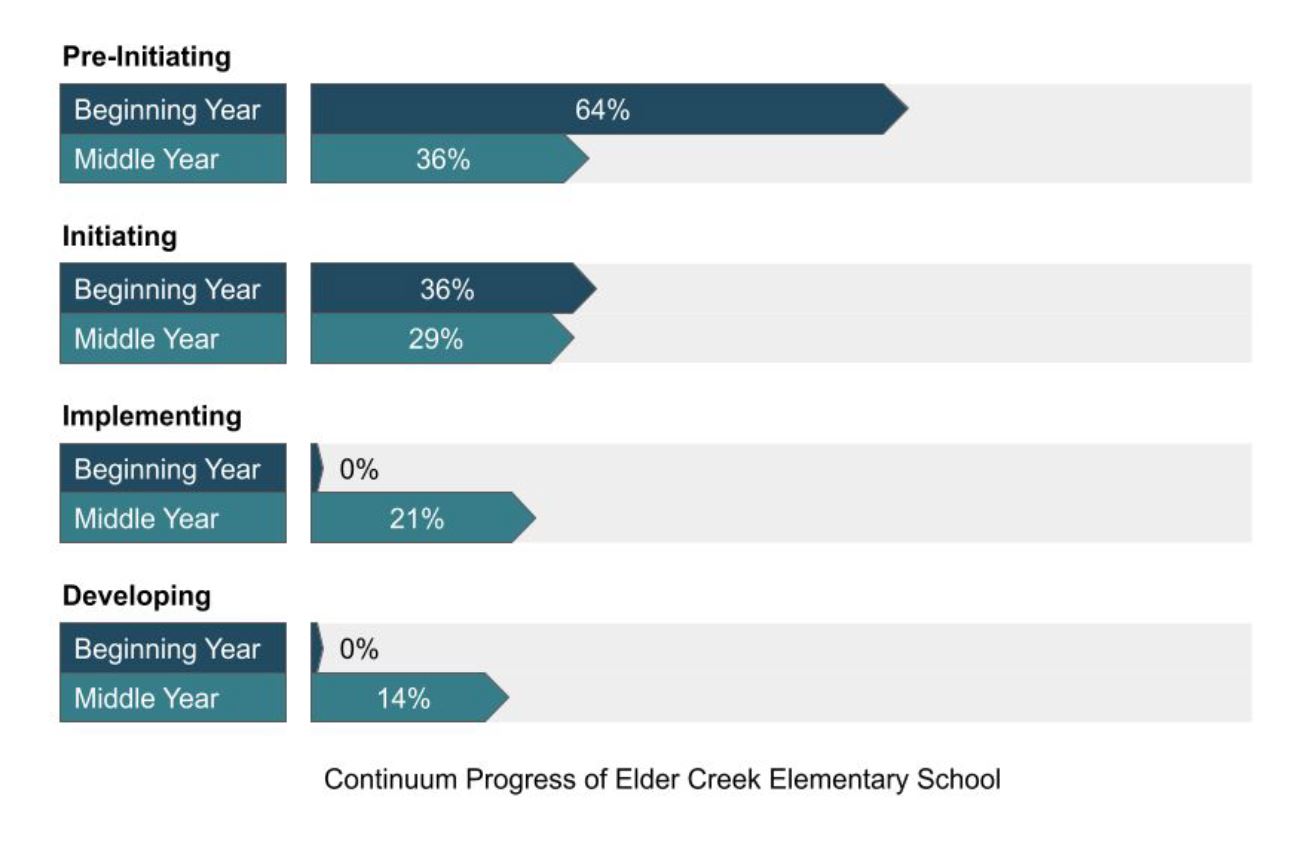
PROGRESS UPDATE
The District has been leveraging all opportunities for District leadership professional learning to create and refine a district problem of practice that prioritizes MTSS and an intensive professional learning school model. CCEE has been working in partnership/collaboration with District Leadership and the Sacramento County Office of Education to support and assist. In this update, the district progressed in developing the District Leadership Team to mobilize priorities and the District successfully launched the intensive support model at two school sites for this quarter. These graphs show each school’s progress on the PLC needs assessment from the beginning of this school year to the middle of this year.
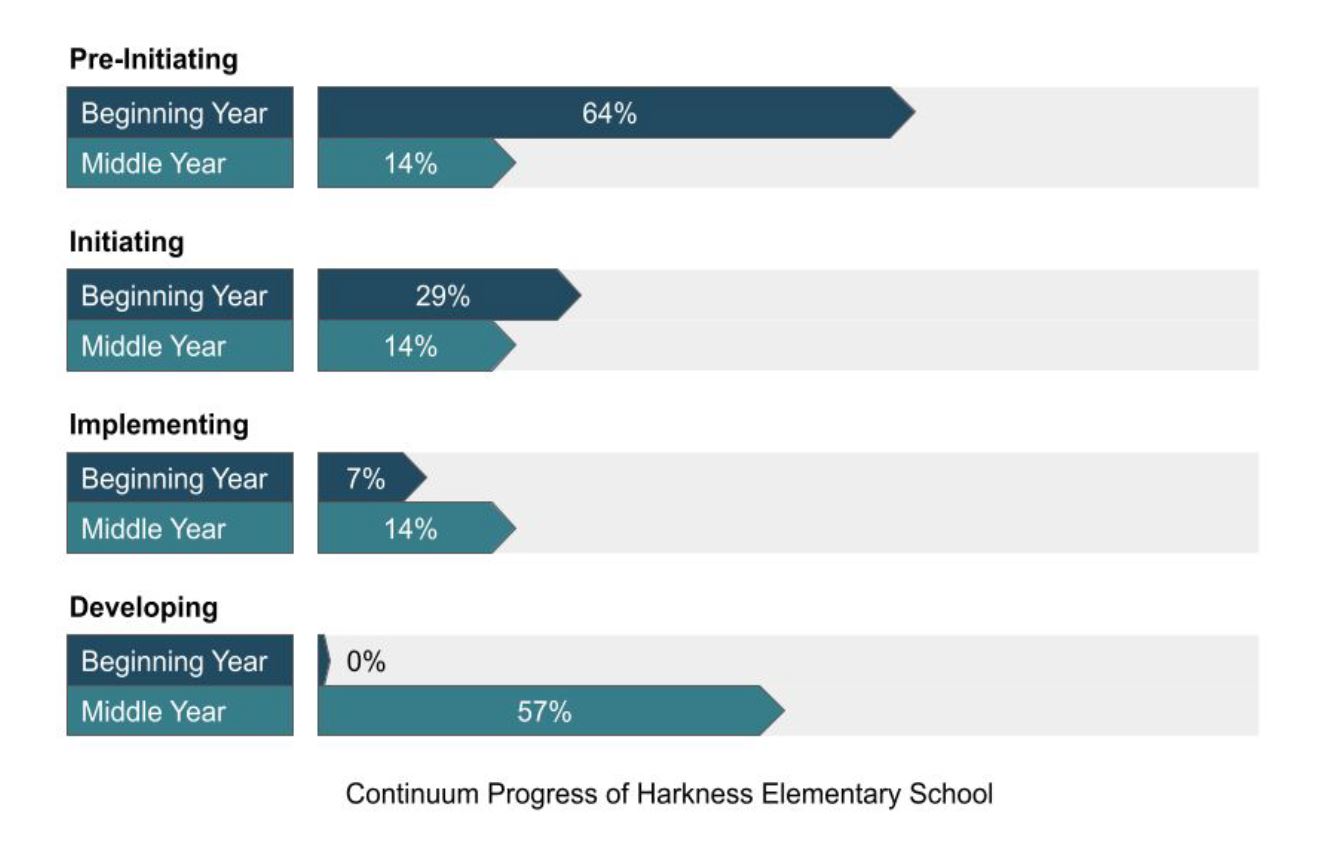
The Intensive Support schools each have guiding coalitions that are deeply engaged in the work of deep collaboration around teaching and learning. They have identified priority standards in Language Arts and Math and have seen growth in their students’ performance throughout the short time engaged in PLC work.
There is an opportunity to learn from the school sites engaged in the Intensive Support work to scale the work around collaboration, teaching and learning. There is an opportunity for continued growth and understanding of the connection between MTSS and the Intensive Support work so that teachers and students can identify needs and respond with appropriate support and resources.
The district is set to continue the work and professional learning around MTSS as well as use what is learned from the Intensive Support schools to scale the work and add more school sites for the upcoming school year.
BACKGROUND
CCEE received a request for assistance in July of 2019 by the Sacramento County Office of Education and Sacramento City Unified School District (SCUSD) pursuant to Education Code 52074(g)(1)(A), which allows for referrals to be made to CCEE for support by the local county superintendent of schools. In addition, the SCUSD became eligible and was referred by their County Office of Education to the CCEE for support via Education Code subdivision (g) of Section 52064.5 The identified student groups for SCUSD are Foster Youth, students experiencing homelessness, and students with disabilities. This update will focus on providing updates on the latest improvement cycle from March 2023 to May 2023.
DISTRICT AREAS OF FOCUS
The SCUSD team is completing the first year implementation of an intensive assistance model at Harkness and Elder Creek Elementary Schools. These efforts represent a district strategy to offer high-quality, tier-one instruction for students that is driven by collaborative staff processes that measure student progress and growth.
PROGRESS UPDATE
Formations of a “Guiding Coalition” at both school sites has helped to drive the type of collaborative staff work to focus instruction and use student outcomes from formative assessments to address learning gaps. During this period both schools made progress to ensure instruction was more directed, and that all students were being supported. The Guiding Coalition helps to make decisions that impact the work of instruction and helps reduce barriers that might detract from the focus. The use of i-Ready interim assessments was reintroduced at the beginning of the school year, and is in an early stage for results.
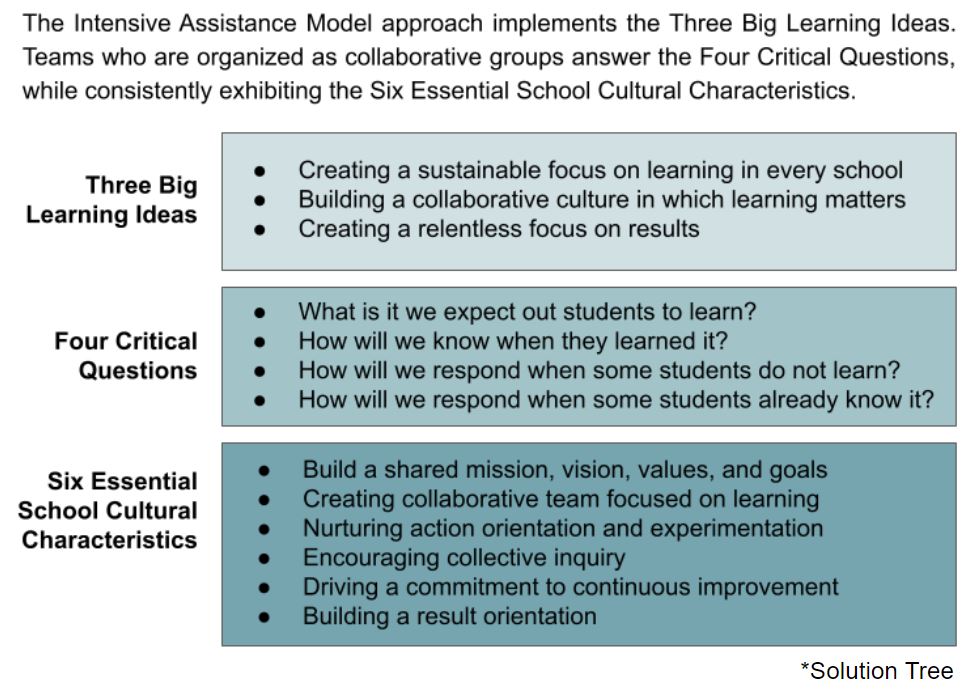
Both schools have the opportunity to sustain momentum from the intensive collaborative work by keeping leadership stable and ensuring that teachers have what they need to move student outcomes. A prime example is the re-introduction of the i-Ready assessment tool that will help teachers to measure student progress and to determine growth. The results of these efforts are forthcoming, but will be important to establish results.
The District is currently developing a Professional Learning Plan to add focus to the Intensive Assistance Model work and Multi-Tiered System of Support (MTSS). First, determining the professional learning needs of the Intensive Assistance model is important to inform the larger Plan, and will help when the model is scaled to other sites. Second, since the District has also completed training to all site leaders in the District to implement MTSS there is a need to keep support and training in place to be responsive to ongoing site and staff needs to reinforce first best instructional practices.
Next steps are to collect and analyze local i-Ready assessment data to influence future topics in the Professional Learning Plan. In other words, tying assessment to the Professional Learning Plan is important.
BACKGROUND
CCEE received a request for assistance in July of 2019 by the Sacramento County Office of Education and Sacramento City Unified School District (SCUSD) pursuant to Education Code 52074(g)(1)(A), which allows for referrals to be made to CCEE for support by the local county superintendent of schools. In addition, the SCUSD became eligible and was referred by their County Office of Education to the CCEE for support via Education Code subdivision (g) of Section 52064.5. The student groups for SCUSD are Foster Youth, students experiencing homelessness, and students with disabilities. This update will focus on providing updates on the latest improvement cycle from August 2023 to November 2023.
DISTRICT AREAS OF FOCUS
The SCUSD area(s) of focus for improvement work includes: 1) Continued implementation of Multi-Tier System of Support (MTSS) at the school site level; 2) Intensive Assistance Model (IAM) second year of implementation at two school sites in the district; and, 3) Development of goals and outcomes for special education focus and to help coordinate support providers.
PROGRESS UPDATE
SCUSD is currently undergoing a Superintendent transition but continues to make implementation gains in the area(s) of focus. MTSS implementation continues with the first, best instruction and intersects with the focus on special education. Efforts to set and achieve incremental gains in special education compliance areas have been a focus for CCEE support. The Intensive Assistance Model is in its second year of implementation at Harkness and Elder Creek Schools and is showing positive progress at the classroom level. Each area shows momentum, and we anticipate a similar focus as we enter 2024.
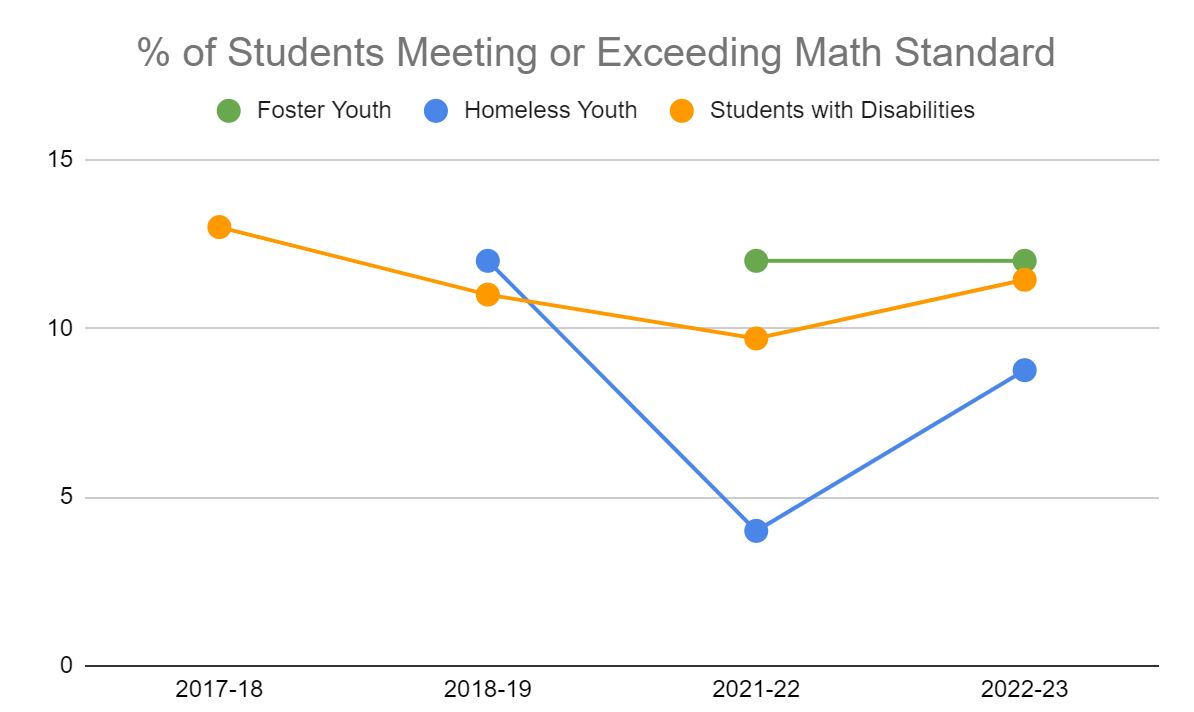
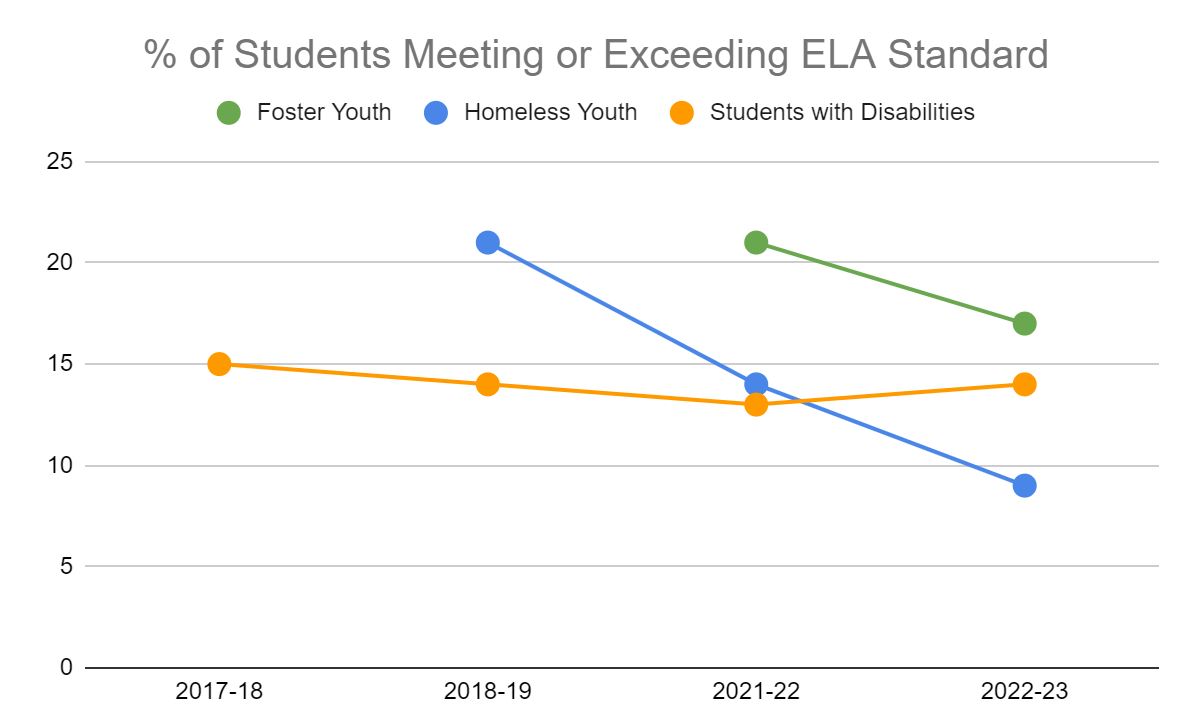
There is an opportunity for the district to keep building positive momentum for the areas of focus to reach the student outcomes.
The district leadership has set quarterly goals that are reviewed weekly for outcomes. CCEE will continue to collaborate with Sacramento COE and Sacramento City USD around improvement efforts and to assist the district in reaching outcomes for students.
CCEE is not recommending further intervention by the Superintendent of Public Instruction.
BACKGROUND
CCEE received a request for assistance in July of 2019 by the Sacramento County Office of Education and Sacramento City Unified School District (SCUSD) pursuant to Education Code 52074(g)(1)(A), which allows for referrals to be made to CCEE for support by the local county superintendent of schools. In addition, the SCUSD became eligible and was referred by their County Office of Education to the CCEE for support via Education Code subdivision (g) of Section 52064.5 The identified student groups for SCUSD are Foster Youth, Students Experiencing Homelessness, and Students with Disabilities. This update will focus on providing updates on the latest improvement cycle from December 2023 to February 2024.
DISTRICT AREAS OF FOCUS
Sacramento City Unified School District continues to prioritize Students with Disabilities and Multi-Tiered System of Support (MTSS). CCEE helps to coordinate and facilitate a group of support providers who push into the district in different ways around these efforts. Additionally, the district is in Year 2 to implement the Intensive Assistance Model (IAM) at Harkness and Elder Creek Elementary Schools with a focus on first best instructional practices.
PROGRESS UPDATE
In February 2024, district leadership reviewed the quarterly goals referenced
in December 2023, placing a greater emphasis on smaller goals that drive more immediate change this quarter. CCEE continues to collaborate with support providers, including the Sacramento County Office of Education, to assist with the development of these goals.
.
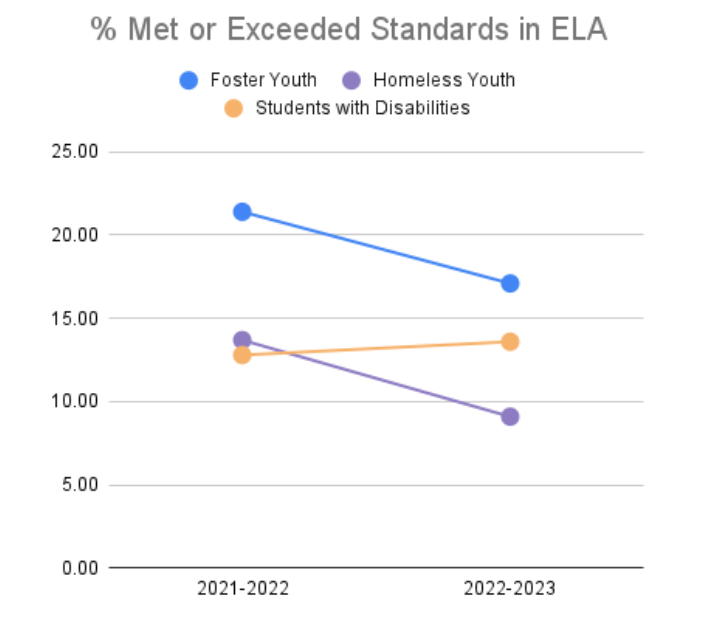
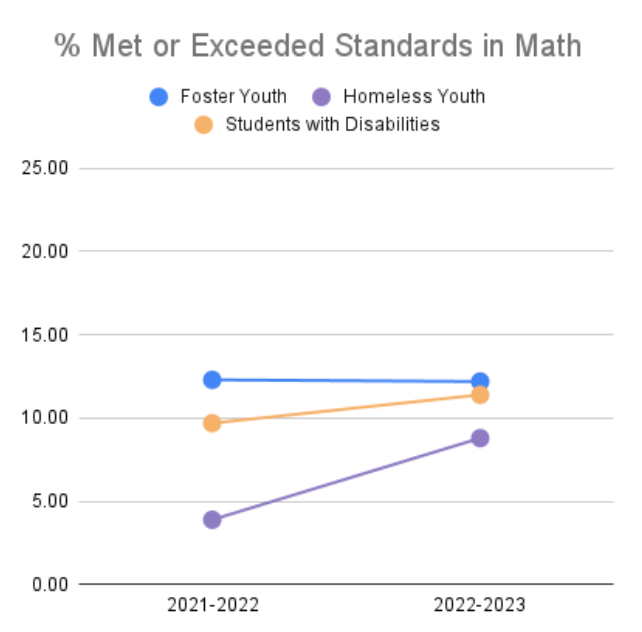
The district is planning to expand MTSS work district-wide. A district-wide kickoff meeting with labor took place on March 19, 2024 and follows a recent MOU with the Sacramento City Teachers Association (SCTA) that included language on MTSS design and implementation. District leadership is optimistic to collaboratively advancing MTSS priorities.
2022-23 State Data Dashboard indicates declines in ELA proficiency for Foster Youth and Homeless Students, but there are increases in Mathematics proficiency for Homeless Students. Students with Disabilities have shown improvements in both ELA and Mathematics, reinforcing the district’s explicit strategy on MTSS design and implementation.
Despite the continued Superintendent vacancy, the district is reporting that
key positions to support special education are filled. The MTSS expansion will become an extension of the focus in special education. The district is optimistic on next steps in that area, and the June quarterly update will have more information about MTSS and special education developments.
CCEE will continue to coach the district to grow the MTSS district-wide design, to continue the IAM implementation, and to help facilitate communication between special education support providers and the district. CCEE is not recommending further intervention by the Superintendent of Public Instruction at this time.
Oakland Unified School District
BACKGROUND
Oakland Unified School District (OUSD) became eligible for CCEE assistance in late 2019 after 2018-19 California School Dashboard data showed the district failed to meet state priority outcomes for a third year in a row. This year marked the third year for the CA Dashboard, which enacted Education Code subdivision (g) of Section 52064.5 (CA School Dashboard) for three or more pupil groups identified pursuant to Section 52052, in three out of four consecutive school years, the district is eligible for support from CCEE. The student groups for OUSD are English learners, students experiencing homelessness and African American students. The table below indicates the student groups performance in comparison to the average statewide performance for that student group (the most recent year data are available).
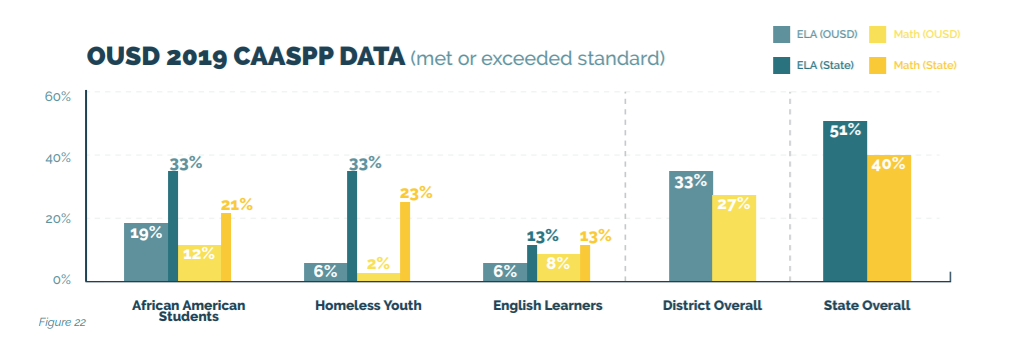
The graphic below shows the enrollment percentage of these student groups relative to the district’s entire student population.
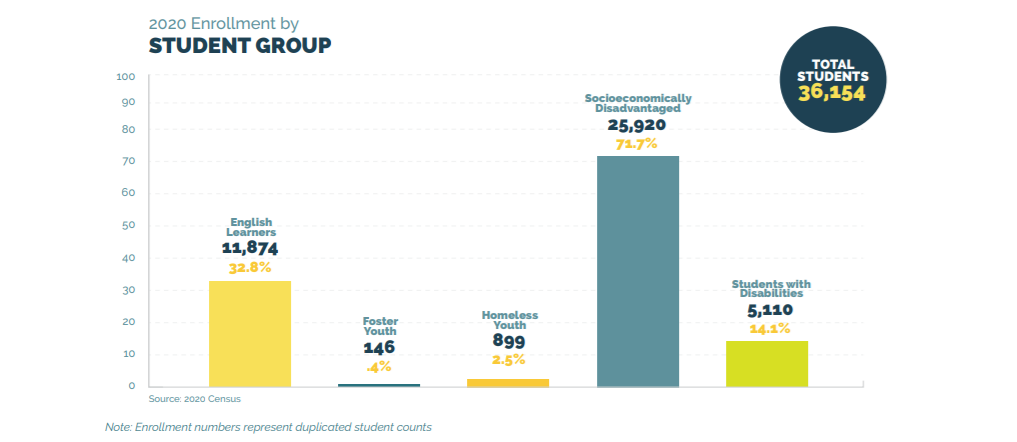
Oakland USD serves a diverse student population, with 44 percent of its students being Hispanic, and nearly one-fourth of the student body being African American, as reported on the CA Dashboard.
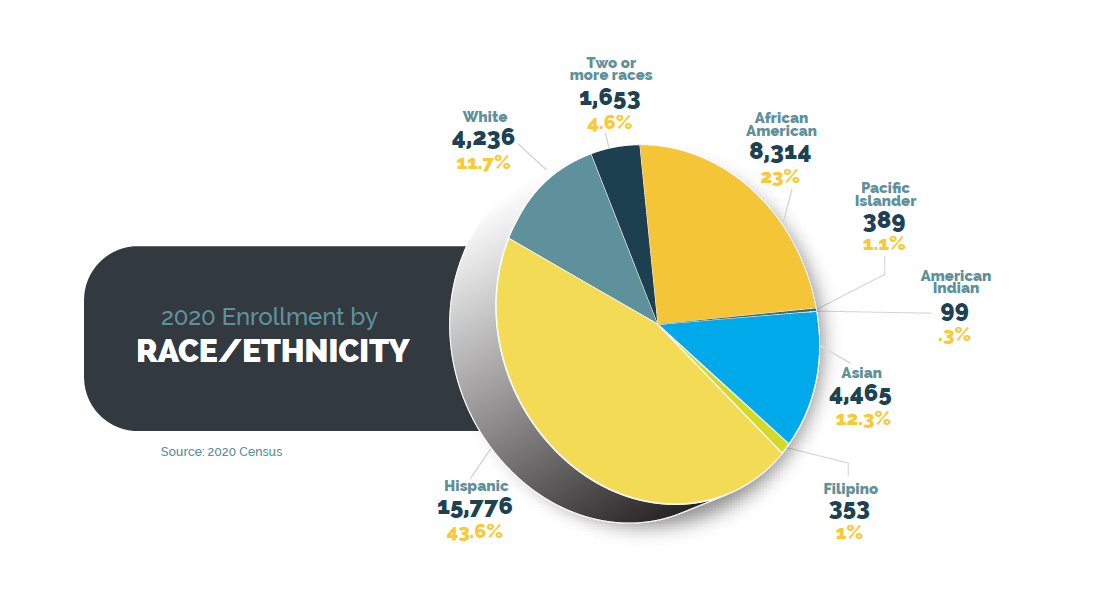
SYSTEMIC INSTRUCTIONAL REVIEW THEMES
The OUSD SIR Report and OUSD SIR Report executive summary were finalized in late January 2021. Three themes emerged in the OUSD SIR Report as a result of data collection: 1) coherence, 2) autonomy, and 3) accountability.
PROGRESS UPDATE

CCEE conducted the first progress monitoring quarterly update of Oakland USD implementation of the SIR recommended actions in early June 2021. From the implementation data gathered, areas of strength included instructional priorities being identified and all sub teams within the OUSD Continuous School Improvement team (CSI) working to build coherence through defining Multi-Tiered Systems of Support (MTSS), e.g., what does Tier 1 instruction look like at OUSD for all students and for particular student groups, and identify foundational professional development to support the implementation of instructional priorities. Additionally, the superintendent deepened strategic partnerships with local advocacy groups to address the developing OUSD strategic plan, including its alignment to the LCAP and SIR actions.
A threat to OUSD building coherence is the need to build from the Instructional Focus Plan and focus on implementation at the school and classroom level. This should include agreement between the central office and school site, on specific expectations for classroom, school, and district instructional practices, curriculum assessment, professional development, and inquiry cycles aligned to pupil achievement targets. In addition to this, OUSD will need strategic planning to address the sustainability and impact of the positions and support provided through short-term funding.
Areas of opportunity that were identified include broadening and growing instructional alignment and accountability through cross-departmental collaboration to networks and school site teams; continuing to use the developing 2021-24 LCAP as a guiding document to create alignment of the Instructional Focus plan; and provide non-negotiable expectation on instructions and assessment to Network Superintendents as they directly support schools. Lastly, OUSD is primed to deepen the collaborative work with the Alameda County Office of Education focused on creating clear short and longterm metrics for measurement of student improvement that is built from the Instructional Focus Plan (e.g., LCAP, Focus Priorities, MTSS).
CCEE has provided support to OUSD by funding the position of a SIR Program Director. The Director works directly with OUSD on a daily basis to support OUSD as they work to implement the recommendations from the SIR. This position is a partnership between Alameda COE, OUSD, and CCEE and works directly with the OUSD Chief Academic Officer and Alameda COE’s Executive Director of Research, Assessments, Accountability and Partnerships. There have been ongoing, frequent meetings between the new SIR Program Director, the CCEE Lead Professional Expert, and Alameda COE’s Executive Director of Research to advise and assist the SIR Program Director in supporting OUSD in implementing the recommendations from the SIR, including supporting progress monitoring conversations and collecting evidence for the quarterly update.
These efforts demonstrate how the SIR actions are also being leveraged within Alameda COE’s Differentiated Assistance support and in alignment with OUSD’s strategic efforts to improve pupil achievement.
NEXT STEPS
Once the OUSD LCAP is finalized we recommend mapping the Instructional Focus Plan back to the new LCAP priorities, including focus priorities and Multi-Tiered Systems of Support (MTSS), and established pupil achievement targets. As the OUSD team continues to focus on its instructional priorities, implementation at the school level and by school instructional teams will be critical. To support this implementation we recommend increasing Network Superintendent meeting times to address common school site expectations based on OUSD goals, such as foundational professional development and MTSS development, that include steps for cycles of inquiry to drive decisions, and progress monitoring to address pupil achievement needs.DTA Report Collaborative Planning Support Updates – Jan 2025
BACKGROUND
After the 2018-19 CA Dashboard Data Release, Oakland Unified School District (OUSD) became eligible and was referred in late 2019 by their County Office of Education to the CCEE for support via Education Code subdivision (g) of Section 52064.5. The student groups identified for OUSD are African American students, English Learners, and students experiencing homelessness. Since the completion of the Systemic Instructional Review (SIR) report, and in partnership with the Alameda County Office of Education (ACOE), the LEA has been engaging in cycles of continuous improvement. This update will focus on providing updates on the latest improvement cycle from August 2022 to November 2022.
DISTRICT AREAS OF FOCUS
The SIR Actions are organized in the themes of Coherence (30 actions), Accountability (18 actions), and Autonomy (10 actions). The team at CCEE is working with the district’s Continuous School Improvement Team on the areas of early literacy, A-G course access, graduation rate, middle school math, and joyous schools.
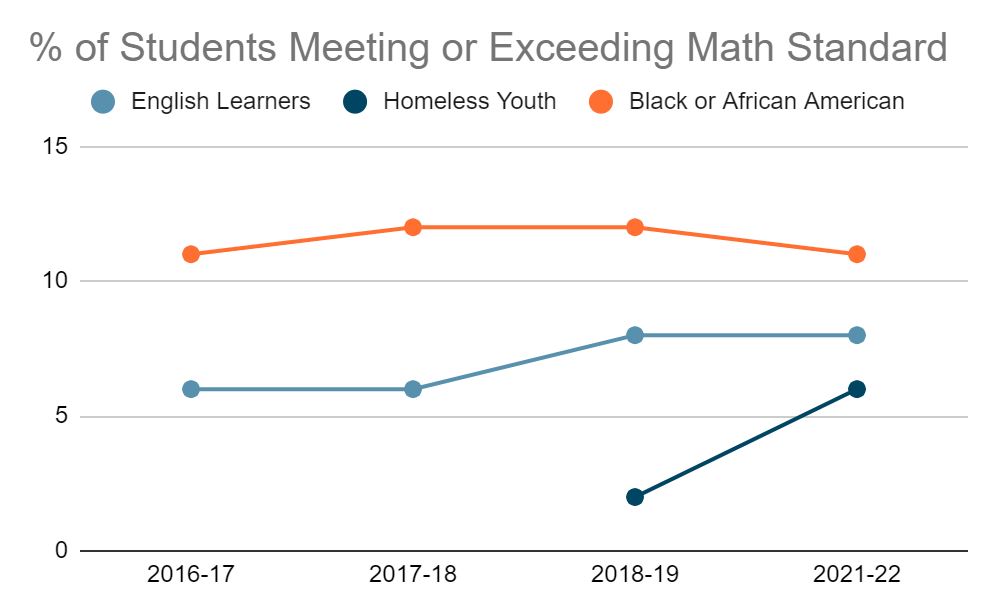
PROGRESS UPDATE
OUSD is actively working on implementing five of the SIR actions focusing on cycles of continuous improvement. CCEE has been working in partnership/collaboration with OUSD and ACOE on supporting OUSD and the Continuous School Improvement (CSI) team.
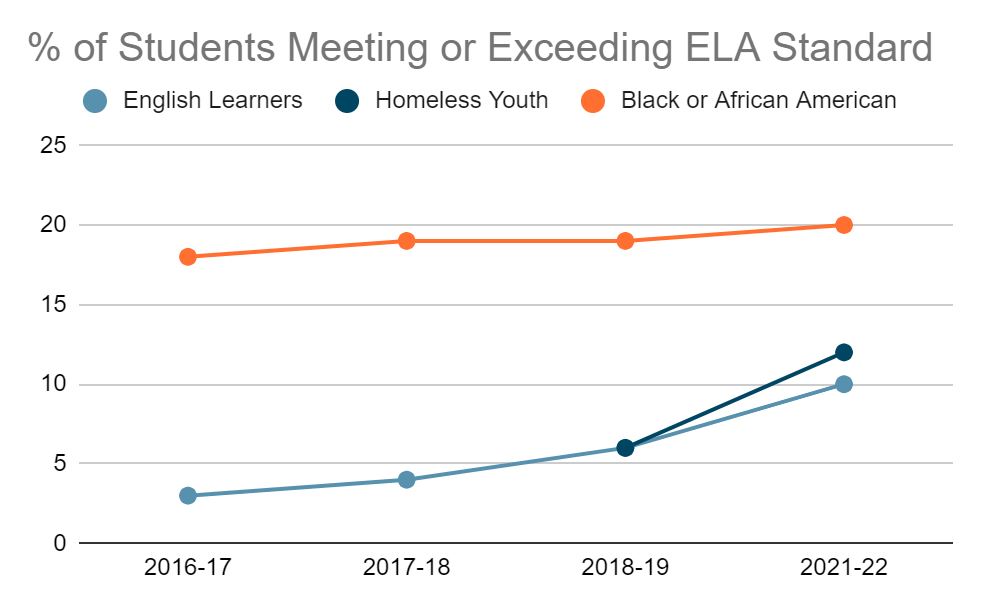
During the Continuous School Improvement Team meetings data is analyzed in the areas of early literacy, A-G course access, graduation rate, middle school math, and joyous schools. Based on the data best practices and areas of improvement are identified and discussed along with any necessary change actions. The team then creates a plan for the next short cycle. Members of the Continuous School Improvement Team host principals bi-weekly to discuss progress and collaborate on any questions.
For next steps, CCEE plans to take a more active role during the CSI meetings in supporting the teams with the Plan, Do, Study, Act process (PDSA) with an intentional focus on ensuring all actions have clarity about how they will impact teacher practice. This effort is to support the members of the team being clear on what needs to happen between the development of the short cycle actions, the new learning necessary for teachers, and any extra support they need to maximize success for students.
BACKGROUND
After the 2018-19 CA Dashboard Data Release, Oakland Unified School District (OUSD) became eligible and was referred in late 2019 by their County Office of Education to the CCEE for support via Education Code subdivision (g) of Section 52064.5. The student groups identified for OUSD are African American students, English Learners, and students experiencing homelessness. Since the completion of the Systemic Instructional Review (SIR) report, and in partnership with the Alameda County Office of Education (ACOE), the LEA has been engaging in cycles of continuous improvement. This update will focus on providing updates on the latest improvement cycle from December 2022 to February 2023.
DISTRICT AREAS OF FOCUS
The SIR Actions are organized in the themes of Coherence (30 actions), Accountability (17 actions), and Autonomy (2 actions). The team at CCEE is working with the district’s Continuous School Improvement Team on the areas of early literacy, A-G course access, graduation rate, middle school math, and joyous schools.
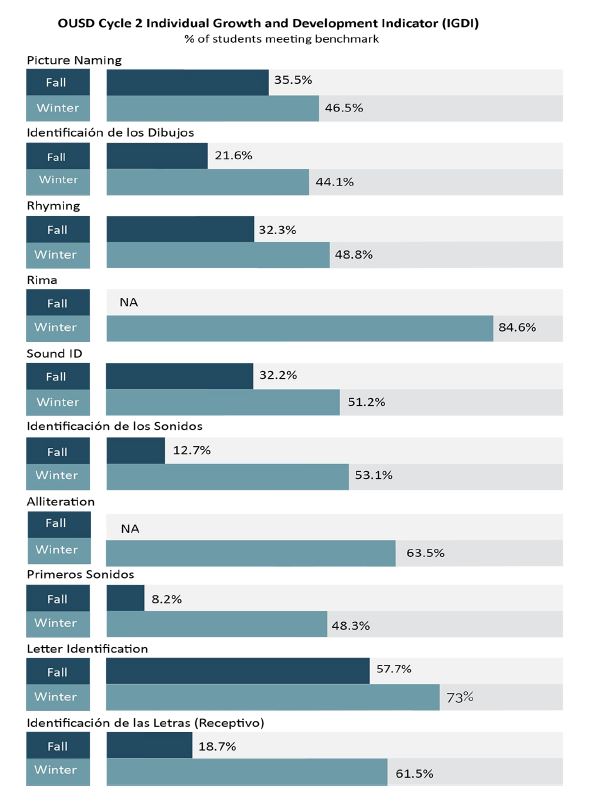
PROGRESS UPDATE
OUSD is actively working on implementing five of the SIR actions focusing on cycles of continuous improvement. CCEE has been working in partnership/collaboration with OUSD and ACOE on supporting OUSD and the Continuous School Improvement (CSI) team.
One of the areas the Continuous School Improvement Team is focused on is aligned with the district’s priority of early literacy. This focus is resulting in growth in early literacy. Please see the graph to the right, which illustrates the Individual Growth and Development Indicators (IGDI) for Oakland Unified’s youngest scholars.
The Joyous Schools Continuous School Improvement Team subgroup is looking into suspension rates at schools showing disproportionality among different student groups. The team is going to schools that are successfully eliminating these disproportionalities to learn the most effective practices. These practices will be shared with the team to develop an action plan for schools that could benefit from this learning.
CCEE plans to continue to actively support the Continuous School Improvement Team (CSI) with the Plan, Do, Study, Act (PDSA) process, focusing on ensuring that all actions have clarity about how they will impact teacher and school leader practice. This focus on supporting the team will help them to develop a clear understanding of what needs to happen between the development of short-cycle actions, new learning necessary for teachers and leaders, and any extra support needed to maximize student success.
BACKGROUND
After the 2018-19 CA Dashboard Data Release, Oakland Unified School District (OUSD) became eligible and was referred in late 2019 by their County Office of Education to the CCEE for support via Education Code subdivision (g) of Section 52064.5. The student groups identified for OUSD are African American students, English Learners, and students experiencing homelessness. Since the completion of the Systemic Instructional Review (SIR) report, and in partnership with the Alameda County Office of Education (ACOE), the LEA has been engaging in cycles of continuous improvement. This update will focus on providing updates on the latest improvement cycle from March 2023 to May 2023.
DISTRICT AREAS OF FOCUS
The SIR Actions are organized in the themes of Coherence (30 actions), Accountability (18 actions), and Autonomy (10 actions). The team at CCEE is working with the district’s Continuous School Improvement Team on the areas of early literacy, A-G course access, graduation rate, middle school math, and joyous schools.
PROGRESS UPDATE
OUSD is actively working on implementing five of the SIR actions focusing on cycles of continuous improvement. CCEE has been working in partnership/collaboration with OUSD and ACOE on supporting OUSD and the Continuous School Improvement (CSI) team.
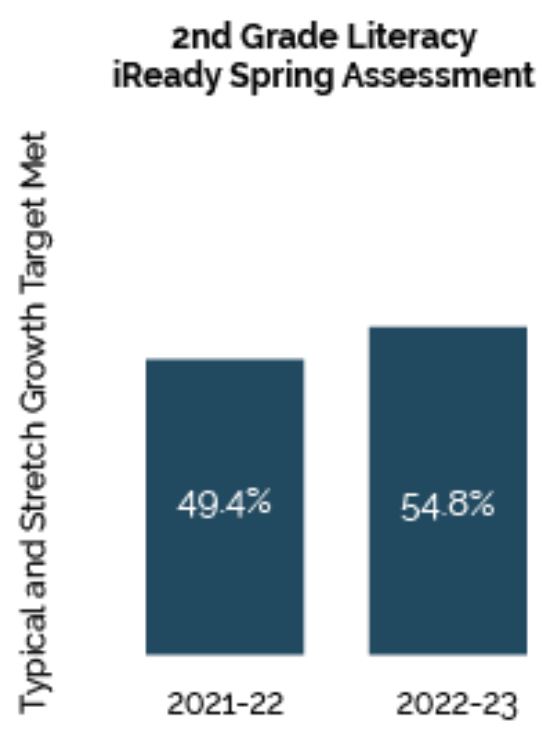
With OUSD’s continued focus on early literacy, student achievement continues to increase. As referenced in the graph, in comparison to last year, there are 5.4% more students who met their typical and stretch growth target in 2nd grade on their Spring iReady assessment.
With the focused goal of achieving continued student progress, OUSD will be rolling out a MTSS (Multi-Tiered System of Supports) Framework for the 23/24 school year. To ensure the effective implementation of the MTSS Framework, the collaborative efforts of multiple entities are being leveraged. Notably, the ACOE and the CCEE have joined forces to provide invaluable partnerships and support throughout the rollout process. Additionally, the dedicated Continuous School Improvement Team within OUSD is playing a pivotal role in guiding and overseeing the successful integration of the framework.
The rollout encompasses a comprehensive approach to educational improvement, offering two distinct paths towards advancement: targeted interventions and transformational strategies. The goal is a transformative educational experience for every student in every Oakland Unified school.
BACKGROUND
After the 2018-19 CA Dashboard Data Release, Oakland Unified School District (OUSD) became eligible and was referred in late 2019 by their County Office of Education to the CCEE for support via Education Code subdivision (g) of Section 52064.5. The student groups identified for OUSD are African American students, English Learners, and students experiencing homelessness. Since the completion of the Systemic Instructional Review (SIR) report, and in partnership with the Alameda County Office of Education (ACOE), the LEA has been engaging in cycles of continuous improvement. This update will focus on providing updates on the latest improvement cycle from August 2023 to November 2023.
DISTRICT AREAS OF FOCUS
The SIR Actions are organized in the themes of Coherence, Accountability, and Autonomy. The team at CCEE is working with the district’s focus areas of early literacy, A-G course access, graduation rate, middle school math, and joyous schools.
PROGRESS UPDATE
The district has intentionally shifted from a strategy of identifying a few schools for improvement to a district-wide commitment to improvement at schools.
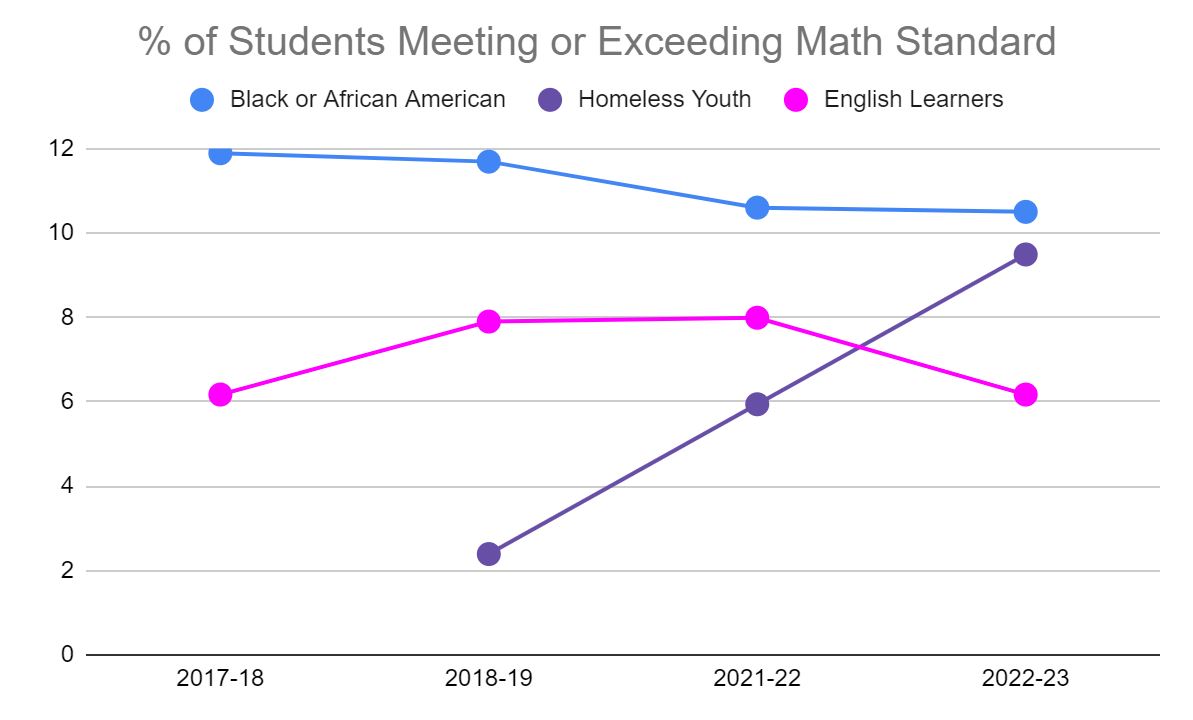
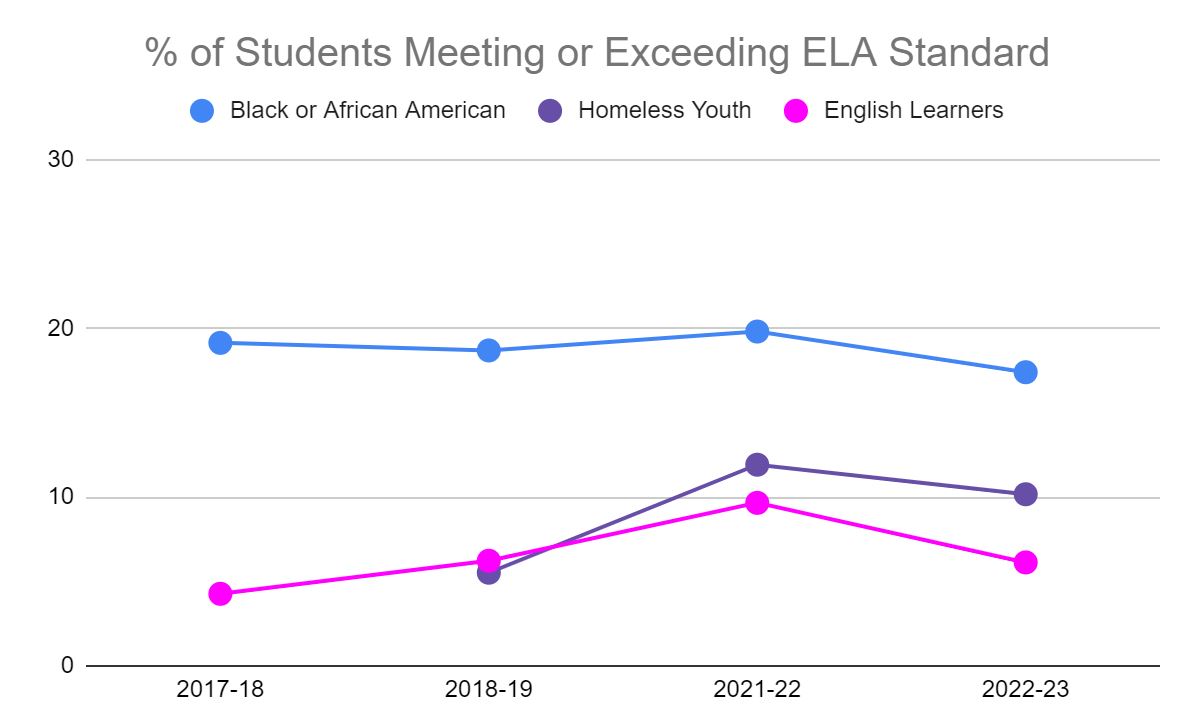
With the focused goal of achieving continued student progress, OUSD is developing an MTSS (Multi-Tiered System of Supports) Framework for this school year. The collaborative efforts of multiple entities are being leveraged to ensure the effective implementation of the MTSS Framework. Notably, the ACOE and the CCEE have joined forces to provide invaluable partnership and support throughout the rollout process.
Additionally, the dedicated Continuous School Improvement Team within OUSD is playing a pivotal role in guiding and overseeing the successful integration of the framework. Through this process, the district is identifying schools into two categories for improvement, either targeted or transformational. Targeted schools will have cycles of continuous improvement focused on targeted improvement areas. Transformational schools are focused on all improvement domains.
There is an opportunity for the districts and schools, through the support of the Network Superintendents, to work even closer on tight implementation of the framework.
The next steps are to continue to support OUSD by partnering with the teams in the district and at the Alameda County Office of Education, with school visits scheduled for February and our next quarterly convening that same month.
CCEE is not recommending further intervention by the Superintendent of Public Instruction.
BACKGROUND
After the 2018-19 CA Dashboard Data Release, Oakland Unified School District (OUSD) became eligible and was referred in late 2019 by their County Office of Education to the CCEE for support via Education Code subdivision (g) of Section 52064.5. The student groups identified for OUSD are African American students, English Learners, and students experiencing homelessness. Since the completion of the Systemic Instructional Review (SIR) report, and in partnership with the Alameda County Office of Education (ACOE), the LEA has been engaging in cycles of continuous improvement. This update will focus on providing updates on the latest improvement cycle from December 2023 to February 2024.
DISTRICT AREAS OF FOCUS
The SIR Actions are organized in the themes of Coherence, Accountability, and Autonomy. The team at CCEE is working with the district’s focus areas of early literacy, A-G course access, graduation rate, middle school math, and joyous schools.
PROGRESS UPDATE
Through the Spring of ‘23, Public Works LLC completed an audit in OUSD of the Continuous School Improvement team. The district contracted for this audit as part of their Sustainable Schools Redesign Process. The audit met with all CSI and Network Superintendent divisions. Overall the audit included 22 commendations and 46 recommendations. Included the themes of the report was the need for a restructure of the Continuous School Improvement Department, a need for increased accountability, and an increase in collaboration between the CSI division with the Network Superintendents. This increased collaboration will in turn reduce implementation gaps between what the CSI division is working on and schools.
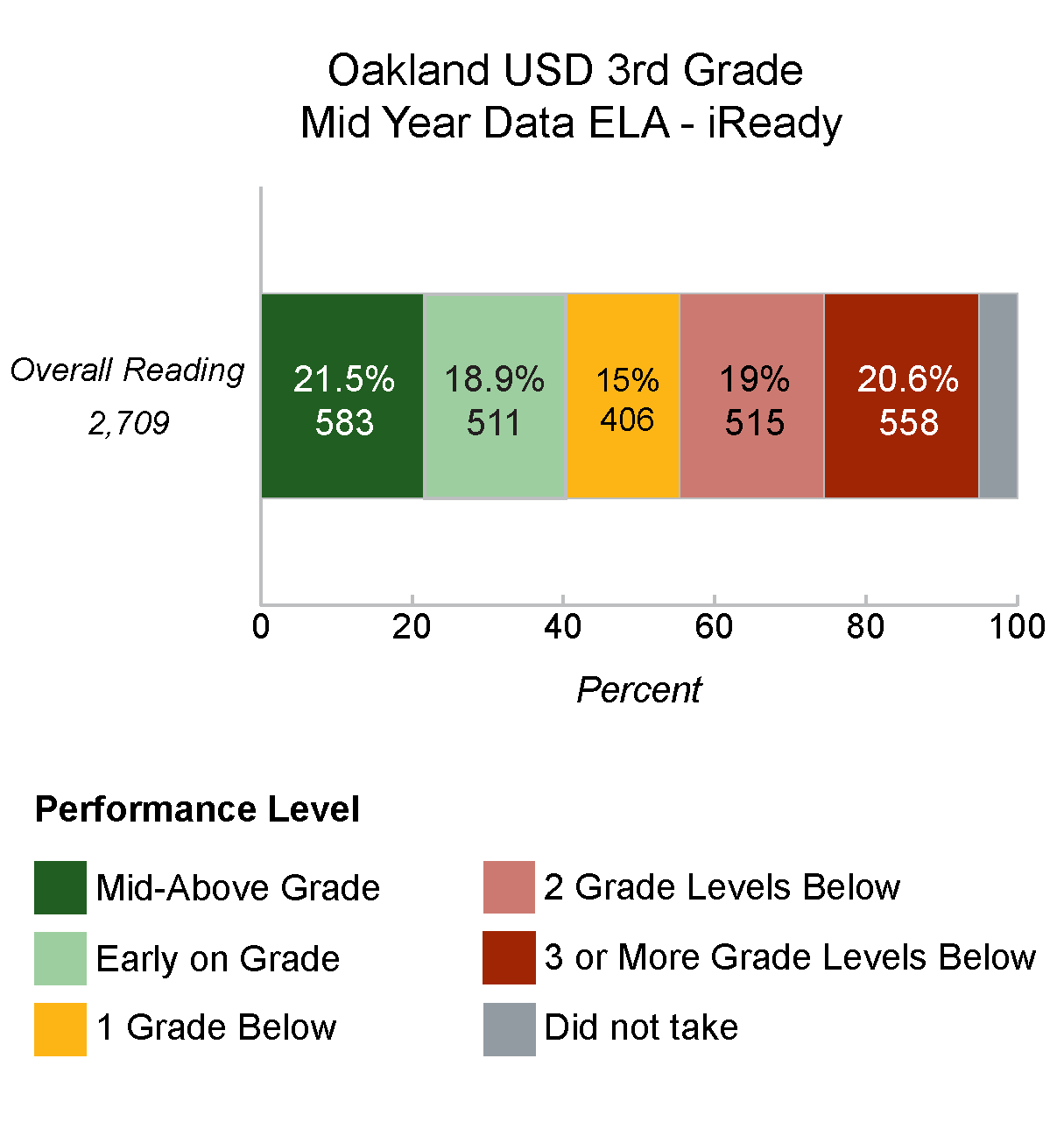
The Network Superintendent serves as the Principal Supervisor/Coach and is key for successful implementation, thus improvement. With all of that said, the Continuous School Improvement (CSI) teams are still focused on the district focus areas listed above; early literacy, A-G course access, graduation rate, middle school math, and joyous schools. The CCEE Team focused on these areas during classroom walkthroughs in mid-February. You can see the data set included here as a representation of the work on early literacy. With the recent adoption of new textbooks and an intentional focus on district office support through the CSI team, the data is trending in the right direction.
Looking ahead, CCEE is collaborating regularly with the team at the Alameda County Office of Education to continue supporting OUSD. Several convenings are scheduled for this spring to develop the support plan for the 2024-2025 academic year. CCEE is not recommending further intervention by the Superintendent of Public Instruction at this time.
Mt. Diablo Unified School District
BACKGROUND
Mt. Diablo USD became eligible for CCEE assistance in late 2019 after 2018-19 California School Dashboard data showed the district failed to meet state priority outcomes for a third year in a row. This year marked the third year for the CA Dashboard, which enacted Education Code subdivision (g) of Section 52064.5 (CA School Dashboard) for three or more pupil groups identified pursuant to Section 52052, in three out of four consecutive school years, the district is eligible for support from CCEE. The student groups for MDUSD are foster youth, students experiencing homelessness and African American. The table below indicates the student groups performance in comparison to the average statewide performance for that student group (the most recent year data are available).
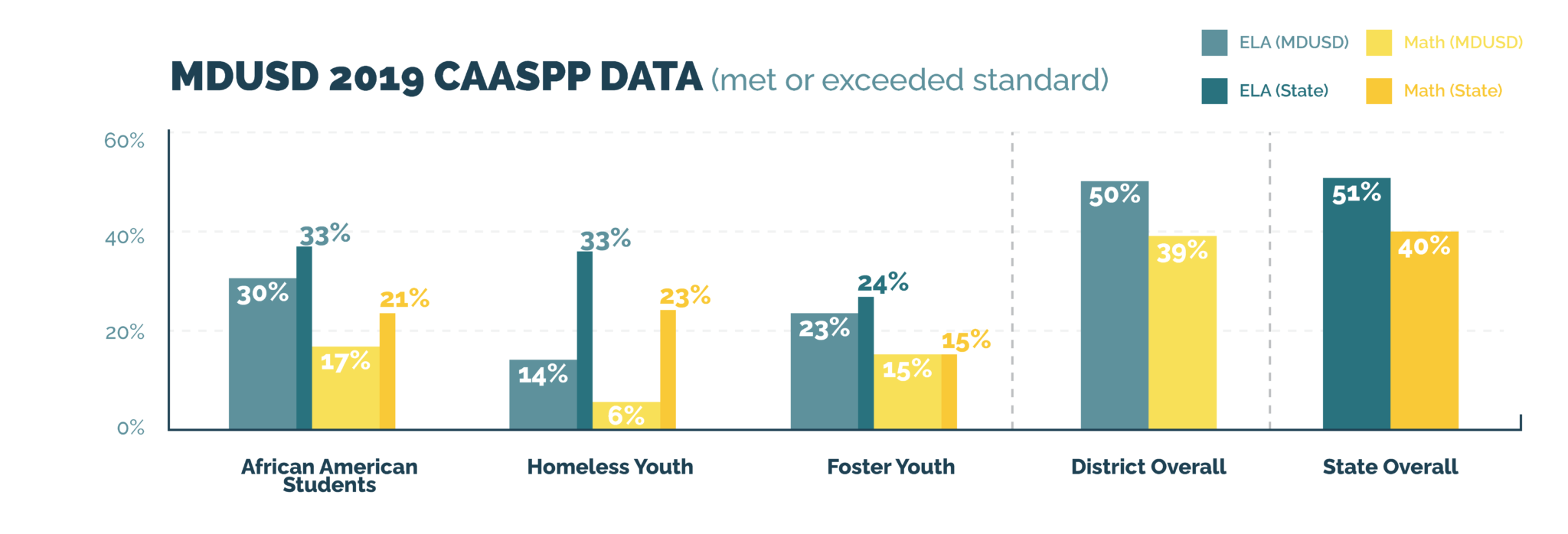
The graphic below shows the enrollment percentage of these student groups relative to the district’s entire student population.
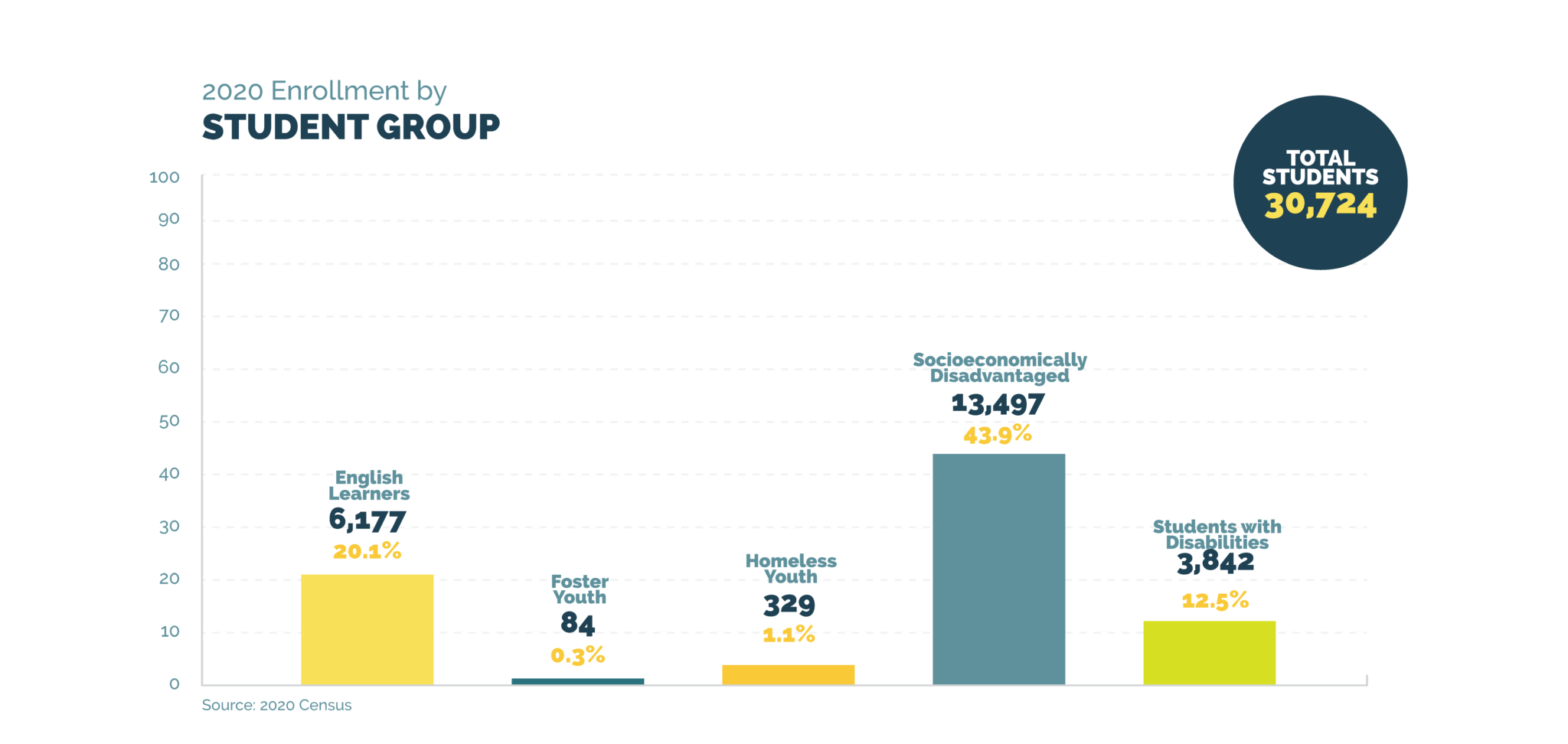
Mt. Diablo USD serves a diverse student population, with Hispanic students representing the largest portion of the student population, followed by White and Asian students, as reported on the CA Dashboard.

SYSTEMIC INSTRUCTIONAL REVIEW THEMES
The MDUSD SIR report and MDUSD SIR report executive summary was completed on March 31, 2021 and posted to the CCEE website. Four themes emerged as a result of data collection: 1) coherence, 2) equity, 3) accountability, and 4) autonomy
PROGRESS UPDATE
CCEE has met regularly with the MDUSD and Contra Costa County Office of Education teams to receive updates on their progress towards prioritizing SIR actions for their first cycle of improvement. CCEE has provided MDUSD leadership with tools and resources to engage in a prioritization process as well as tools to document their priority actions. CCEE has provided a part-time professional expert who engages regularly with MDUSD’s Chief of Educational Services on the process and to provide input and coaching to further narrow down the actions, identify the needed supports to successfully implement the SIR actions, and outline the progress monitoring cycle that they will engage in beginning Summer 2021. The MDUSD team has engaged in a prioritization process with a district team and initially identified 16 priority actions. Through coaching and guidance the team has further narrowed their priority actions to six, with a focus on the development and implementation of an instructional plan to guide the improvement work throughout the district.
NEXT STEPS
CCEE has advised MDUSD to create a clear action plan that highlights the SIR recommended actions that have been identified as focus areas for the upcoming cycle of improvement. In this plan we have advised that MDUSD identify the steps to achieving the action and the metrics that will be used to determine if progress and actions are met. We have also advised that this plan be communicated to all stakeholders to provide clarity on the direction and focus of the district. CCEE continues to work with the MDUSD and Contra Costa COE leadership teams to identify needed supports for the successful implementation of the prioritized SIR actions.
BACKGROUND
The Mt. Diablo Unified School District (MDUSD) became eligible and was referred in late 2019 by their County Office of Education to the CCEE for support via Education Code subdivision (g) of Section 52064.5 after the 2018-19 CA Dashboard Data Release. The focus student groups for MDUSD are Foster Youth, students experiencing homelessness and African American students. Since the completion of the SIR report the LEA has been engaging in cycles of continuous improvement. This update will focus on providing updates on the latest improvement cycle from August 2022 to November 2022.
DISTRICT AIM STATEMENT
The district aim is by June 30, 2023, all site principals will establish Instructional Leadership Teams (ILTs) with more than 50% of the ILT meeting focused on learning acceleration, standards-based assessment, and first best instructional strategies.
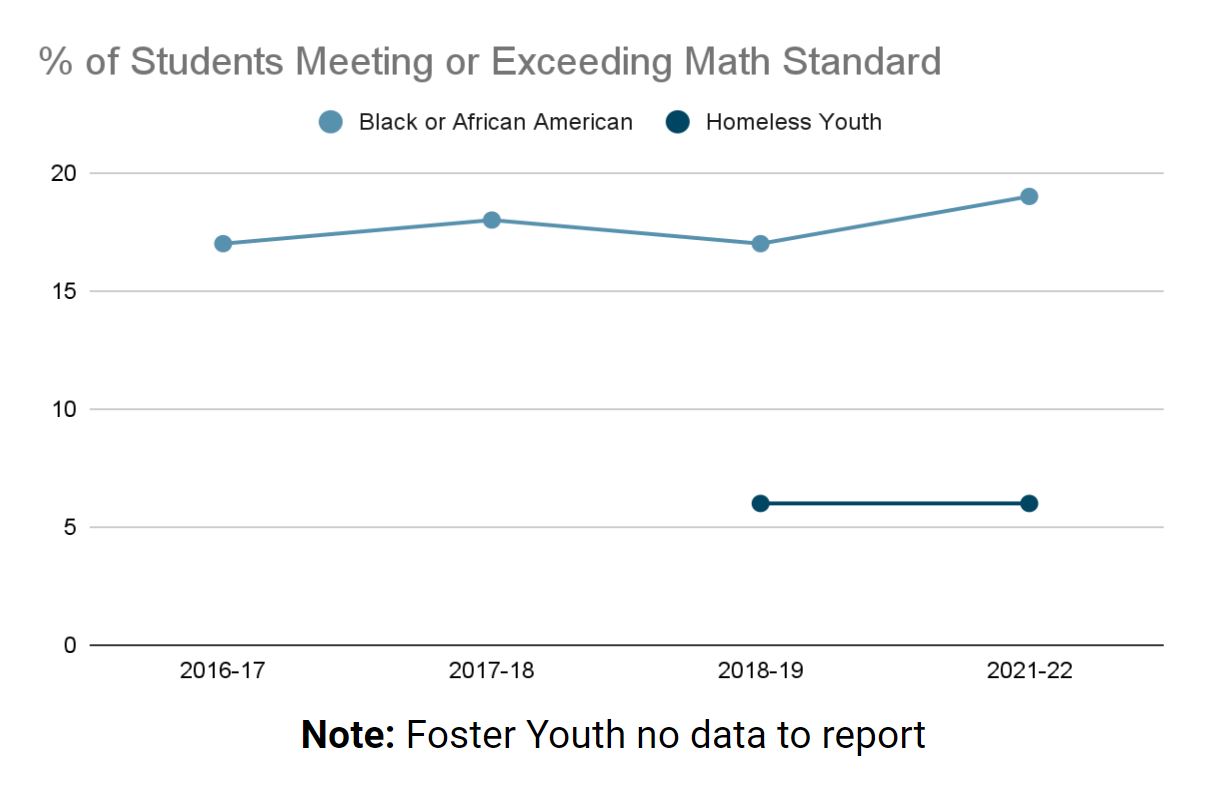
PROGRESS UPDATE
MDUSD is actively working to implement another 27 of the SIR actions. CCEE has been working in partnership/collaboration with district leadership and Contra Costa County Office of Education to engage in a continuous cycle of improvement.
In this update, the MDUSD progressed in measuring the implementation and use of standards that are focus areas and the active development of site leaders in the area of instructional leadership to engage with staff.
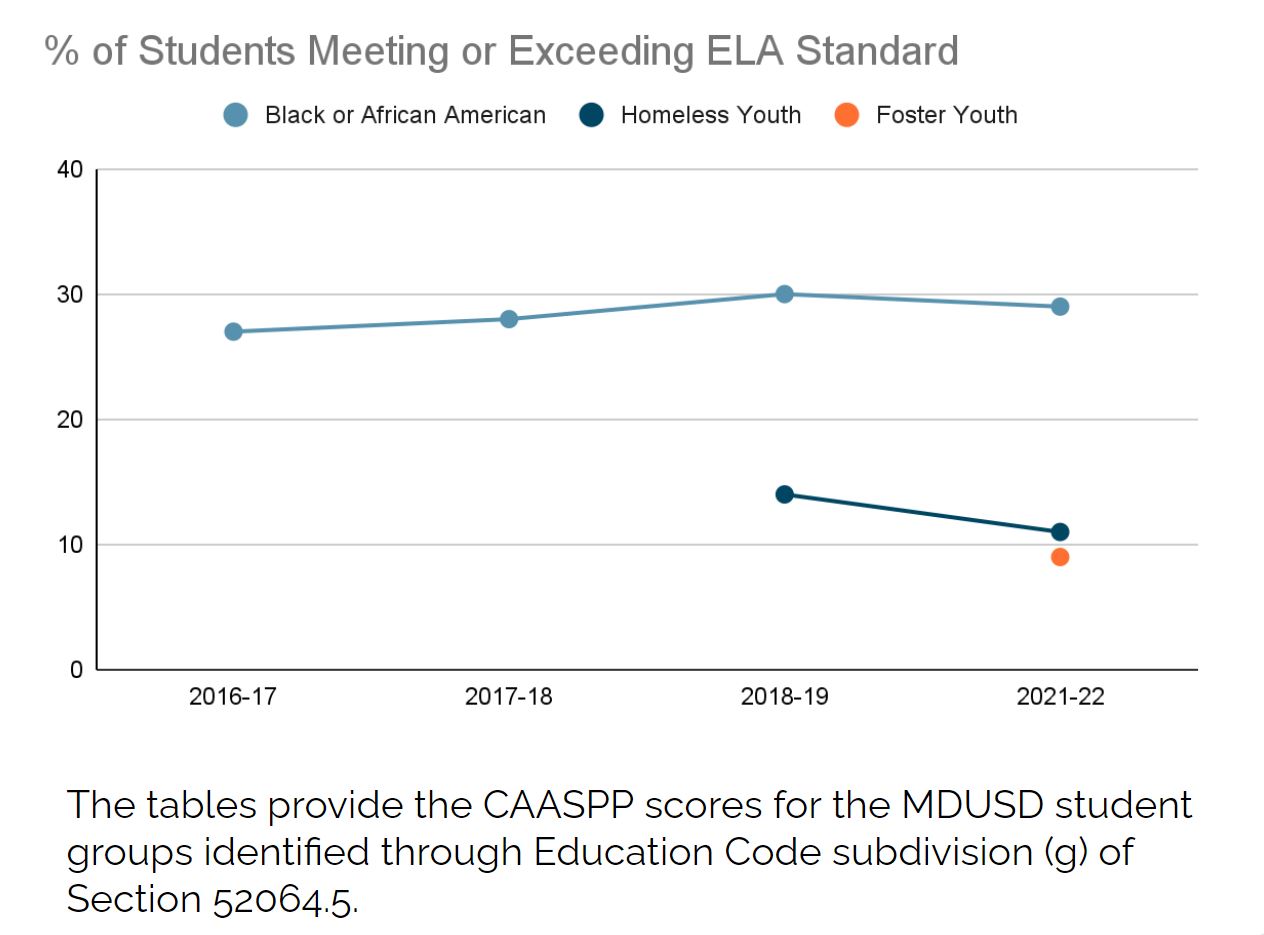
The MDUSD focus is improving how the local assessment data can be more effectively used by school sites to monitor student progress and inform instruction. Protocols for data analysis were modeled by CCEE staff for the District Leadership Team, and we also facilitated a conversation about the formative assessment calendar and priority standards/scope and sequence.
The District Leadership Team are actively building coherence across the district, and ensuring support for instructional leadership at the site level. The continued professional learning on Mathematics instruction is an opportunity to deepen the trust between school sites and the district office. As a result, district leadership is deepening their understanding about high quality first instruction.
Next steps include an analysis of the most recent benchmark data and development of professional development that aligns to the assessment data and to bring together a committee to refine the scope and sequence and ensure realignment of the benchmark assessments.
BACKGROUND
The Mt. Diablo Unified School District (MDUSD) became eligible and was referred in late 2019 by their County Office of Education to the CCEE for support via Education Code subdivision (g) of Section 52064.5 after the 2018-19 CA Dashboard Data Release. The focus student groups for MDUSD are Foster Youth, students experiencing homelessness and African American students. Since the completion of the SIR report the LEA has been engaging in cycles of continuous improvement. This update will focus on providing updates on the latest improvement cycle from December 2022 to February 2023.
DISTRICT AIM STATEMENT
The district aim is by June 30, 2023, all site principals will establish Instructional Leadership Teams (ILTs) with more than 50% of the ILT meeting focused on learning acceleration, standards-based assessment, and first best instructional strategies.
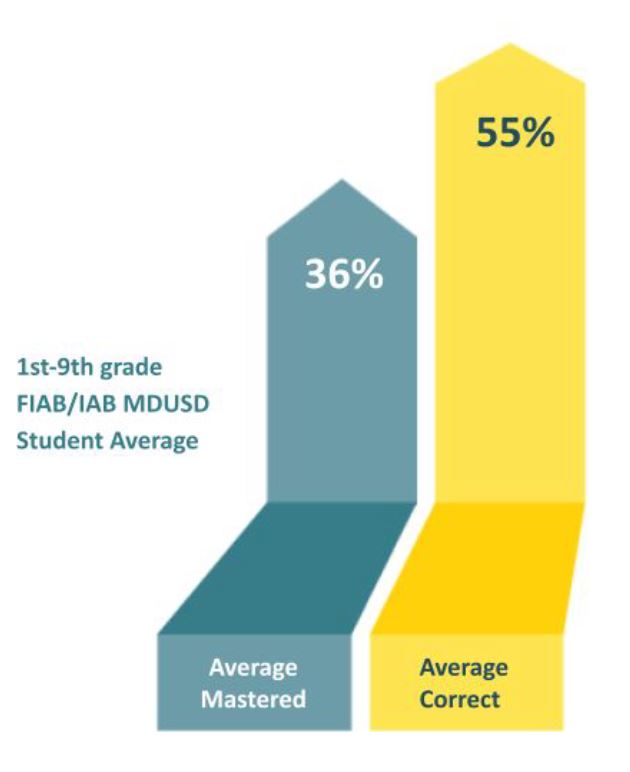
PROGRESS UPDATE
MDUSD is actively working to implement another 27 of the SIR actions. CCEE has been working in partnership/collaboration with district leadership and Contra Costa County Office of Education to engage in a continuous cycle of improvement.
In this cycle, MDUSD has made progress in identifying priority standards in the area of Math in the elementary and middle school space. They began re-examining benchmark assessments and developing an assessment that will align with the standards identified as priorities, along with the scope and sequence.
MDUSD leadership analyzed Winter benchmark data of their i-Ready and Interim Assessment Block/Formative Interim Assessment Block (IAB/FIAB) assessments. It used the information gleaned to develop a cycle of inquiry using 6 sites as pilot sites to test their theory of action around building mathematical proficiency.
There is a clear focus on Mathematics instruction in TK-8 supported by TNTP. The district leadership team is beginning to analyze data and make decisions to develop theories of action for improvement. Teachers actively participate in standards re-alignment and updated scope and sequence alignment to district benchmark assessments.
There is an opportunity to deepen the understanding of assessments, when and how to use them for improved student outcomes so that staff can engage more robustly and collaboratively in using Plan-Do-Study-Act to support teaching and learning improvement efforts.
CCEE will continue to provide support, guidance, and coaching to the MDUSD leadership team through cycles of inquiry grounded in their benchmark data to better understand their students’ needs as well as the needs of the system. This will build internal capacity to engage in and support inquiry cycles within the district and at the site and classroom levels to be more responsive to student’s needs and achieve higher levels of student learning.
BACKGROUND
The Mt. Diablo Unified School District (MDUSD) became eligible and was referred in late 2019 by their County Office of Education to the CCEE for support via Education Code subdivision (g) of Section 52064.5 after the 2018-19 CA Dashboard Data Release. The focus student groups for MDUSD are Foster Youth, students experiencing homelessness and African American students. Since the completion of the SIR report the LEA has been engaging in cycles of continuous improvement. This update will focus on providing updates on the latest improvement cycle from March 2023 to May 2023.
DISTRICT AREAS OF FOCUS
The district aim is by June 30, 2023, all site principals will establish Instructional Leadership Teams (ILTs) with more than 50% of the ILT meeting focused on learning acceleration, standards-based assessment, and first best instructional strategies.
PROGRESS UPDATE
CCEE has been working in partnership/collaboration with district leadership and Contra Costa County Office of Education to engage in a continuous cycle of improvement. In this quarter MDUSD engaged in a cycle of inquiry based on a theory of action around providing just in time scaffolds to targeted students in Mathematics. The MDUSD team also spent considerable time planning for next year and agreeing upon the focus area continuing around Math and extended into literacy at the primary grades.
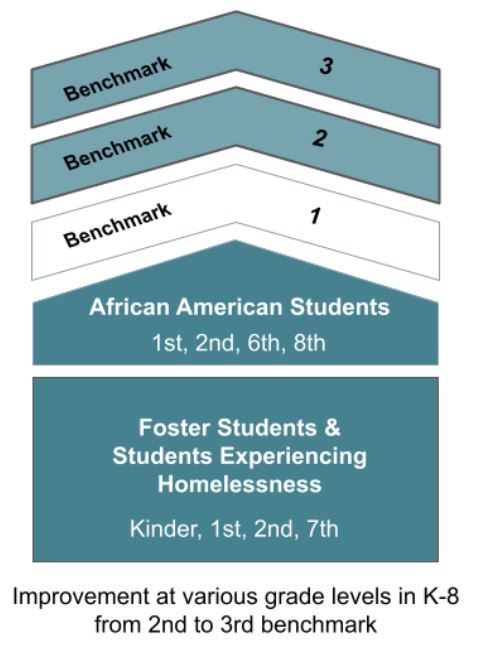
Within their most recent cycle of inquiry the elementary sites that participated as pilot sites saw greater greater growth in their students who received supports than those who were not targeted. The assessment calendar and the assessments have been revised to more accurately align with the newly identified priority standards.
The team engaged in deep reflection around their inquiry cycle and their inquiry processes. There are opportunities to build and deepen the inquiry process within the system to better understand causal links between intervention and outcomes. There is an opportunity to deeply connect all the goals and initiatives throughout the district to help the every level of the system identify needs and deploy resources and supports as needed so that each school and each student gets what they need and has more positive outcomes.
The team will engage in an end of year reflection using the Fullan & Quinn’s (2016) Coherence Progression Protocol. This tool will be used to document progress and growth throughout this school year and as a road map to plan for the upcoming school year. The current reality can be used as an opportunity to strengthen distributive leadership and strengthen each level of the system to work collaboratively and collectively to improve the function of the system so that student outcomes are impacted positively.
BACKGROUND
The Mt. Diablo Unified School District (MDUSD) became eligible and was referred in late 2019 by their County Office of Education to the CCEE for support via Education Code subdivision (g) of Section 52064.5 after the 2018-19 CA Dashboard Data Release. The focus student groups for MDUSD are Foster Youth, students experiencing homelessness, and African American students. Since the completion of the SIR report, the LEA has been engaging in cycles of continuous improvement. This update will focus on providing updates on the latest improvement cycle from to November 2023.
DISTRICT AREAS OF FOCUS
This school year, MDUSD continues to focus its improvement efforts in the area of mathematics instruction in K-8. They are centering their work around building the capacity of site leaders and teacher leaders to improve math instruction and lead the work for others at their sites.
PROGRESS UPDATE
MDUSD continues its focus on math instruction. The focus is from kindergarten to 8th grade. MDUSD is in partnership with TNTP to facilitate Instructional Leadership Teams with the aim of building the capacity of site leaders and teacher leaders to lead improvement efforts around math back at their respective sites. Teachers are beginning to participate in classroom walkthroughs to examine the implementation of “Building Thinking Classrooms” structures and practices across the system. MDUSD is also working to strengthen and deepen district support for the work and the role of Ed. Services in the improvement efforts. MDUSD is very focused on its improvement efforts. They continually refine their work but maintain the focus on mathematics instruction. They are simultaneously working to address the larger system around instruction and defining and refining instruction across the system. There is a targeted effort to build leadership capacity at every level of the system.
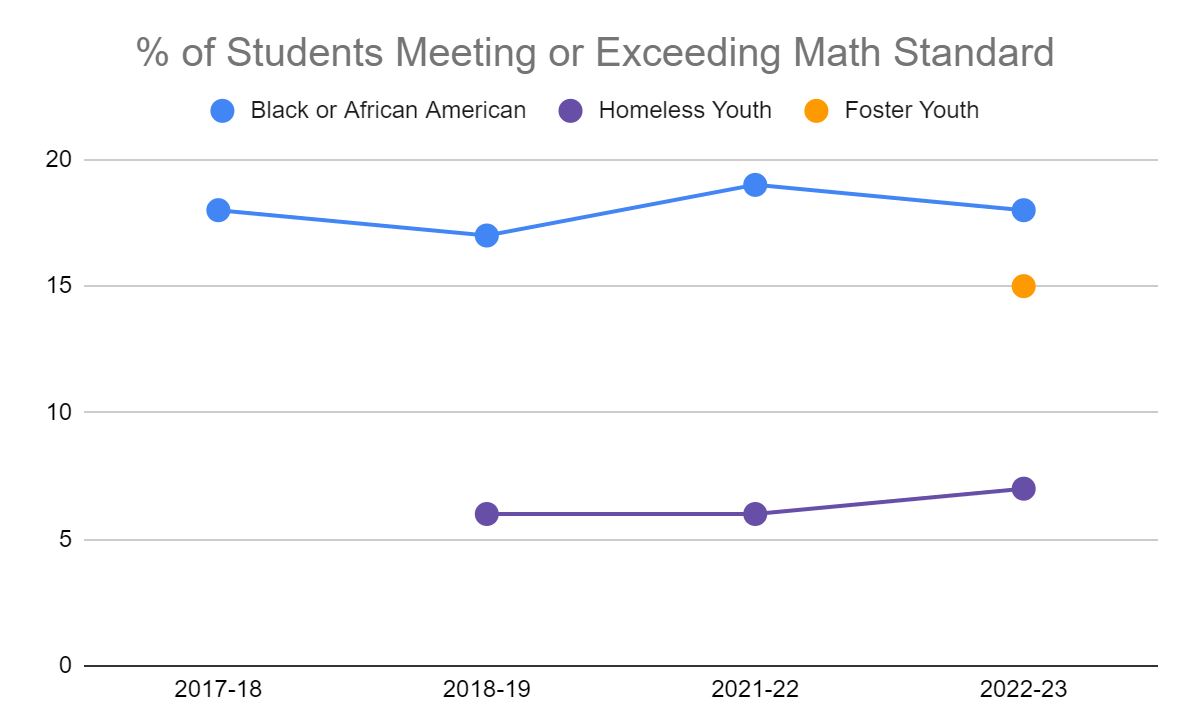

As the team continues its improvement efforts there are opportunities to connect the work to student learning outcomes more strongly. While the focus has been on changing teacher instruction, strengthening the connection between teaching and learning would further the work and ensure that students have equitable access to grade-level standards and instruction and are also mastering grade-level standards.
CCEE is facilitating a District Leadership Team meeting later this month. This will be an opportunity for the team to triangulate quantitative and qualitative data around math and begin to understand how they can contribute from their respective place in the system to advance and further the work for teachers and students and the system as a whole.
CCEE is not recommending further intervention by the Superintendent of Public Instruction.
BACKGROUND
The Mt. Diablo Unified School District (MDUSD) became eligible and was referred in late 2019 by their County Office of Education to the CCEE for support via Education Code subdivision (g) of Section 52064.5 after the 2018-19 CA Dashboard Data Release. The focus student groups for MDUSD are Foster Youth, students experiencing homelessness African American students and Students with Disabilities. Since the completion of the SIR report the LEA has been engaging in cycles of continuous improvement. This update will focus on providing updates on the latest improvement cycle from December 2023 to February 2024.
DISTRICT AREAS OF FOCUS
MDUSD continues to focus its improvement efforts in the area of Mathematics instruction in K-8. CCEE facilitated two data discussion meetings with the District Leadership Team (DLT) this quarter.
PROGRESS UPDATE
In the December 2023 District Leadership Team (DLT) meeting, CCEE facilitated a discussion involving teachers, principals, and administrators to analyze Mathematics data. It became evident from this session that the district needed to establish a common understanding of the desired student learning outcomes before staff could effectively engage in Plan-Do-Study-Act (PDSA) cycles with meaningful data. The absence of a shared approach to discussing assessment conversation on district benchmark data. However, the focus shifted towards a fundamental discussion of the assessment system and its effectiveness. Consequently, the district will conduct an inventory of its assessment system over the next few months and work towards establishing a common measurement for the 2024-2025 academic year. CCEE will provide coaching to the Data and Assessment Director to foster a data-driven culture and streamline the number of assessments.
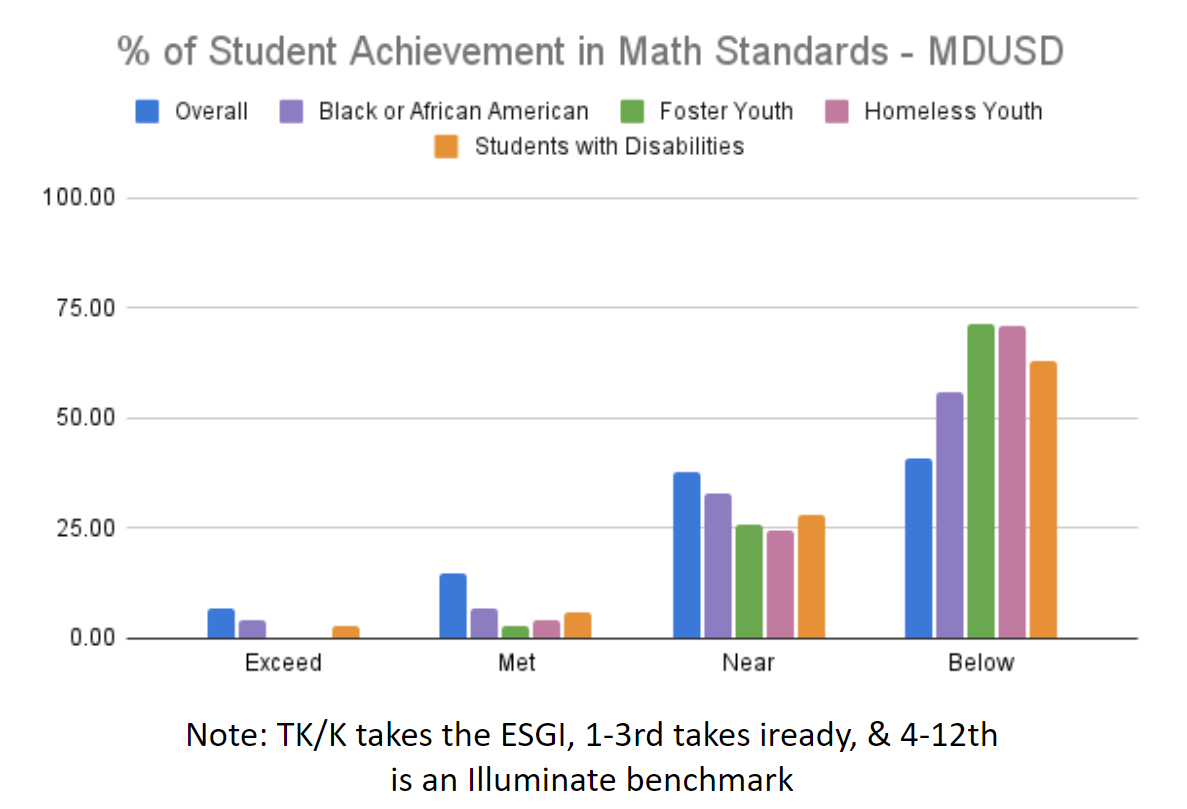
During the first district benchmark assessment for Mathematics, overall performance showed improvement compared to the baseline assessment at the beginning of the year. There was an 11% increase in students meeting or exceeding standards, a 9% increase in students nearing the standard, and a 19% decrease in the percentage of students falling below the standard. As efforts to support Mathematics education deepen, there are significant opportunities to enhance alignment and coherence across classrooms. It is crucial to assess the impact of changes in instructional practices on student outcomes. Moreover, there is a need to enhance understanding of the district assessment system, promote the use of common formative assessments, and reinforce assessment practices at the teacher level.
CCEE will continue collaborating with MDUSD to fully align assessments for the 2024-2025 academic year and anticipate future DLT meetings. The CCEE Data Research Learning Network (DRLN) will provide additional support to the Director of Data and Assessment in cultivating a data-driven culture. The DLT will reconvene in May 2024 to engage in the annual Coherence Progression Protocol, assess annual progress, and develop strategies accordingly. CCEE is not recommending further intervention by the Superintendent of Public Instruction at this time.
Lakeport Unified School District
BACKGROUND
The Lakeport Unified School District (LUSD) became eligible and was referred in March 2023 by their County Office of Education to the CCEE for support via Education Code subdivision (g) of Section 52072 after the 2021-22 CA Dashboard Data Release. The focus student groups for LUSD are American Indian, Hispanic, students experiencing homelessness, Socioeconomically Disadvantaged, and students with disabilities. This update will focus on providing updates on the latest Direct Technical Assistance from August 2023 to November 2023.
DISTRICT AREAS OF FOCUS
As the Superintendent of Lakeport Unified enters his third year and after spending time developing and aligning the district’s strategic plan and LCAP to student needs, the district is focused on early literacy, chronic absenteeism, and mental health.
PROGRESS UPDATE
The district was intentional throughout the hiring season to do its best in making sure to maximize staffing for the start of the year. They had a lot of success, which allowed them to continue supporting professional development for LETRS for most K-3 teachers. Also, being properly staffed allowed them to kick off an attendance initiative, which has resulted in an increase of 5.2% in overall attendance thus far this year. Also, the Lake County Office of Education is contributing funding for a 1.0 FTE focussed on student mental health.
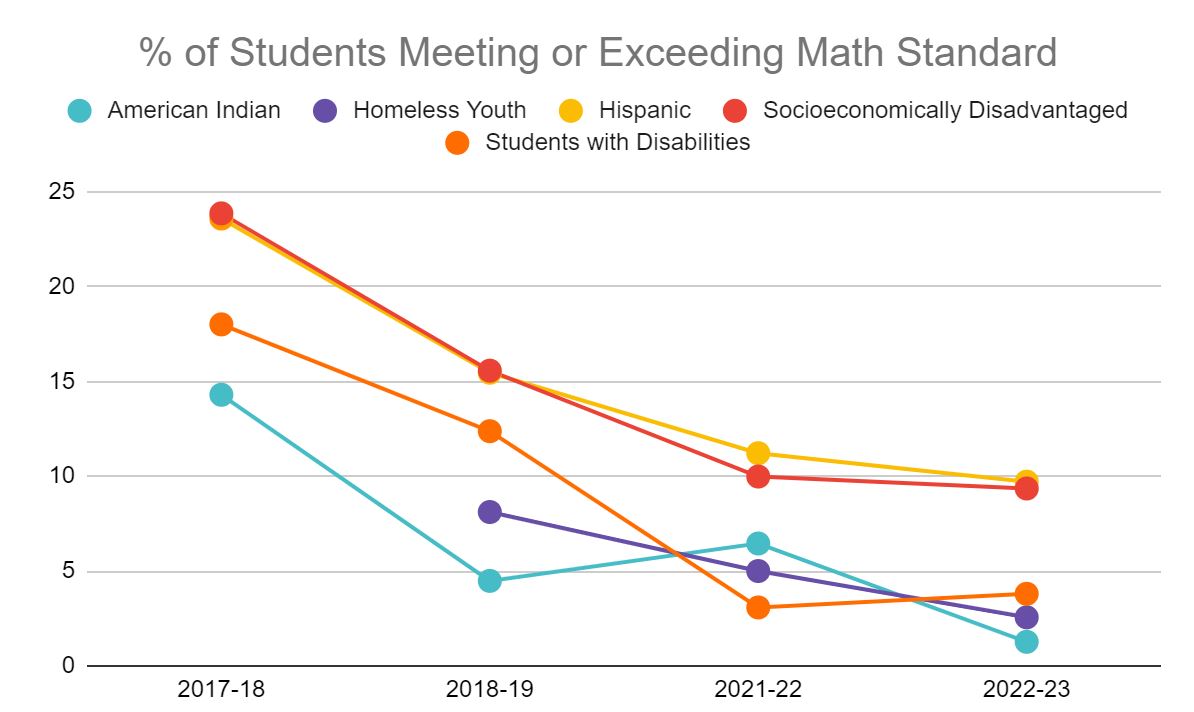

The Superintendent and the leadership team are actively championing the adoption of a new curriculum, coupled with targeted professional development that aligns with its implementation. Concurrently, efforts are underway to enhance the quality and utilization of local assessments, all in support of the district’s primary focus on early literacy.
The district leadership, county office, and CCEE are collaboratively engaged in fortifying curriculum and instructional support through coaching for teachers. The initial focus of CCEE has been on intricately aligning the district’s LCAP, Strategic Plan, and Superintendent Priorities into a dynamic working document. This document empowers the small district office staff to monitor progress and make timely adjustments for continual improvement actively.
Looking ahead, the CCEE team is scheduled to visit classrooms and engage with leaders in late January. This experiential learning will be crucial in bolstering the team’s efforts to amplify the district’s LCAP, strategic plan, and Superintendent priorities.
CCEE is not recommending further intervention by the Superintendent of Public Instruction.
BACKGROUND
The Lakeport Unified School District (LUSD) became eligible and was referred in March 2023 by their County Office of Education to the CCEE for support via Education Code subdivision (g) of Section 52072 after the 2021-22 CA Dashboard Data Release. The focus student groups for LUSD are American Indian, Hispanic, students experiencing homelessness, Socioeconomically Disadvantaged, and students with disabilities. This update will focus on providing updates on the latest Direct Technical Assistance from December 2023 to February 2024.
DISTRICT AREAS OF FOCUS
In our cooperative facilitation with the Lakeport team, we are working on a crosswalk of the Superintendent’s Priorities, the Strategic Plan and the LCAP. Focused on the areas of Early Literacy, Chronic Absenteeism and Mental Health. Targeting support for the student groups identified for Direct Technical Assistance.
PROGRESS UPDATE
Lakeport Unified strategically has focused on reducing chronic absenteeism from the start of the 23-24 school year. The district has been intentional with supports and incentives to increase overall attendance and in turn reduce chronic absenteeism. The district is focusing on chronic absenteeism as a high leverage activity. The leadership team knows the more students are on their campuses the more access they will have to instruction and any needed mental health supports.
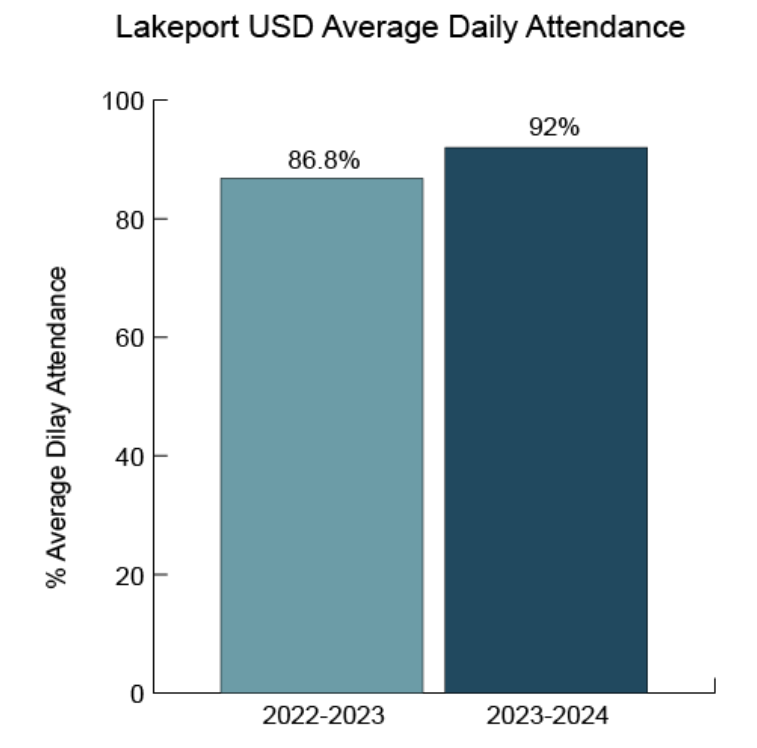
The efforts with developing attendance teams, working with local businesses for incentives and designing local incentives for students is paying off seeing a 5% increase (see bar graph) in overall attendance thus far this year. The attendance teams continue to work with students and families who are chronically absent. These direct contacts have helped reduce the number of absences for the most chronically absent.
With all of the positive momentum from the districts local actions, the district leadership team, county office, and CCEE continue to work collaboratively on developing a crosswalk document. The CCEE team visited Lakeport Unified to walk through schools in late January. The crosswalk document was further informed by those walkthroughs. Also, the LUSD Leadership team is working on developing aspirational “outcomes” for the next few years to include in the finished product.
Looking ahead, Families in Schools will be in the community conducting Focus Interviews with students, staff and families in April. This information will be yet another information source to include in the crosswalk document. Also, the CCEE team will be on site in mid-April to work with the LUSD Leadership Team on goal setting based on the outcomes selected for their priority areas of Early Literacy, Chronic Absenteeism and Mental Health. CCEE is not recommending further intervention by the Superintendent of Public Instruction at this time.
For questions, please contact [email protected]